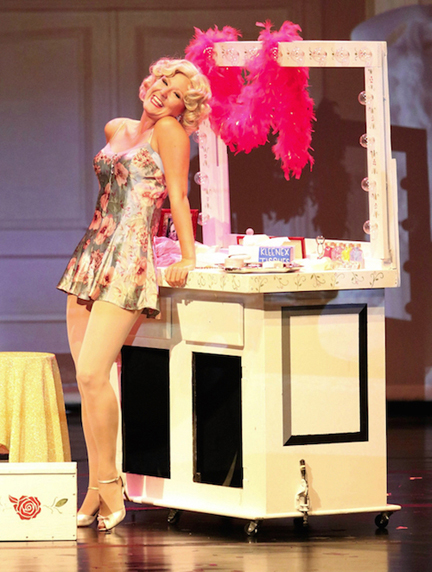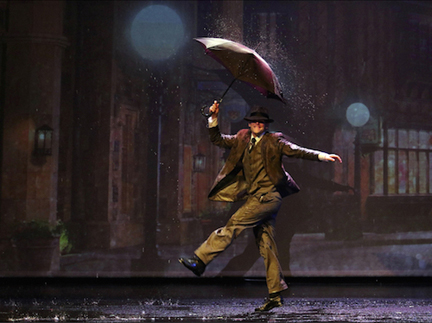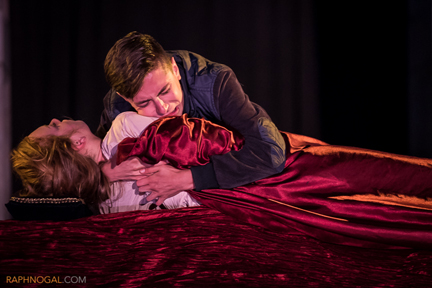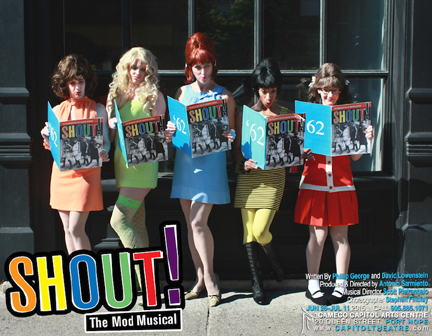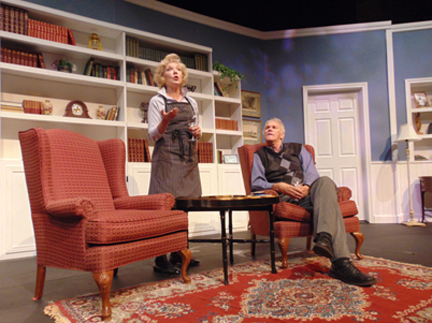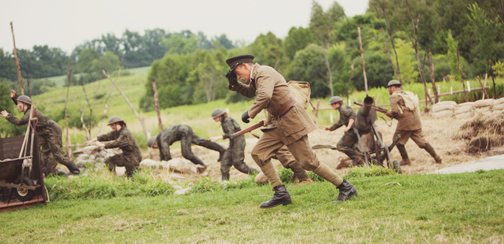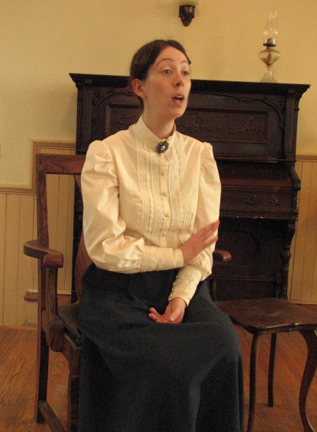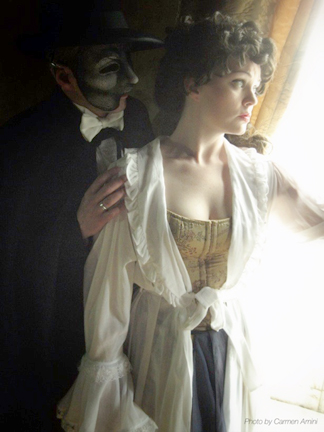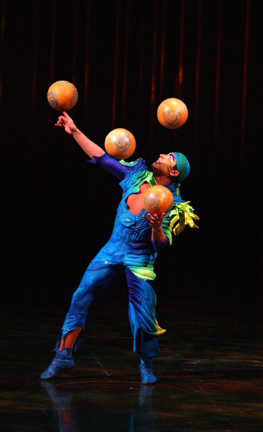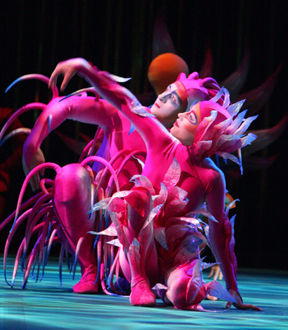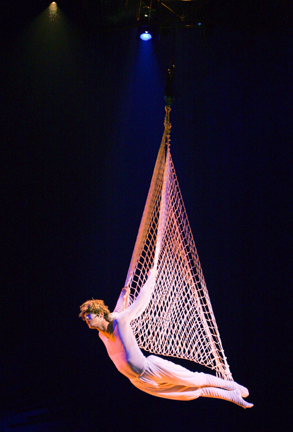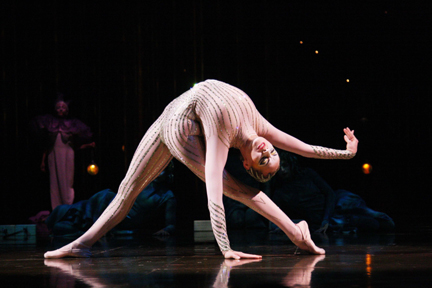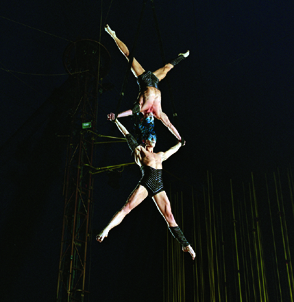“Onion Skins & Peach Fuzz: The Farmerettes”
© Reviewed by John Arkelian
How nice it was to be back at 4th Line Theater after a long pandemic-induced hiatus. Quite apart from the charming novelty of staging its plays outdoors on a grassy lawn beside two barns, the thing that keeps drawing us back is 4th Line’s inimitable way of creating highly original drama out of the too-often forgotten history of our country and the region (Cavan Township) where its farm venue is situated. The plays presented at 4th Line

The cast of 4th Line Theater’s “Onion Skins & Peach Fuzz: The Farmerettes” — photo by Wayne Eardley (Brookside Studio)
cover the gamut in subject and tone. Grist for their playwriters’ mills has included such topics as bitter sectarian conflict among early Irish immigrants, traveling country fairs, and once ubiquitous one-room schools. 4th Line’s opening play for the Summer of 2024 is no exception. “Onion Skins & Peach Fuzz: The Farmerettes“ is an instantly accessible narrative plunge into overlooked Canadiana, telling the story of the girls and young women who volunteered to work on Canadian farms in the 1940’s, bringing in the proverbial harvest while their male counterparts are away to war.
The ensemble of six young actresses is very well cast: Rebecca Birrell, Aimée Gordon, Reena Goze, Megan Murphy, Carina Sălăjan, and Alicia Salvador each create distinct and engaging characters, with most of them playing more than one role — including, where called for, male ones. A prevailing tone of gentle lighthearted nostalgia prevails from the get-go: the play starts off with “I’ll Be Seeing You” from the house band. A new batch of recruits, most of them new to farming, learn the ropes of that tough work and develop friendships along the way. Their camaraderie is often comedic, as is their speculation about a noticeably accented co-worker: “If she’s not French, then what is she?” asks one. “Mean,” replies another. Sălăjan brings the laughs as the tougher-skinned object of their gossip. Another of their number, the small but spunky Dot (played by Murphy) is there with her older sister, having inflated her own tender age to qualify for the program. Thirteen weeks of service earns them credit for one school year; but their real motivator is the impulse for adventure. In the second act, the cast portray mostly different characters, including a pair of Japanese-Canadian sisters who have suffered injustice due to their perceived ethnicity. That’s a sober social justice ingredient in a mostly effervescent concoction, with its overlapping coming of age stories told with warmth, affection, and humor.
Adapted from the book by Bonnie Sitter & Shirleyan English, the play was written by Alison Lawrence, who describes its characters as venturing outside their accustomed comfort zones. The trick, says the playwright was to turn “a great collection of essays and letters and photos and memories” into a narrative play. (Her work was supported by ‘dramatugy’ by Kim Blackwell & Severn Thompson.) The result is an entertaining, feel-good combination of “war story on the home front and a piece of women’s history,” directed by Autumn Smith with musical direction by 4th Line’s in-house composer and band conductor Justin Hiscox. It’s vital and energetic, funny and fun, and winningly authentic all at the same time.
John Arkelian is an award-winning journalist and author.
Copyright © 2024 by John Arkelian.
Editor’s Note: 4th Line Theater’s second production of the summer, “Jim Watts: Girl Reporter,” runs July 30 through August 24, 2024. 4th Line Theater is situated on the Winslow Farm, 779 Zion Line, just outside the picturesque village of Millbrook, Ontario. For more information and tickets, call 1-800-814-0055, or visit http://4thlinetheatre.on.ca/
*****************************************************
Primer: an audio drama
© Reviewed by John Arkelian
***1/2 stars (out of five)
Sometimes the experience of a trauma can galvanize us into reexamining our assumptions and expectations. So it is in “Primer,” the new audio drama from Chicago’s Broken Nose Theatre, which takes place in the immediate aftermath of urban looting. A street demonstration, sparked by an incident of police violence, turned ugly the night before. But, instead of taking place in a down-on-its-luck district, it has happened on Chicago’s upscale commercial avenue, its proud ‘Magnificent Mile.’ As someone observes, “It’s weird when it hits a place you know.” The juxtaposition of wanton destruction and a temple to consumerism is an unsettling one for the several people who assemble in the ruins of a grand old department store on the day after to take literal and figurative stock.
Written by Spenser Davis and directed by Brittney Brown, “Primer” uses humor and a hint of satire to question society’s priorities. Separate scenes combine different groupings of its eight disparate characters for everyday chatter amidst the rubble. Like people everywhere, their concerns often run to the mundane and banal. The vacuous banter between some breathlessly bubble-headed Valley-Girl wannabes (“ab-sa-freaking-lutely”) is played for laughs; but, the macrocosm is never far from the surface. Maybe that’s part of the point: no matter how self-absorbed, and even inane, we tend to be in our quotidian existence, there comes a time when we can’t ignore bigger, more serious things. Here, those things pivot on racial and social equity.
There’s a nice moment of irony when a white policewoman laments to a black male friend that, “You can’t imagine what it’s like for someone to make assumptions about you the moment you enter the room.” The same scene makes a good point about how much in life turns on our subjective point of view. She protests, “I didn’t do anything wrong. I’m not a bad cop.” His rejoinder is, simply, “But you’re wearing the same clothing as one. My people are dying — and your people are why.” It’s a fair observation and a tangible expression of competing perspectives. However, a recurring sentiment, expressed elsewhere, seems inappropriately inclined to excuse or rationalize looting. One character proffers that, “I guess this is them doing something about it.” Another suggests that, “This is actually us trying to build something new.” It’s a moral, philosophical, and legal bridge way too far to characterize the destruction of other peoples’ property as positive, constructive action. Peaceful protest qualifies as such, certainly; but looting and rioting emphatically do not.
The chief spokesperson here for social conscience is the department store’s first floor manager: she reigns over its cornucopia of cosmetics, jewellery, and fragrances. The wreck of her wares has her fired up about the perceived root causes of the trouble: “It takes what happened last night for our company to even begin to care.” For Mary, people, not property, ought to be what counts. She is briefly assuaged by signs that her corporate retail employer may be taking a belated interest in social justice. But her patience snaps when it becomes clear that the corporate emissary’s real brief is to advance the case for “[keeping] your workplace intact during high intensity scenarios” with “‘biz-shield’… a nearly indestructible pseudo-plastic.” It’s the final straw for Mary: “I don’t even want to return to before.” She enlists allies, and the play ends with a question, a question which it behooves all of us to consider as we look beyond our own mundane concerns to survey the bigger picture: “So, now what?”
“Primer” benefits from a solid cast: RjW Mays is a standout as Mary. And she is ably matched by the rest of the ensemble: JD Caudill, Ana Szalai-Raymond, Kim Boler, E.M. Davis, Brenda Scott Wlazlo, Watson Swift, and David Weiss. The play’s comedic tone and entertaining cast of characters draws us in , as it surveys bigger social questions from the point of view of ordinary, everyday people. Tony Ingram’s sound design helps conjure the setting.
Content advisory: Abundant very coarse language and adult subject matter.
Copyright © 2021 by John Arkelian
Editor’s Notes:
The foregoing review first appeared in “About the Town Chicago.”
The audio drama “Primer” is available online for streaming-on-demand from November 15 through December 5, 2021. It is about 85 minutes long. Tickets can be purchased on a ‘pay what you can’ basis at: https://brokennosetheatre.com/p-audio
*****************************************************
Carmilla: An Audio Drama
© By John Arkelian
**1/2 stars (out of five)
Chicago’s Lifeline Theatre has a new take on the classic vampire story “Carmilla,” which is available online as a three-part audio drama, adapted by Aly Renee Amidel and directed by Scott Cummins.
Published in 1872, “Carmilla” is one of the most skillfully crafted vampire tales ever written. Irish writer J. Sheridan LeFanu’s novella exudes a tension which is at once supernatural and sexual: “I experienced a strange tumultuous excitement that was pleasurable… mingled with a vague sense of fear and disgust… I was conscious of a love growing into adoration, and also of abhorrence.” When he wrote the now much better known “Dracula” 25 years later, Bram Stoker also made liberal use of muted eroticism. In his novel, too, the vampire’s victims often display an ambivalent reaction to their assailants. As literary critic James Twitchell has pointed out, the modern vampire, as reinterpreted for us by the Romantics, “is not only interested in blood, he is interested in the process of seduction and forbidden possession… And what ‘evil’ he does is strangely attractive to his victims.”
At its heart, the original “Carmilla” is all about romantic and sexual seduction. The possession there was doubly forbidden — dealing with what was (for its time) the transgessive idea of same-gender desire as well as a more literal blood lust. But, the beauty of LeFanu’s story lies in its subtlety: it is not overtly horrific. And, its eponymous predator reciprocates the passion felt by the object of her desire. That mutuality of feeling is far from evident in the first part of the new audio drama. Here, the story begins with a prologue, invented for this play, in which the title character snarls and hisses like a beast. Her seductive ways seem to be mere artifice, designed to beguile her prey. A new character, invented for this play, says that Carmilla, like a distaff, supernatural version of Don Juan, finds pleasure in “the fascination, the pursuit, the stratagem… You like that part best… an artful courtship, yearning for sympathy and consent. You want their love first, before their blood: a most cruel betrayal.” In the play, we are thus told outright that the seducer’s shared confidences, expectant glances, and tentative caresses are nothing but deception and ruse. The novella had a more complicated and ambiguous view of its characters and their relationship. There was predation, yes, but there was also what appeared to be genuine mutuality of affection.
The story is set in mid-19th century Styria (southern Austria). Part of its charm derives from its antique time and place. The play boasts a plethora of accents — British, German, French, and what sounds like Hollywood’s idea of Transylvanian. The accents, guided by Elise Kauzlaric, are technically competent; but, they are also a needless distraction in their varied and exuberantly spoken tones. The accents draw too much attention to themselves; it would be better to jettison some or all of them and instead hew to a mid-Atlantic common speech for all of the characters. A case in point: when assuming a new persona, Carmilla sounds vaguely English and comes across as more authentic than when she reverts to her true identity as one of Bela Lugosi’s cousins. The cast has talent, but the presentation of lines here feels sometimes arch, sometimes anachronistic (a surprisingly earthy governess), and always too fever-pitched. The dialogue is always in high-octane mode and excitable. Why not throttle back for calmer, more subdued moments, and much more mutability in the pace and pitch of conversation? Among the cast, Destini Huston makes an impression of the young ingenue Laura; and Michaela Petro’s Carmilla is best when adopts the speech of a young lady (even if she always sounds more mature in years than her intended match) and leaves the haughty, heavily-accented Countess persona behind. Jenifer Tyler plays two roles, bringing the comic relief as the mischievous, carnally-minded governess.
The audio play version of “Carmilla” will entertain both genre buffs and, more generally, those who enjoy Gothic romanticism. But, the play opts to interpret the story first and foremost as a horror story (complete with conventional tropes like a clap of thunder). Much of the subtlety and ambiguity of the source material is missing here, in favor of a straight-forward tale of predator and prey. The added prologue ostensibly introduces a major wrinkle into the story with a newly invented character and backstory; but it comes at the grave cost of undermining our suspense about who’s who and what’s motivating them. Only the most basic motivation really remains here — unnatural hunger dressed up with a prediliction for emotionally toying with the intended victim. There was room for much more complexity and nuance. But, Laura makes a convincing heroine in danger. And, the script has its moments — as in Laura’s unknowingly ironic obervation that, “Never has something so exciting happened [to me],” and part one’s nicely understated closing words, “My name is Carmilla.”
A man of many professional faces, John Arkelian has been (and, in some cases, still is) a lawyer, journalist, federal prosecutor, diplomat, international relations analyst, film critic, travel writer, professor of media law, director of an international film festival (with 30,000 filmgoers and counting), candidate for federal political office, segment producer for a PBS documentary, and founding editor of Artsforum Magazine. Fond of northerly climes, he is currently based north of the 49th Parallel; but, he came by his interest in vampirology honestly, watching “Dark Shadows” during his formative years in suburban Illinois.
Copyright © 2021 by John Arkelian.
Editor’s Notes:
The foregoing review first appeared in “About the Town Chicago.”
The audio drama “Carmilla” is available online for streaming-on-demand through November 30, 2021. Each of the three episodes is about 45 minutes long. Tickets can be purchased on a ‘pay what you can’ basis at: http://lifelinetheatre.com/performances/2021-2022/carmilla-audio-drama/
*****************************************************
“Carmel”
© Reviewed by John Arkelian
Two wanderers hop off a train in rural Ontario It’s 1937, and

Asha Hall-Smith & Danny Waugh in “Carmel” at 4th Line Theater — photo by Wayne Eardley.
they’re making their way cross-country with the goal of enlisting to fight the fascists in Spain’s distant civil war. But, for now, their lives will become intertwined with an extended family on a farm in Cavan Township. 4th Line Theater’s new play, “Carmel,” co-written by Ian McLachlan and director Robert Winslow, takes its name from the rural place where it is set. Two of its characters appeared as children in an earlier play – they came to Canada as orphans, transported here as part of the ‘Barnardo Children’ program: one found a home, the other found exploitation and abuse. But they’re all grown-up now: Walter White (Kevin Bundy) is a loving husband and father; while the always restless Billy Fiddler (Jonathan Shatzky) is riding the rails in quest of adventure. Walter is

Kristina Nicholl & Asha Hall-Smith in “Carmel” at 4th Line Theater — photo by Wayne Eardley.
celebrating his anniversary. Trouble is: he’s in debt, and a scheming banker (JD Nicholsen’s Delbert Gray) covets his wife (Kristina Nicoll’s Abigail). The purchase of two new horses (who appear in the flesh, drawing justified gasps of admiration from the audience) hasn’t helped the bottom line. Abigail is of a more practical bent than her husband; but, for all and sundry, this is a time of “hardship, resistance, and struggle,” as co-writer McLachlan puts it.
Money and work are in short supply; lenders are short on empathy; and those employed in a nearby Peterborough mill face a ruthless response from the bosses when they organize and go on strike for fair wages. Abigail’s sister Audrey (Melissa Payne) leads the charge for the workers and soon becomes romantically enamored of Billy,

Kevin Bundy (in cast) & other players in “Carmel” at 4th Line Theater — photo by Wayne Eardley.
with whom she shares a passion for the plight of society’s underdogs. Like all 4th Line productions, “Carmel” is deeply rooted in the area’s history; and it happens that the Bonner Worth Woolen Mill strike of 1937 was the first time tear gas was used against Canadian workers – an incident that is dramatically recreated here with billowing non-toxic smoke.
The two itinerant men are given shelter and board by the Whites; others are less accepting, especially since Billy’s friend and fellow hobo, Thomas Fortune, happens to be black. Danny Waugh gives one of the production’s stand-out performances in that role – cooking up a storm, doing an impromptu rain dance for the thirsty crops, even though he doesn’t believe in such superstitions (“You

Danny Waugh in “Carmel” at 4th Line Theater — photo by Wayne Eardley.
know, a lot of things you do in life, you do ‘just in case.’), and platonically befriending the White’s precocious daughter Ruth, whose favorite sound is the distance call of the train whistle. That young girl is our omniscient narrator, and amateur thespian Asha Hall-Smith brings a naturalistic quality to the role. She has recurring monologues, and they are delivered with a down-to-earth authenticity. (She also gets some of the best lines, correctly perceiving that the dapper, outwardly solicitous, Delbert Gray “is a snake.”)
There are tough times to be contended with, but these characters are durable, resilient, and strong-minded. The extended family bonds with the newcomers, and together they forge a microcosm of a society that is as loving as it is tenacious. It’s all sprinkled with original songs (with lyrics by McLachlan and music by 4th Line’s in-house musical director Justin Hiscox). The most affecting are: a song with a social justice message (“Market Day in Guernica”), a song of longing about the places beyond the horizon sparked by that aforementioned train whistle (“The 9:15”), and a song of parting and love (“You Love, And I”). For visual spectacle, we get 4th Line’s verdant setting (complete with swooping barn swallows, whose halftime aerial exhibitions never cease to impress us), the magnificent real-life equines, and an antique green truck. McLachlan says the play is the stuff of seemingly “small stories, ordinary lives;” but that’s precisely the stuff of all of our lives. These characters are at once unique to this story and universal in their aspirations, joys, and burdens. Kudos to 4th Line and its just-right cast for immersing us in local history, original music, and so-called ‘ordinary’ lives!
John Arkelian is an award-winning journalist and author.
Copyright © 2019 by John Arkelian.
Editor’s Note: 4th Line Theater’s second production of the summer, “Carmel,” runs August 6 through 31. 4th Line Theater is situated on the Winslow Farm, 779 Zion Line, just outside the picturesque village of Millbrook, Ontario. For more information and tickets, call 1-800-814-0055, or visit http://4thlinetheatre.on.ca/
*****************************************************
“Anne”
© Reviewed by John Arkelian
Called simply “Anne,” Paul Ledoux’s stage adaptation of Lucy
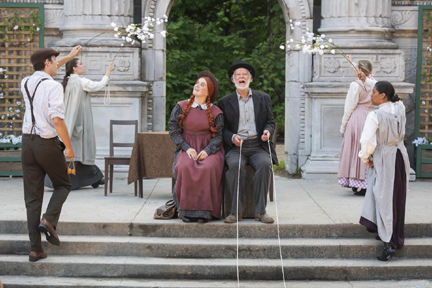
Claire Boudreau & Michael McLeister surrounded by Bryan Kling, Izzi Nagel, Lauren Wolanski, and Aliya Hamid in “Anne” (photo by Barry Scheffer) — courtesy of Guild Festival Theater.
Maud Montgomery’s beloved novel, “Anne of Green Gables” feels at once familiar and fresh in the Guild Festival Theater’s new production. The faux ancient Greek pillars and arches of Guild Park may seem an unexpected setting for the story of a girl’s new life on Prince Edward Island; but, in fact, they add a feel of theatrical substance to a down-to-earth story. Anne’s feistiness, her flights of imagination, and her theatrical way of expressing herself (“My life is a perfect graveyard of buried hopes”) make her a winning heroine, and Claire Boudreau gives her tangible life at ages 11 and up. There’s her arrival at Avonlea and her meeting with the adult siblings – Marilla & Matthew Cuthbert (nicely played by Elaine Lindo & Michael McLeister) – who will become her surrogate

Aliya Hamid in “Anne” (photo by Barry Scheffer) — courtesy of Guild Festival Theater.
parents. There’s the ‘kindred spirit’ represented by Aliya Hamid’s Diana Barry), the yappy Mrs. Lind (“She’s a real odd little thing”) played by Carmen Paterson, the sly nemesis (Lauren Wolanski’s Josie Pye), the schoolmate (Izzi Nagel’s Ruby), and the seeming rival Gilbert Blythe (played by an engaging Bryan Kling, whose guileless facial expression and loose-limbed physicality reminded us affectionately of Roy Bolger’s Scarecrow in “The Wizard of Oz”).
There’s a nice evocation of a horse and buggy ride under the cherry blossoms (Anne’s “white way of delight”), an amusing pantomime of getting into a small boat, and inventive use of recurring little musical interludes, with the cast singing and using varied instruments like an accordion and harmonica. The same inventiveness had them
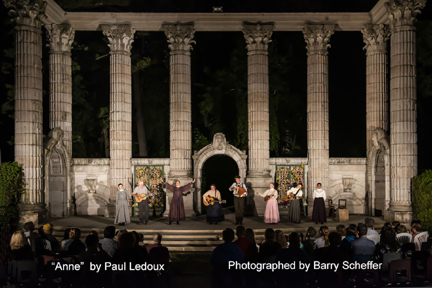
Guild Festival Theater’s production of “Anne” (photo by Barry Scheffer).
occasionally hold up pieces of the set – like a window frame and a counter-top. The costumes, designed (along with the sets) by Miranda DiFlorio (with wardrobe assistance by Simon Flint), were just-right, perfectly conjuring the story’s time and place. The production breathes fresh life into a familiar story; it makes these characters come alive in a very congenial setting. The play is co-directed by Helen Juvonen and Tyler J. Seguin. We only wish the Guild Festival Theater’s season had more than just one play each year.
John Arkelian is an award-winning journalist and author.
Copyright © 2019 by John Arkelian.
“Anne” runs July 18th through Saturday, August 10, 2019 at 7:30 pm. Tickets are $30, or $25 for seniors/students, or $10 for children under 12. Guild Festival Theater is situated in the lovely Guild Park atop the cliffs overlooking Lake Ontario, at 201 Guildwood Parkway (near the foot of Morningside Ave.) in Scarborough, Ontario. For more information and tickets, call (416) 265-2934, or visit https://www.guildfestivaltheatre.ca/
*****************************************************
“Bloom: A Rock ‘n’ Roll Fable”
© Reviewed by John Arkelian
“Someday we’re gonna have a band and get out of this g**damn
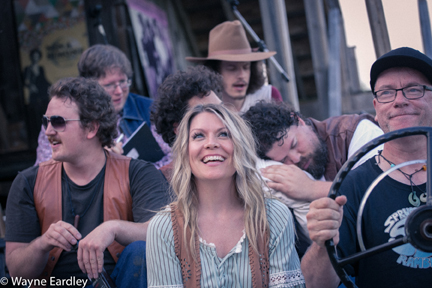
Kate Suhr & band-mates in “Bloom: A Rock ‘n’ Roll Fable” at 4th Line Theater — photo by Wayne Eardley.
town.” So say two young boys, Eli and Neph, who are fast friends, seemingly for life. While calling their small rural community of Assumption (which is southeast of Peterborough, Ontario) a ‘town’ is an exaggeration, the pair make good on their dream. The band that first comes together in childhood persists into early adulthood. Years on the road, playing at the humblest of backwater venues, suddenly segues into national success when they team up with a talented young woman who toils as a waitress. But internal rivalries, jealousies, and resentments threaten to undo everything and rip asunder the lifelong bonds. That’s the gist of 4th Line Theater’s new musical play, “Bloom: A Rock ‘n’ Roll Fable.” Writer Beau Dixon (a musician himself) was inspired by the deep reservoirs of
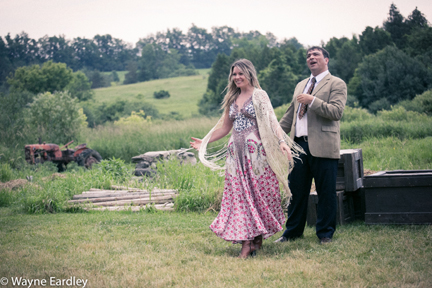
Kate Suhr & Matt Gilbert in “Bloom: A Rock ‘n’ Roll Fable” at 4th Line Theater — photo by Wayne Eardley.
musical talent in Peterborough and the surrounding Kawartha region. The many bands that hailed from there over the years intrigued him: “What happened to them? Where are they now? Why didn’t they reach international stardom? What does it take to reach success? How do you determine success, and what do you sacrifice to [attain it]?” “Bloom” addresses all of those questions, through the lens of its very personal story of its particular (fictional) characters.
Its story spans the 1960’s, and its music reflects that decade: We get snippets of such popular fare as “Pretty Woman,” “Johnny B Goode,” “Wild Thing,” and “The Letter.” And there is an infectious array of songs from the play’s songwriting team of Beau Dixon and
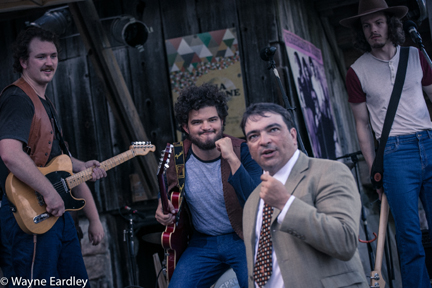
Owen Stahn, Griffin Clark, Matt Gilbert, & band-mate in “Bloom: A Rock ‘n’ Roll Fable” at 4th Line Theater — photo by Wayne Eardley.
David Trough, songs like “Royal Tavern,” “King Solomon’s Seal,” and “Your Love Will Carry Me.” It’s a shame we got only excerpts from those songs: they were performed so well (by the full band and vocalists on stage) that we’d have been glad for complete renditions. First-rate songs all – admirably sung by lead Kate Suhr, who is the production’s standout performer – and a revelation. Suhr can sing and act like a star. A little bird told us that she had a strained voice the evening we attended, but you’d sure never have guessed it listening to her. She was a treat from the first note to the last.
Shelley Simester and JD Nicolsen also stood out as the community’s musical mentors, and we always get a kick out of seeing 4th Line regular Matt Gilbert – this time (with a British accent) as a not
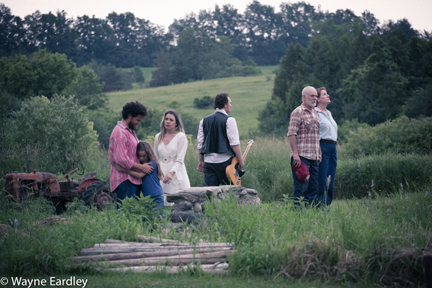
Key cast members in “Bloom: A Rock ‘n’ Roll Fable” at 4th Line Theater — photo by Wayne Eardley.
entirely trustworthy agent and producer. They were surrounded by a very competent cast comprised of pros and able amateur players alike. Together, they delivered some really engaging music and a nice character arc for the leading figures. Moments of humor, conflict, and poignancy alternate in a story that’s drawn from the surrounding region’s history, and it all comes engagingly together, in 4th Line’s inimitable style, under the direction of Kim Blackwell. Some of this production’s evocation of its era (with tie-dye styles, hippy-inspired references to drug-induced intoxication, and colloquial sprinklings of “right on” and “groovy”) could be a tad overt at times, but the audience lapped it up. Every 4th Line Theater production is adept at conjuring a sense of community, and that is doubtless one of the secrets of its ongoing success.
John Arkelian is an award-winning journalist and author.
Copyright © 2019 by John Arkelian.
Editor’s Note: “Bloom: A Rock ‘n’ Roll Fable” runs through July 27, 2019. 4th Line Theater’s second production of the summer, “Carmel” runs August 6 through 31. Set in 1937, “Carmel” is 4th Line’s third play dealing with the lives of Bernardo children. 4th Line Theater is situated on the Winslow Farm, 779 Zion Line, just outside the picturesque village of Millbrook, Ontario. For more information and tickets, call 1-800-814-0055, or visit http://4thlinetheatre.on.ca/
*****************************************************
“Tuesdays with Morrie”
© Reviewed by John Arkelian
“The last class of my old professor’s life took place once a week on

Nicholas Arnold & Allan Price in “Tuesdays with Morrie” — courtesy of the Capitol Theater.
Tuesdays. The subject was the meaning of life. The teaching goes on.” Here’s the touching story of a friendship that’s full of life lessons. “Tuesdays with Morrie” started off life as a memoir, and became an Emmy-winning, made-for-television movie (with Jack Lemmon) in 1999. The play version is on stage now at Port Hope’s Capitol Theater, directed by Rob Woodcock. It’s the true story of a successful sports journalist, Mitch Albom (played here by Nicholas Arnold), who reconnects with his favorite university professor, Morrie Schwartz (played with warm wit by Allan Price), after a years-long hiatus, when he learns that his old teacher is mortally afflicted with ALS (more commonly known as Lou Gehrig’s Disease). Mitch’s first visit is intended to assuage a guilty conscience: not only has he long neglected the friend to whom he swore fealty as a close friend, he has also sold out, trading his musical talent for material success covering sports. But reconnecting with his mentor and friend makes all the difference, reminding Mitch of what’s truly important in life: “Dying is just one thing to be sad about. Living unhappily, that’s another matter.”
Ostensibly about facing mortality, the story of this relationship is really about life – how to live, how to love others, and how to allow ourselves to depend on others: “When we’re infants, we need others to survive. When we’re dying, we need others to survive. But, here’s the secret: in-between, we need others even more.” The result – ably acted on a static stage with a just-right single set (i.e. Morrie’s study) – is full of simple wisdom (“Love is how you stay alive, even after you’ve gone,”), wry humor, and platonic love (the Greek philosophers called it “philia”) between two human beings. It runs 90 minutes, without an intermission, and we were sorry to see it end. Quoting its life lessons out of context risks reducing them to truisms; a cynic might even dismiss them as trite. But there is truth in its reflections on life; and they find traction with the viewer because they find their roots in a close, poignant relationship: we care about these two characters; the warmth and connection between them is palpable – with the two actors hitting just the right notes, nicely understated, without big emotional outbursts. And what a treat to see a drama in a summer festival!
Copyright © 2019 by John Arkelian.
Editor’s Note: “Tuesdays with Morrie” is on stage through July 22, 2019. On August 6-September 1, see “Million Dollar Quartet,” which features the music of Johnny Cash, Jerry Lee Lewis, Carl Perkins, & Elvis Presley in a recreation of their famous jam-session from December 1956.
The Capitol Theater is located in the picturesque town of Port Hope, Ontario. For information about upcoming events, call 1-800-434-5092; or visit http://capitoltheatre.com/
*****************************************************
“Guys and Dolls”
© Reviewed by John Arkelian
Port Hope’s Capitol Theater starts its 2019 summer season

David Leyshon & Catarina Ciccone in “Guys & Dolls” (photo by Alana Lee).
with an enduring Broadway stage musical from 1950, which became a successful Hollywood film (with Frank Sinatra, Marlon Brando, Jean Simmons, & Vivian Blaine) in 1955. Inspired by Damon Runyon’s stories about denizens of New York’s nightlife in the Twenties and Thirties, “Guys & Dolls” is populated with gamblers, showgirls, and street-corner missionaries. Despite the presence of a mobbed-up tough guy or two, most of these characters aren’t really ‘criminal’ in any realistic sense of the word. If they’re not quite ‘respectable,’ it’s a romantic-comedy sort of roguishness. Indeed, matters of the heart are the orb around which the musical’s story revolves. There are two seemingly star-crossed couples: gambling entrepreneur Nathan Detroit (William Vickers) is desperate to find a

From the Capitol Theater’s production of “Guys & Dolls” (photo by Alana Lee).
venue for the coming evening’s high-stakes game, while his fiancée of 14 years, nightclub entertainer Miss Adelaide (Cara Hunter), thinks the time has finally come for him to settle down. Meanwhile, the suavely unflappable gambler Sky Masterson (David Leyshon) takes a bet that he can get the straight-laced missionary Sarah Brown (Catarina Ciccone) to fly to Havana with him for dinner that very night
What unfolds is akin to a screwball comedy, with romantic love steering a careening course along the plot’s twists and turns. A note-perfect cast brings these lovable ne’er-do-wells and naifs to engaging life. All four leads are a treat; and the rest of the players – Daniel Williston (as ‘Nicely Nicely’ Johnson), Ian Simpson (as Sarah’s
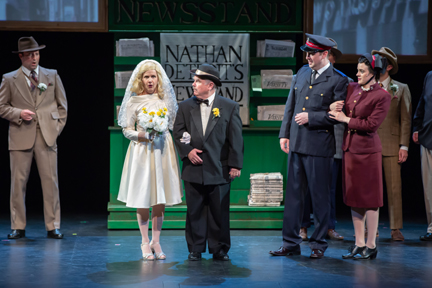
Couples unite — Cara Hunter & William Vickers and David Leyshon & Catarina Ciccone — in “Guys & Dolls” (photo by Alana Lee).
protective missionary father-figure), the gravely-voiced Neil Barclay (as a convincing mobster ‘Big Jule’), and all the others – could not be better. The direction (by the Capitol’s new artistic director Susan Ferley) is polished and professional; ditto for Stephen Findlay’s choreography, Mirands DiFlorio’s costumes, Adam White’s music direction, and Gabriel Cropley’s lighting design. As we’ve long come to expect at the Capitol, it feels and looks every inch like a big-city production – of the same high-caliber we’d see in Toronto, New York, or London. Among the songs, the most recognizable were “A Bushel and a Peck” and “Luck Be a Lady;” while “Sit Down, You’re Rockin’ the Boat,” in energetic gospel music style, was the most memorable. Don’t miss this fine production: A good time is guaranteed.
Copyright © 2019 by John Arkelian.
Editor’s Note: “Guys & Dolls” is on stage through June 16; Mitch Albom’s “Tuesdays with Morrie” is on stage on July 2-22; and on August 6-September 1, 2019 see “Million Dollar Quartet,” which features the music of Johnny Cash, Jerry Lee Lewis, Carl Perkins, & Elvis Presley in a recreation of their famous jam-session from December 1956.
The Capitol Theater is located in the picturesque town of Port Hope, Ontario. For information about upcoming events, call 1-800-434-5092; or visit http://capitoltheatre.com/
*****************************************************
Blue Man Group
© Reviewed by John Arkelian
Three male (but oddly androgynous) figures are the figurative babes  in the proverbial woods in this madcap theater of the absurd. They are speechless, hairless, and cobalt blue. The word that comes to mind is naïf. It’s a term that describes an innocent – one (or, in this case, three) who is ingenuous, unworldly, and wide-eyed. In their own disparate ways, comedic figures as diverse as Stan Laurel & Oliver Hardy, Mr. Bean, and Slava Polunin are such innocents. They bring a combination of simpleness (which not necessarily the same thing as simplemindedness), wonder, and mischievousness to the situations they encounter. You don’t get much more wide-eyed than The Blue Man Group’s trio of blue protagonists: their bright blue faces make their eyes pop. And they express themselves with facial astonishment and bodily pantomime, speaking nary a word in their
in the proverbial woods in this madcap theater of the absurd. They are speechless, hairless, and cobalt blue. The word that comes to mind is naïf. It’s a term that describes an innocent – one (or, in this case, three) who is ingenuous, unworldly, and wide-eyed. In their own disparate ways, comedic figures as diverse as Stan Laurel & Oliver Hardy, Mr. Bean, and Slava Polunin are such innocents. They bring a combination of simpleness (which not necessarily the same thing as simplemindedness), wonder, and mischievousness to the situations they encounter. You don’t get much more wide-eyed than The Blue Man Group’s trio of blue protagonists: their bright blue faces make their eyes pop. And they express themselves with facial astonishment and bodily pantomime, speaking nary a word in their

The Blue Man Group — show finale.
90-minute journey through a world of bright primary colors, percussion born of novel ad hoc instruments, and a re-imagining of clowning for a high-tech world. For the audience, they represent the child within – open to awe, driven by imagination, unafraid of the ridiculous, and not yet hamstrung by decorum.
The Blue Man Group came to the Tribute Communities Center in downtown Oshawa, Ontario on March 5 & 6, 2019 for 90-minute immersion into the unexpected – delivered in a style that’s at once manic and dead-pan. It opens with frenetic drumming, with geysers of bright paint spayed aloft by every beat. There’s a jaw-dropping bit of oral acrobatics, as they catch paint balls (thrown from quite a distance) in their mouths and then propel the liquid contents of

The Blue Man Group
those capsules onto canvas for some very abstract impromptu art. There’s a playful riff on our fascination with smart-phones, and a funny narrated sketch about the destination of all the unmentionables that go into our urban plumbing infrastructure: we don’t know our waste is headed, other than (happily) “away” (as the unseen voice intones). A woman from the audience is invited to join the trio in a fast-food feast. And, in one of the most entertaining sequences, a voice-over narrator instructs the audience to go through a sequence of physical motions, with the help of oversized digital animation in stick-figure style drawing laughter from interactive participation. (Some of our animated coaches are felled by passing traffic and predatory avians.) Some audience latecomers are unwittingly televised on a big screen as the narrator exclaims, “You’re late!” (We instinctively shrink lower in our seat in vicarious embarrassment. But, it’s funny.) And there are recurring returns to percussion, on an innovative succession of make-shift instruments. It’s great fun – bright, energetic, and oddly kind of joyous in its sheer, shameless joie de vivre.
The Blue Man Group made its debut in 1991. Recently acquired by Canada’s Cirque du Soleil, they are first cousins, twice-removed, from the clowning portions of Cirque shows. Their antics have reportedly been seen by 35 million people. Occasionally, a sketch goes on longer than it should (like one of their forays into the audience) and loses momentum; and, the high-adrenaline back-up quartette of four musicians might have tried some musical styles other than rock for a change of pace. But, the shows ends with spectacle (whoever said “Go big or go home” must have had this in mind) – with large inflated spheres bouncing out atop the audience as rolls of tissue paper cascade over our heads and unravel in long colorful strands. Both of those tricks are reminiscent of the astonishing Slava’s Snowshow, which returned to Toronto in early December 2018: Which show had them first we do not know. One thing’s certain: The Blue Man Group is a great deal of unmitigated fun – guaranteed to connect with your inner child.
Copyright © 2019 by John Arkelian.
Editor’s Note: The Ontario leg of The Blue Man Group’s 2019 world tour plays in Oshawa on March 5-6 at the Tribute Communities Center; from there, it goes to Sudbury (March 9-10), Windsor (March 16-17), and Kingston (March 21-24). Visit the Blue Man Group at: https://www.blueman.com/on-tour/buy-tickets
*****************************************************
From Russia with Love:
Slava’s Snowshow Returns to Toronto
© Reviewed by John Arkelian

“Slava’s Snowshow” — photo by Veronique Vial.
Russian accents were thick on the ground in the lobby of Toronto’s St. Lawrence Center on the evening of December 7th. It was opening night for “Slava’s Snowshow,” a bravura combination of classical clown pantomime and audio-visual spectacle with a verified wow factor. The brainchild of Slava Polunin, who hails from a small town in central Russia, the show first astonished audiences at the Edinburgh Festival in 1996. It last visited Toronto some 20 years ago, and it has lost none of its power to evoke wonder in the intervening years. Its ethos is “born of dreams and fairy tales… ritualistic and magical, a festive spectacle… arising from images and gestures, from play and imagination.” Slava explains that, “I wanted to dive inside tragicomedy, to measure the extent to which one can fuse drama with laughter, to measure the degree to which a meek, indecisive character, bemused and bedazzled, kind and fragile, could seduce a
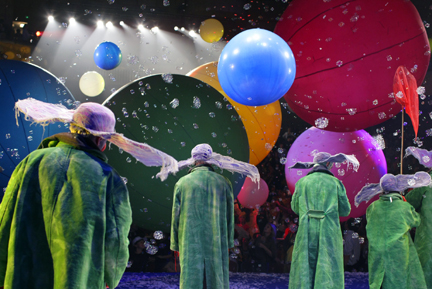
“Slava’s Snowshow” — photo by Vladimir Mishukov.
contemporary audience.” Combining “the epic and [the] lyrical, tenderness and passion, wisdom and [naivety],” Slava’s protagonist, Assissiaï, and his friends, hearken back to an older form of mood-infused storytelling. They are clowns, but they are clowns in the fantastical Cirque du Soleil mold. Still, for those of us reared in North America, it’s hard to utterly dispel the baggage dropped by the garden-variety circus clowns who are best known to audiences on this side of the Atlantic. The clowns we grew up with are saddled with the stigma of rowdy, superficial foolishness; Slava’s old world variety aim for something a lot more sophisticated.
Take, for instance, one of the show’s standout sequences, in which Slava bids a heartfelt farewell to a coat rack at a train station. It is pantomime at its finest, with the inanimate object taking on a life of

“Slava’s Snowshow” — photo by Pascal Ito.
its own; the result is at once tender, touching, and gently funny. In an age of lamentably low attention spans and mass entertainment based on fast jump-cuts and empty computer generated effects, Slava dares to rely on small, tentative gestures, inchoate movement, and gentle pacing: “I began to slow down my rhythm, to value insignificant gestures that now seemed to me far more expressive and colorful than pompous or solemn ones. I grew fond of unfinished gestures, interrupted, frozen, as if cut short by a sudden thought.”
“Slava’s Snowshow” is intended to evoke childlike wonder. It sets the stage with bright primary colors. Its characters have a sympathetically sad-sack look as they inhabit a world of wonders. The lead character balances a large bubble on a stick and later navigates a misty northern sea under starlight. The pantomiming on stage somehow, counter-intuitively, combines humor, poignancy, and drama. There is crowd-pleasing spectacle here, too, but these special effects are always what is known in television and filmmaking as ‘practical effects,’ that is to say, they are physical stunts (writ-large), not CGI fakery. And, best of all, they get up-close-and-personal with the audience. In one sequence, a seemingly endless sticky spider’s web uncoils from the stage (helped along by the extended arms of the audience), unspooling till it covers the entire audience – a mere inch above our heads (or less if you’re as tall as this reviewer). Elsewhere, cast members go walkabout among the audience, teetering precariously atop the back edges of seated audience members’ seats (a stunt that seems a tad too precarious for audience safety). In a startling sequence, we’re hit by intense lights from the stage, as a furious blizzard of thousands of small pieces of tissue paper suddenly hurtle toward us at hurricane velocity. You’ve never been in a blizzard of this intensity. It unfolds abruptly to the dramatic strains of “O Fortuna” from the German composer Carl Orff’s cantata “Carmina Burana.” It’s a few minutes of high dramatic excitement that gets the adrenaline flowing. Things end with an extended set piece in which bright balloons the size of SUVs come careening out at our heads. They’re big and heavy enough to do some damage if they happen to hit you, but there’s little chance of that in the resulting sea of outstretched hands straining to propel them ever upward. Consider the child within truly reawakened.
Copyright © 2018 by John Arkelian
Editor’s Note: “Slava’s Snowshow” runs on December 7 to 16, 2018 at St. Lawrence Center for the Arts’ Bluma Appel Theater, 27 Front St. E., Toronto, Ontario. For tickets ($89.50 – $140.50), visit: http://www.stlc.com/event/slavas-snowshow10/
And see the trailer at: https://www.youtube.com/watch?v=YTKn6mkmFFI
*****************************************************
Wowing Your Audience: Antonio Sarmiento Brought Flair and Vision to the Stage at the Capitol Theater for Five Seasons
© By John Arkelian
Antonio Sarmiento assumed the mantle of artistic director (and

Antonio Sarmiento
general manager) at Port Hope’s Capitol Theater in 2014, after past work as Head of Production at Steven Spielberg’s Shoah Foundation. By the end of 2015, he was a nominee for live theater’s prestigious Siminovitch Prize, which “celebrates a professional director, playwright, or designer, an acknowledged leader in the theater whose work is transformative and influential… [in the process shining] a spotlight on excellence and innovation in Canadian theater.” Excellence, transformative power, innovation, and the capacity to influence others. Those terms capture the very essence of what Sarmiento brought to bear in his vibrant leadership at the Capitol Theater over the course of five memorable seasons. The hallmark of his approach was the innovative use of multi-media and design. Indeed, multi-media played a prominent role in the look (from the catacombs of Paris to the rooftops of London to the streetscapes and sound stages of Hollywood) – and the success – of the plays Sarmiento has produced and directed at the Capitol Theater.
We said this about his 2015 production of “Singin’ in the Rain:” “Its transposition from the silver screen to the theater stage is a marvel to behold. Artistic Director Antonio Sarmiento, who produced and directed the production, has done it again – hitting this one out of the ballpark, to the sheer grinning delight of the Capitol’s record-breaking audiences! … But the surprise stand-out of the entire production is the way snippets of B&W silent films are woven into the story. Are these gleaned from actual silent films from the Twenties? They sure look like the genuine article. But, no, these are original mini-productions, performed by this production’s cast (attired in the clothing of pre-Revolutionary France) and directed by Sarmiento. What a treat for cinephiles! In style, content, and élan, these little marvels are worth the price of admission all by themselves. They even have the authentically scratchy, aged look of film clips made nearly one hundred years ago. This reviewer couldn’t get enough of them: They are eminent examples of ingenuity and artistry in design – so much so that we would happily watch an entire faux-silent movie made by this cast and crew!… One of Sarmiento’s calling cards and strengths as a director is his use of multi-media. Motion picture studio sound stages, the exterior of Grumman’s Chinese Theater in Los Angeles (complete with the moving arcs of spotlights), city streetscapes, and the interiors of movie stars’ posh homes: all of these are evoked through the skilled created use of projected images – changing, moving, gliding seamlessly from one locale to another. A particularly effective moment is the illusion of a trio of parallel brick walls – the effect is positively three-dimensional.”
We said this Antonio Sarmiento’s 2015 production of “Shout! The Mod Musical”: “The production design is psychedelic – all bright primary colors, oversized stuffed plush vinyl ornamentation in the shape of stylized flowers and curlicues, with shag carpeting below. There’s a sporadic lightshow overhead (which conjures visions of a starship going into warp) and changing images on a large projected background. Many of its images are taken from the cover of the pop-culture magazine that gives the show its name. Its pages contain the latest in celebrity gossip and music news, with advertisements for everything from cosmetics to The Pill, and a facile advice column that’s ready-made for spoofing.”
We said this about Sarmiento’s 2014 production of “Mary Poppins”: “Settings are evoked through very effective use of back-screen projections (an otherwise still image of St. Paul’s Cathedral has white clouds moving above its dome), and they often segue artfully into three-dimensional sets inside the Banks’ home.”
And we said this about his 2014 production of “Broadway: Andrew Lloyd Webber”: “Antonio Sarmiento’s musical anthology show gathered together many of the most memorable songs from seven of the British composer’s musicals and turned them into a rousingly good time at the theater. The ensemble cast hit all the right notes as the songs ran the gamut of moods: Some were poignant; others were high-octane numbers that propelled cast and audience alike with infectious energy. The production made effective use of projected backdrops, in the form of still and moving images: Some illustrated the life and career of the composer, while others reflected the setting or mood of the songs on stage. There were operatic gowns for some of the solos; but the production also made surprisingly good use of simple, colorful cotton attire. The most elaborate set design was reserved for a punt (or canal boat) in catacombs beneath the Paris Opera; and, “The Phantom of the Opera” provided four of its thrilling songs to this production, among which were two standouts: ‘Think of Me’ and ‘Angel of Music….’”
In 2018 (his final year at the Capitol), four of Sarmiento’s

Victoria Hall in Cobourg, Ontario
productions earned a stellar 18 nominations at the “Broadway World Toronto” awards. Among those nominations were two for best musical, one for best play, two for best director, and five for best actor/actress. 2018’s “King Arthur: The Panto” (reviewed below) became the Capitol’s bestselling panto of all time, while Sarmiento’s 2016 production of “Mamma Mia!” (also reviewed below) was the bestselling production in the Capitol’s history.
Audacity, originality, impeccable casting, and memorably first-rate theatrical productions that consistently wowed his audiences (who came in record-breaking numbers): What better legacy can any artistic director leave? Antonio Sarmiento made his mark in Port Hope – and he will be missed! And we’ll eagerly watch to see what he does next – starting with his 2019 appointment as Artistic and Creative Consultant for the Town of Cobourg, Ontario, where he will develop a strategic and operational plan for the Concert Hall at Victoria Hall – a jewel of a heritage facility situated in that lovely waterfront community.
John Arkelian is an award-winning author and journalist – and the founding editor of Artsforum Magazine.
Copyright © 2019 by John Arkelian.
*****************************************************
“King Arthur: The Panto”
© Reviewed by John Arkelian
Port Hope’s Capitol Theater likes to close out each calendar year with a ‘panto’ – that very specific British genre that skews a familiar trope into a risqué parody of its more upright self. It’s a wildly popular annual tradition; but, parody, as a rule, doesn’t appeal to us. We’d much prefer a serious take on a perennial fable or fairy tale, than a deliberately self-mocking one. Consequently, we’ve always passed on the Capitol’s annual year-end panto. But 2018 was a special case, for “King Arthur: The Panto” was to be the final production by the Capitol Theater’s outgoing artistic director, Antoinio Sarmiento.
A mash-up of traditional Arthurian characters and a rock musical, the “naughty” version of the show relied heavily on crude sexual banter. That’s a staple of the panto form, as is the broad humor (”You’re one teat short of an udder’), deliberate vulgarity, and none-too-subtle double entrendres. It may skirt actual obscene words, but it’s unapologetically earthy – and downright crude (to wit, an ensemble foray late in the show into the overtly scatological). You either like that sort of humor, or you don’t. (Even for those in the latter camp, it must be admitted that the broad humor does elicit some laughs, despite oneself.) As expected, the form is not our particular cup of tea. However, two particular components won us well and truly over. The first were rousing renditions of songs like “Bohemian Rhapsody” and “Proud Mary.”
The second highlight was a showstopper, in the wonderful form of short film within the musical which had King Arthur and some of his (female) knights-errant mounted on hobby-horse steeds. The props disguised the actors’ legs as equine and gave the riders diminutive inanimate surrogate legs. And off they ventured (in-character and in-costume) onto the highways and byways of Port Hope and Cobourg, interacting with pedestrians, shop-keeps, and other bemused burgers in their mock-serious quest for some grail or other. It was hilarious, very nearly brilliant, and quintessentially the work of director Antonio Sarmiento, who has made his mark with a succession of acclaimed stage productions, all of them showcasing his inventive, oft-ingenious use of video projections. That film within the play (which hearkened back to snippets of a custom-produced B&W short film used to remarkable effect in Sarmiento’s 2015 stage production of “Singin’ in the Rain”) made us very happy indeed that we braved the form of panto!
Editor’s Note: “King Arthur: The Panto” played to packed houses at the Capitol from November 16 to December 22, 2018.
The Capitol Theater is located in the picturesque town of Port Hope, Ontario. For information about upcoming events, call 1-800-434-5092; or visit http://capitoltheatre.com/
Copyright © 2019 by John Arkelian.
*****************************************************
“Shirley Valentine” at the Thousand Islands Playhouse
© Reviewed by John Arkelian
The Thousand Islands Playhouse in Gananoque, Ontario closed

Copyright © 2018 by Ian Coristine (1000IslandsPhotoArt.com)
its season in October 2018 with a first-rate production of Willy Russell’s play “Shirley Valentine.” We are astonished: It’s a brilliant one-woman show, starring Toronto-based actress Deborah Drakeford, and it’s nothing short of a tour de force. How can it be that Broadway-caliber theatrics are happening in this small community? From her dreary and dull domestic life in Liverpool to her reawakening on the Greek coast, Drakeford immerses us in her character’s perspicacity, yearning, and wit. It’s a sheer pleasure to spend time with this character; she’s at once colorful and fully authentic. Kudos to Andrew Kushnir, who directed the play, and to Jung-Hye Kim who did stand-out work with the sets and costumes: the former – an English kitchen and a seaside patio in Greece are right on the money, perfect in every detail. Under Managing Artistic Director Brett Christopher, the Playhouse (which sits directly on the river’s shore and has two auditoriums) has a full season of live theater and music every year from late-May till mid-October. It’s a gem. Even if this town (and region) had nothing else going for them – which is wildly far from being so – the

“Shirley Valentine” starring Deborah Drakeford (courtesy of the Thousand Islands Playhouse) – photo by Randy deKleine-Stimpson
Playhouse alone would make this place a must-visit destination for theater-lovers from the GTA and beyond.
The Thousand Islands Playhouse is a hidden treasure for theater-lovers. Its scenic location on the riverbank may have earned it the moniker of ‘Canada’s Dockside Theater,’ but it’s the quality of its productions that draw over 40,000 theater-goers each and every year. Its 340-seat Springer Theater has two decks with a panoramic view of the St. Lawrence River. This renovated heritage building, built in 1909, was originally the Gananoque Canoe Club and the original cottage-style craftsmanship is readily apparent. Arriving by boat? No problem: you can dock right in front of the theater. The intimate 130-seat Firehall Theater, which offers flexible staging and seating configurations, was built in 1913 and was the former home of the town’s armory (and later its fire and police station). CBC Radio called the Thousand Islands Playhouse “the most charming theater in Canada;” it’s also the unheralded home to some of the best live theater you’ll see anywhere.
Copyright © 2018 by John Arkelian
Editor’s Note: Our travel essay on Gananoque & the Thousand Islands, “The Great Inland Archipelago,” accompanied by the breathtakingly beautiful photography of Ian Coristine, can be found at: https://artsforum.ca/travel/other-wanderers
*****************************************************
Under the Sea at the Capitol Theater
© Reviewed by John Arkelian
“Since life is sweet here / We got the beat here / Naturally / Even
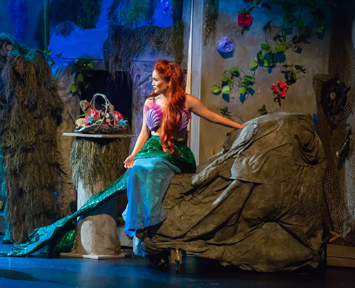
Jennifer Gillis as Ariel in “The Little Mermaid” (courtesy of the Capitol Theater).
the sturgeon an’ the ray / They get the urge an’ start to play / We got the spirit / You got to hear it / Under the sea” You’ll be hard-pressed not to sing along with Sebastian the crab and his underwater ensemble at the Capitol Theater’s high-energy production of “The Little Mermaid.” Based on the irresistible 1989 animated Disney film, the stage musical tells the story of the young mermaid who is smitten with a human prince. Get ready to be immersed: director Antonio Sarmiento turns his creative use of projected backgrounds to the theater ceiling. The result? Why, a wonderful simulation of being under the sea – with oversized fish swimming through sun-dappled waters right over our heads. The effect is utterly enchanting!
And were we ever wowed by this production’s standout performers: Watching Michelle E. Wright (a woman playing a male crab) as Sebastian is to be transported to Broadway. Her voice and

Jade Percival (Jetsam), Jennifer Gillis (Ariel), & Krista Leis (Flotsam) in “The Little Mermaid” (courtesy of the Capitol Theater).
her body-language (she even scuttles like a crab) are note-perfect. And in another gender mash-up, Nick Settimi is a hit as the female villain of the piece, a scheming, pitiless octopus named Ursula. It’s a charismatic home-run of a performance. Ursula’s two minions – the svelte, emerald-green eels Flotsam and Jetsam – are likewise highly entertainingly: disarmingly, they seem more mischievous than malicious, and they are clad in our favorite costumes from the production. Krista Leis (who has caught our eye us before in the Capitol’s “Crazy for You” and “Mamma Mia!”) and Jade Percival make a strong impression in those roles. And special mention goes to Jeremy LaPalme’s manic Chef Louis, who never saw a sea-creature he didn’t yearn to fillet.
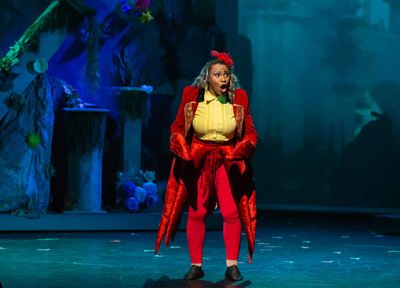
Michelle E. White as Sebastian in “the Little Mermaid” (courtesy of the Capitol Theater).
The rest of the ensemble – among them Jennifer Gillis (as Ariel), Kent Sheridan (as her regal father Triton), Colin Sheen (as Prince Eric), and David Leyshon (as his guardian) – are characteristic of the fine casts assembled at the Capitol – talented actors, singers, and dancers all. Ariel’s seagull and flounder pals (Taylor Lavigne and Joel Cumber) were skewed to youngsters in the audience, a little too broad and raucous for our tastes, but they, too, had their moments to shine (like a seagulls’ tap-dance routine). The story’s music (by Alan Menken) and words (by Howard Ashman & Glenn Slater) offer romance, yearning, adventure, and humor, along with good advice in the lyrics “kiss the girl.” Do that; then go see this show!
John Arkelian is an award-winning author and journalist.
Copyright © 2018 by John Arkelian.
Editor’s Note: “The Little Mermaid” is on stage through September 9; then, just in time for Halloween, the Capitol presents the suspenseful play “Wait Until Dark” on October 18-31, 2018.
The Capitol Theater is located in the picturesque town of Port Hope, Ontario. For information about upcoming events, call 1-800-434-5092; or visit http://capitoltheatre.com/
*****************************************************
Return to Leaskdale
© By John Arkelian
Rapt: That’s the only fit word to describe our reaction to the return
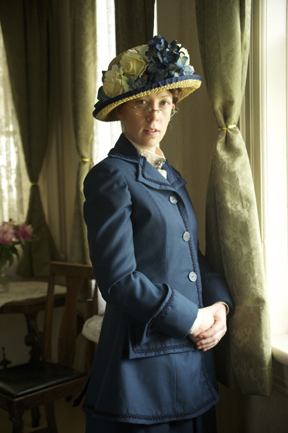
Jennifer Carroll in “Maud of Leaskdale” — photo by Stuart Blower.
of the wonderful one-woman show we first saw four years ago. The life, the times, and the inimitable character of beloved author Lucy Maud Montgomery are brilliantly distilled and given eloquent voice in “Maud of Leaskdale.” Written and directed by Uxbridge’s own Conrad Boyce, the play is beautifully personified by actress Jennifer Carroll, in a bravura performance that captures Maud’s perspicuity, wry wit, fearless honesty, and eloquence. Somehow, Maud’s way of expressing herself is at once pleasingly formal and accessibly down-to-earth (a visiting friend is “as fat as a seal and as strong as a horse”). And, my goodness, how she reminds us of her most famous creation, Anne, with the way she endows her observations with high theatrical drama: “The gates of my soul are barred against them; they do not have the key!” It’s a ‘theatrical’ way of expressing oneself, but it is also utterly sincere. It’s a tribute to Carroll that she can change moods in the blink of an eye – moving from heartfelt sorrow to contentment or happy expectation in a split second. Did we say rapt? Yes, we did, and that’s how we felt – captivated, enchanted, and half in love with the long-dead author whose wonderful turn of phrase and narrative voice (the play is gleaned from the journals she wrote while in Leaskdale from 1911 to 1926) had us hanging on every word, every gesture, and each shared confidence: “I have another opinion; but I do not tell it to all and sundry.” Well, we have only one opinion on the matter, and it is simply this: Do not miss this play when it next appears in the heritage setting that the author once called home.
John Arkelian is an award-winning author and journalist.
Copyright © 2018 by John Arkelian.
Editor’s note: “Maud of Leaskdale” is presented most summers at the Historic Leaskdale Church, 11850 Regional Road 1, Leaskdale, Ontario (due north of the town of Uxbridge). For more information visit http://lucymaudmontgomery.ca/
For our original feature review of “Maud of Leaskdale” see (further down this page): https://artsforum.ca/stage
*****************************************************
“Pygmalion” under the Boughs
© Reviewed by John Arkelian
We were delighted to discover Guild Festival Theater a few
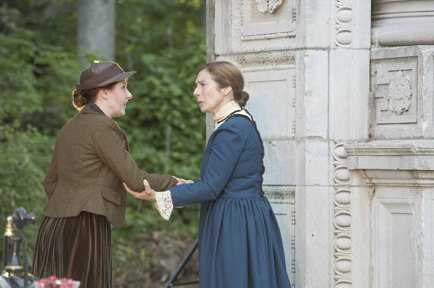
Guild Festival Theater’s production of “Pygmalion” (July 11 – August 12, 2018)
years ago. Their “The Misanthrope” and “Romeo and Juliet” in past years were treats to experience under the boughs (and, in the second act, under the stars); the same can be said for this summer’s “Pygmalion.” The first thing you notice is the setting. Guild Park sits atop the cliffs in Scarborough, fronted by the newly restored Guild Inn. For a stage, there are the towering Corinthian columns and arches that look like they’ve been transported here from the Graeco-Roman world of antiquity. (In fact, their origins were a downtown bank’s monument to its own wealth.)
But what would a setting, however magical, be without a good story – and talented players to tell it? George Bernard Shaw provides the former, with one of his best-known plays (the source for the musical
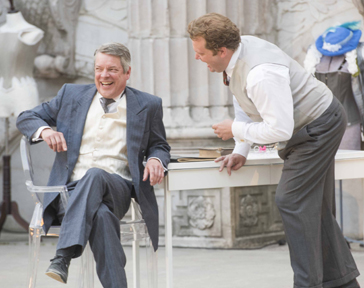
Guild Festival Theater’s production of “Pygmalion” (July 11 – August 12, 2018)
adaptation “My Fair Lady”). Its chief antagonists are a self-styled professor of “the science of speech” and a London flower-seller. Irascible and egotistical, Henry Higgins hits upon the idea of transforming this unpretentious duckling into a princess of a swan. Eliza Doolittle is not impressed by Higgins’ insulting dismissal of her as “a bilious pigeon” and “a squashed cabbage leaf;” but she is intrigued by the prospect of honestly bettering herself. Her inner self is in no need of renovation (she’s a young woman of good character), but her speech, dress, and comportment undergo a radical transformation at the hands of Higgins and his collaborator Colonel Pickering. Their goal is to pass off these seemingly humble raw materials as ‘the Queen of Sheba.’ But, like a child with a “live doll,” Higgins neglects the feelings of his student, too often regarding her as an insensate experiment rather than a living protégé. She’s remade in a regal fashion, but the
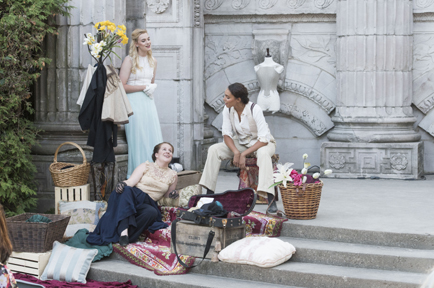
Guild Festival Theater’s production of “Pygmalion” (July 11 – August 12, 2018)
transformation leaves her unsuited to her former simple lifestyle and not really part of the new one for which she’s been molded: “What am I fit for? What have you left me fit for?”
The principals are completely convincing in their roles, with Shane Carty as the self-involved Higgins, Siobhan O’Malley as the diamond-in-the-rough Eliza, David John Phillips as the kindly Col. Pickering, and Tracey Ferencz dividing her time between the disapproving housekeeper Mrs. Pearce and Higgins’ non-nonsense mother. We weren’t sure at first if we were going to like Devon Bryan’s Alfred Doolittle, but he quickly won us over as the heroine’s shamelessly indolent absentee father. Rounding out the cast are Ashlie White, Manon Ens-Lapointe (who bears a striking

Guild Festival Theater’s production of “Pygmalion” (July 11 – August 12, 2018)
resemblance to Hollywood’s Elle Fanning), and Emma Ferreira. Those three play recurring supporting parts – with Ferreira very nicely mimicking the way males carry themselves while she portrays Freddy, a young man who is smitten with Eliza. But the same trio is also used as a variant on a Greek chorus, providing a recurring musical counterpoint to the story with songs (sung and played on fiddle and impromptu percussion). Introducing scenes or keeping us entertained while the page turns from one scene to another, the use of these musical interludes is a refreshing innovation. (Speaking of novelties, we got a kick out of the amusing way thunder is beckoned with a malleable sheet of metal.)
All that’s familiar – the well-known characters, the implicit love story, and the sparklingly humorous dialogue – are delivered with talent and aplomb. Kudos to director Jeannette Lambermont-Morey, artistic director Jamie Robinson (who succeeded founder Sten Eirik in that role after the latter’s untimely death in 2015), costumer Rachel Forbes, the rest of the skilled behind the scenes crew, and the uniformly talented cast for creating a production that’s a pleasure to experience. Indeed, we’re tempted to go back for an encore. It’s an extremely pleasant and diverting way to spend a summer evening. Don’t miss it!
John Arkelian is an award-winning journalist and author.
Copyright © 2018 by John Arkelian.
“Pygmalion” runs through Sunday, August 12, 2018 at 7:30 pm (tickets are $25). Guild Festival Theater is situated in the lovely Guild Park atop the cliffs overlooking Lake Ontario, at 201 Guildwood Parkway (near the foot of Morningside Ave.) in Scarborough, Ontario. For more information and tickets, call (416) 265-2934, or visit https://www.guildfestivaltheatre.ca/
*****************************************************
“Crow Hill: The Telephone Play”
© Reviewed by John Arkelian
One of the joys of 4th Line Theater is seeing original plays with stories drawn from the people, history, and heritage of the
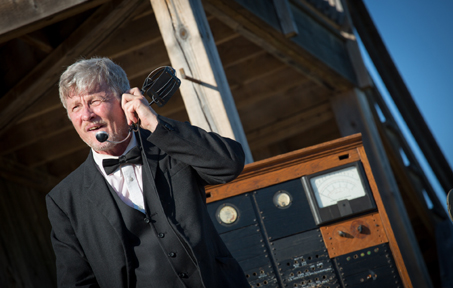
Robert Winslow as Doc Logie in “Crow Hill: The Telephone Play” (photo by Wayne Eardley, Brookside Studio).
surrounding region. Presented outdoors on a farm in the hills near the village of Millbrook, Ontario, it’s the history of the surrounding Cavan Township (and environs) that provides the fresh and novel grist for this annual theatrical mill. The first of 4th Line Theater’s two summer plays in 2018 is “Crow Hill: The Telephone Play,” by Ian McLachlan and 4th Line’s Creative Director (and Founder) Robert Winslow, which was first produced at the farm in 1997.
Spanning the years from 1902 to 1958, “Crow Hill” is the story of a small rural telephone company operated by a country doctor for the benefit of his small community. Our narrator, Alice Cameron (Sarah McNeilly), is modeled on real-life operators who tirelessly manned these systems and knit their communities together in the process.
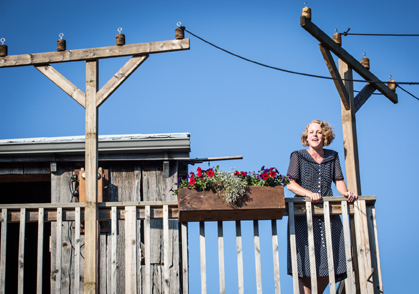
Sarah McNeilly as Alice Cameron in “Crow Hill: The Telephone Play” (photo by Wayne Eardley, Brookside Studios).
“I was on call 24 hours a day for 34 years,” says Alice. “That’s what it meant to be a telephone operator in the old days.” And for each of those years, Alice was quietly in love with his employer, Doc Logie (Robert Winslow), a gruffly endearing incarnation of a rural physician. Alice quietly soldiers on in her thankless job, the apple of her eye seemingly oblivious all the while to the real motivating force behind her loyalty. It’s the story of that inchoate love; but it’s also the story of a community – with a colorful cast of characters including the sophisticated city-gal Grace Dyson (Kait Dueck sporting a perfect Forties hairdo); Alice’s charming but troubled twin brother Hugh (Mark Kreder), and others. Most cast members play multiple roles as the story moves through the years, stopping here and there for incidents amusing or

4th Line Theater’s “Crow Hill: The Telephone Play” (photo by Wayne Eardley, Brookside Studio).
bittersweet. One episode, involving an escaped mental patient mistaken for a German POW, doesn’t feel quite right in tone for this play.
The prevailing tone might best be described as jovial, which, arguably, gives short shrift to the unhappier shades in life’s palette. Some local children as extras add a lot to the production (with their rambunctious play, squeals of alarm, and feline impersonations), as do the appearances of an actual antique Ford car motoring into the meadow stage. Lorna Green’s turn as a hermit folk-apothecary (‘Granny Troll’) was an amusing high-point. And the direction by Deb Williams does an entertaining job of conveying a party-line, with cast members on old-fangled telephones at several different locations all trying to get a word in edgewise. Physicality is up close and personal in 4th Line plays – in one scene, Grace climbs up a pole set amidst the audience. Recurring 4th Line player Matt Gilbert was a welcome face. And Courtney Stevens was right on point as the glib salesman Ed Milton (a fast-talking character who brought to mind the hilarious religious huckster played so memorably by Jeff Schissler in 4th Line’s “Gimme That Primetime Religion” in 2015). Music by the company’s in-house music director Justin Hiscox contributes to the distinctive look (and sound) of 4th Line’s productions. It didn’t take long for that special blend of storytelling to grab and hold our attention.
John Arkelian is an award-winning journalist and author.
Copyright © 2018 by John Arkelian.
“Crow Hill: The Telphone Play” runs through July 28. 4th Line Theater’s second production of the summer, “Who Killed Snow White” runs August 6 through 25, 2018. (Don’t be misled by the play’s title: Its subject is childhood bullying.) 4th Line Theater is situated on the Winslow Farm, 779 Zion Line, just outside the picturesque village of Millbrook, Ontario. For more information and tickets, call 1-800-814-0055, or visit http://4thlinetheatre.on.ca/
*****************************************************
Cirque du Soleil’s “Corteo”
© Reviewed by John Arkelian
Cirque du Soleil’s production of “Corteo” made a four-day

Cirque du Soleil’s “Corteo” – costume design by Dominique Lemieux; photo by Lucas Saporiti
stop in Oshawa, Ontario on June 21-24, 2018. Like all Cirque du Soleil productions, it is an artful combination of bright colors, fanciful costumes, exotic music, playful dreamscapes, and astonishing acrobatics – on the ground and in the air. The opening moments, presented behind a gauzy curtain, were unremarkable – with a grey-haired man (on his presumed death bed) and various eccentric figures scurrying around for no discernible purpose. One flaw in the Cirque model is that spoken word dialogue, which is often, as here, either heavily accented or in another tongue (Italian) altogether, is very difficult for the audience to make out, coming across as gibberish even when that’s not the intention. But things perk up
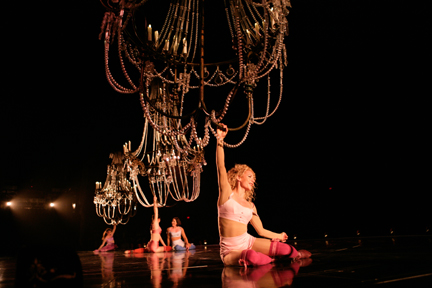
Cirque du Soleil’s “Corteo” – costume design by Dominique Lemieux; photo by Lucas Saporiti
almost immediately as women are carried aloft by chandeliers – the interplay of crystals, candles, and aerial ballet was lovely. Then beds became trampolines, and a rolled-up girl became a bouncing ball in an exuberant display of acrobatic prowess.
An angelic flying lesson for the show’s recently deceased (and freshly winged) character made for an amusing comedic interlude, as did a later one with a sentient golf ball (a human head protruding from the stage floor) trying to avoid being swatted by a determined golfer. But, the best of the comedic moments, and a show highlight, had a little person carried aloft – right over the audience by several enormous translucent balloons. Giggling merrily on her precarious flight, she was helped along by helpful upward shoves by
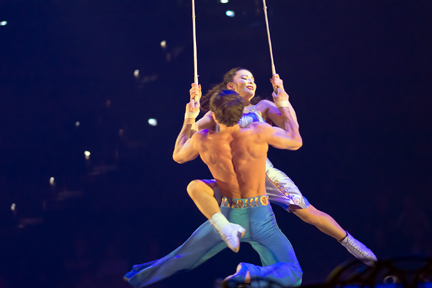
Cirque du Soleil’s “Corteo” – costume design by Dominique Lemieux; photo by Lucas Saporiti
audience members. Getting the audience involved was an inspired move: What fun!
Elsewhere, there was plenty to delight and amaze: Men became the spokes in large spinning wheels; a figure seems to walk upside down along an illuminated blue path high overhead; a bevy of disembodied shoes somehow scurry across the stage on their own; and a vertical pole goes airborne, with a woman somehow aboard for a balletic performance. One of the amazing things about every Cirque show is the seemingly effortlessness of its players’ gravity-defying movement – performers bear their entire weight in their hands (or even merely by their ankles) as though they were weightless. The result draws gasps of wonder and admiration in equal measure.

Cirque du Soleil’s “Corteo” – costume design by Dominique Lemieux; photo by Lucas Saporiti
There’s a too brief bit with a marionette girl dangling very convincingly from ropes; a woman twirling numerous rings on her torso and limbs; dueling teeter-totter rivals who send each other soaring high above the stage with precision landings preceded by flips and spins; a nerve-wracking high-wire act with several women being flung high above the stage and caught by men with enviable upper body strength; a whistler vs. violinist musical duel; a man with an oversized yo-yo routine; an angel in white raining snowflakes on the stage below; inventive use of a ladder as a prop; a lovely pas de deux by a couple swinging from two ropes, climaxing with a sprinkling of glittery stardust; men on parallel bars; and more. The only flop of a sequence was a clowning interlude with two little people (and others) doing a farcical play within a play rendition of “Romeo and Juliet” – it went on too long and it didn’t work.
We sure were sorry when “Corteo” came to an end – Cirque’s idiosyncratic blend of artistry, acrobatics, and, can we call it ‘aerobatics,’ adorned with its own unique spin on clowning, its original music, its flamboyant costumes, and playful dreamscapes, is a treat to behold.
There were a couple of very poor logistical choices on the part of the venue (Oshawa’s downtown arena, the Tribute Communities Center): (1) The bright lights above all the aisles were left on. That was doubtless a safety measure, but it distracted from the show for those sitting on an aisle. And (2) the venue did nothing to inhibit a constant stream of pedestrian traffic up and down said stairway aisles – during the show! Some of those frivolous wanderers were heavily laden with trays of junk food, missions that should, more sensibly, have waited till the intermission. Apparently, the venue would rather keep the concessions moving than maintain proper decorum for the show – i.e. with people in their seats rather than clomping up and down the stairs. Oshawa is not a hick-town, but you’d never know it from this parade of footloose audience members. Finally, it was disappointing that Cirque du Soleil was empty-handed when it comes to program booklets: It’s the glossy souvenir program (available somewhere in the building for purchase), or nothing. At the prices they’re charging, that’s a bit tight of Cirque. Contrast that stinginess with Toronto’s annual “Fall for Dance North” extravaganza, which charges a mere pittance for seats, yet supplies all comers with a lovely color program booklet at no added charge.
John Arkelian is an award-winning author and journalist.
Copyright © 2018 by John Arkelian.
*****************************************************
“Fiddler on the Roof” at the Capitol Theater
© Reviewed by John Arkelian
The hits keep coming at Port Hope’s Capitol Theater. And their

“Fiddler on the Roof” at Port Hope’s Capitol Theater (Alana Lee Photography).
new production of “Fiddler on the Roof” is at the same high caliber – of singing, dancing, acting, and stagecraft – as previous installments in this gem of a theater’s annual summer line-up. Director Antonio Sarmiento brings his patented visual flair to the production – seamlessly weaving projected images (of the village and surrounding valley) into the physical set and high-energy cast, and opening the show with cinematic credits. Kudos to the entire cast and production team (among them, Sarmiento as director and production designer, choreographer Stephen Findlay, music director Scott Pietrangelo, costume designer Miranda Vanlogerenberg, lighting designer Gabriel Cropley, and stage manager Charlene Saroyan) – strong talents all.
Above all, the cast is paramount to any successful stage production.

“Fiddler on the Roof” at the Capitol Theater (Alana Lee Photography).
They waste no time in winning the audience over, with the rousing number “Tradition!” Each of the number’s four groupings (the papas, the mamas, the daughters, and the sons) is vocally strong, polished, and persuasive, drawing us into this well-known story and making it their own. There’s scarcely a scene in which the chief protagonist, Tevye (David Leyshon), does not appear – and he makes a wry, warm, and sympathetic lens through which we see the story of Russian Jews coping with poverty and increasing state persecution in 1905. On the continuum of prominent others who have played the famous role, he has more of Topol’s dignity (from the film version) than Zero Mostel’s larger than life zaniness (from Broadway). His accent is consistent, if, perhaps, slightly askew
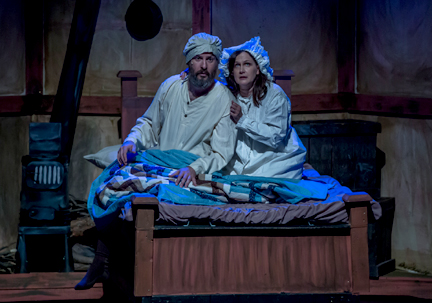
“Fiddler on the Roof” at the Capitol Theater (Alana Lee Photography).
geographically from where the story takes place. Cara Hunter makes a fine foil as his strong-willed wife Golde. And the actresses who play their five daughters – Tzeitel (Gabi Epstein), Hodel (Tringa Rexhepi), Chava (Jade Percival), Shprintze (Rebecca Horvey), and Bielke (Emily Robertson) – are utterly winning, as a quintet and singly. All five deliver note-perfect performances, completely convincing as siblings.
Elsewhere, Ryan J. Burda makes an impression as Perchik, the confident, idealistic student who yearns to help change the world. Not everyone has their eyes on a distant horizon and lofty goals: the young tailor Motel (Braeden Woods) is content with his humble

“Fiddler on the Roof” at Port Hope’s Capitol Theater (Alana Lee Photography).
calling; but it makes him no less a good man. Nick Settimi is very good as the unlucky-in-matrimony butcher Lazar Wolf, and Deborah Tennant (as Yente) makes a trade out of irrepressibly ‘making a match.’ There are some particularly talented dancers among both genders (with some impressive high kicks). Infectious energy is on full display with the frenetic group song and dance routines – one of the most memorable ingredients in every Capitol musical. That energy is there again, but so is abundant humor and poignancy in this thoroughly engaging production. Drop what you’re doing and go see it.
John Arkelian is an award-winning author and journalist.
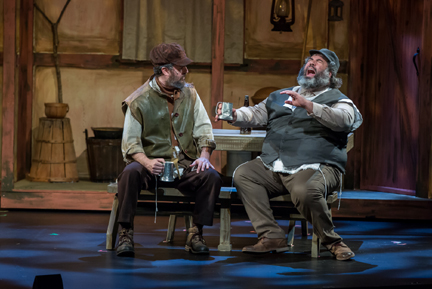
“Fiddler on the Roof” at the Capitol Theater (Alana Lee Photography).
Copyright © 2018 by John Arkelian.
Editor’s Note: “Fiddler on the Roof” runs through June 30; it is followed by a comedic version of “The 39 Steps” on July 10-29; then comes Disney’s “The Little Mermaid” on August 14 – September 9; and, just in time for Halloween, see “Wait Until Dark” on October 18-31, 2018.
The Capitol Theater is located in the picturesque town of Port Hope, Ontario. For information about upcoming events, call 1-800-434-5092; or visit http://capitoltheatre.com/
Postscript: We’ve never encountered problems in the audience at the Capitol before, but an inconsiderate fellow in the row behind us opted to talk to his partner non-stop on this occasion, which nearly brought out our inner Cossack. Sad to say, but the bad habits of too many moviegoers may be gradually infiltrating their unwelcome way into the behavior of some audience members in other areas of the performing arts.
*****************************************************
Be Our Guest:
“Beauty and the Beast” at the Capitol Theater
© Reviewed by John Arkelian
Star power is alive and well at Port Hope’s Capitol Theater, and

From the Capitol Theater’s production of “Disney’s Beauty and the Beast.”
not all of the stars are on stage. The new production of “Disney’s Beauty and the Beast” hits all of the right marks, brilliantly, in every single department – acting, singing, choreography, costumes, lighting, and the remarkably effective nexus between physical sets and projected images. Director Antonio Sarmiento has outdone himself – with a cast and crew that are at the top of their game. The result is a must-see show that’s ever so worthy of a repeat visit.
The three primary settings for this story about the redemptive power of love are a castle, a shadowy forest, and a village. It’s the first of those three that greets the audience as we take our seats – physical surfaces, with long narrow windows and balconies, serve as
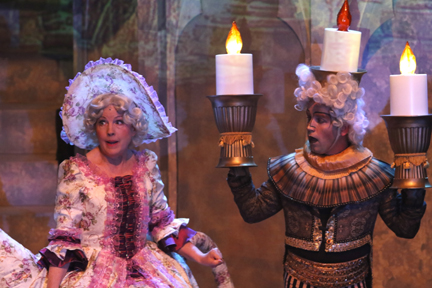
From the Capitol Theater’s production of “Disney’s Beauty and the Beast.”
large, staggered screens upon which projected images of a palatial interior are shown, starting with pillars, stone-walled corridors, high ceilings, and ornate moldings. It creates a visceral sense of an expansive space within the finite confines of the thrust-stage. And, along with the faintly spectral background music, it creates a tone of eeriness befitting an enchanted caste.
The show begins with opening credits, movie-style, that’s become an early flourish in all Capitol productions. We get the story’s back-history – how a selfish prince came to be cursed – through a prologue read by a child on stage as shadowy silhouettes animate the events. Then, in the blink of an eye, the castle backdrop turns into a
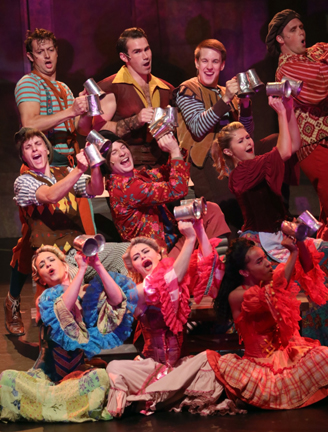
From the Capitol Theater’s production of “Disney’s Beauty and the Beast.”
quaint village, and our heroine Belle enters down a theater aisle. Marie Mahabal captures the character’s sweetness and her strength and independence. The song that bears her name is a musical treat as it juxtaposes her curiosity about the wider world and her longing (“I want much more than this provincial life / I want adventure in the great wide somewhere”) with the disapproval of the villagers. We meet the egotistical hunter Gaston (David Cotton) who is determined to win the hand of the only girl in town who isn’t besotted with him and a trio of zany girls (Christine Desjardins, Amanda De Freitas, and Sarah Vance) who swoon every time the blowhard he-man goes by. Belle’s beloved father (Sam Rosenthal’s Maurice) gets lost in the forest at night and is attacked by wolves – an action scene that’s genuinely exciting, thanks to the effective interplay of costumes, choreography, and the mood of real danger the setting conjures. The men in the wolf gear look the part and their lupine-appropriate movements (they enter quickly on all fours) make them all the more convincing – and threatening.

From the Capitol Theater’s production of “Disney’s Beauty and the Beast.”
When Maurice finds seeming sanctuary at an ostensibly abandoned castle, arriving suddenly before its forbiddingly high doors, we meet the enchanted place’s occupants – hybrids of human beings and inanimate objects like a candelabrum, clock, feather duster, tea pot, and bureau. We wondered how the stage version would handle these characters, which were wholly animated in both versions of Disney movie musical. We actually prefer the hybrid version adopted on stage – they are still visibly human, but they are attached to the inanimate object which they’ve partially become. Mrs. Potts (Deborah Tennant) has a teapot’s handle and a spout at opposite ends of her skirt’s bustle; Babette’s (Jamie McRoberts) svelte gown ends in feathers at her ankles and hands; Chip (played
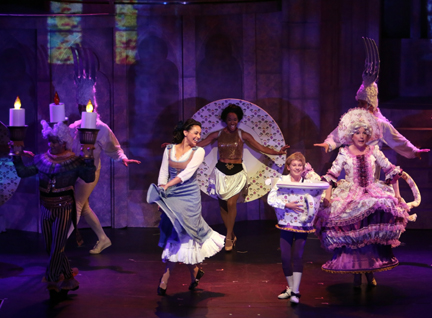
From the Capitol Theater’s production of “Disney’s Beauty and the Beast.”
at different performances by Malcolm Jack or Elli McCallum) has an oversized teacup around his torso; and Madame de la Grande Bouche (Sarah Strange) sports a dresser where her skirts should be. But pride of place among the castle’s household staff goes to Lumière, who has candles for hands and Cogsworth, who has a mantle-piece clock face on his chest. Those two, played, respectively, by Jay T. Schramek and Mark Weatherley, are a treat to behold as frequently disagreeing friends. For his part, Schramek, who is returning from past Capitol engagements like “Crazy for You” and “Singin’ in the Rain,” steals every scene he’s in, with an utterly winning performance as the suavely romantic Frenchman who happens to be part candelabrum.
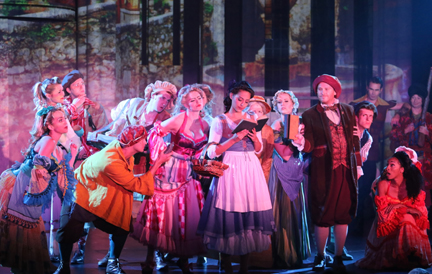
From the Capitol Theater’s production of “Disney’s Beauty and the Beast.”
And then there’s the Beast: Michael Torontow gives him a gruff, angry, and initially threatening voice, and treads on the balls of his feet to give the illusion of a hoof-propelled gait. Here’s a man transformed by his own inner flaws to outwardly resemble his beastliness within. But the physical change has increasingly separated him from much of his humanity. Can love reverse the process and undo the curse? It’s a romance, so we know the answer is yes. But the journey is as important as the destination, story-wise. As Belle explores the castle, the projected visuals adeptly follow her virtual tour of its long corridors, archways, and grand rooms. Later on, there’s a virtual library that will delight every bibliophile in the audience as much as it pleases Belle. An instant scene change takes us to the village
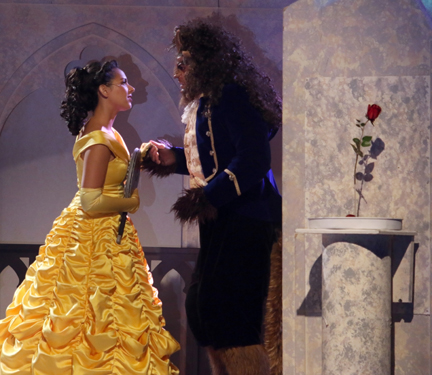
From the Capitol Theater’s production of “Disney’s Beauty and the Beast.”
tavern, where all present boisterously sing the praises of Gaston (“No one’s like Gaston”) in one of the production’s standout scenes. Everything here – the rollicking, infectious song itself, the subdued lighting, the just-right set, the frenetic dancing, the fast-paced choreography, and the neat percussion section with metal beer mugs is note-perfect. This is A-plus musical theater that left us convinced we’d just been transported to Broadway.
And that treat is soon followed by another showstopper, in the form of “Be Our Guest,” in which a relatively modest number of performers feel like many more – such is the impact of the scene’s staging and performances. Each female member of the dining room staff has a big plate on her body, the males are adorned with forks or spoons atop their heads. The salt and pepper shakers are a high-octane acrobatic dance duo, and the irrepressible Lumière presides over the manic tableware mayhem with gusto and charm. Post-intermission, there’s another wolf attack, with Beast bravely saving Belle at mortal peril to himself. Even as the rose on display high above starts to fail, love between the pair starts to blossom: There’s a touching moment between Belle and Beast shared over a book, a happy dinner together, and a ballroom dance to a fine, touching rendition of the theme song by Mrs. Potts, as projected chandeliers shine overhead. In a blink and you’ll miss it moment, Lumière sings a phrase from the famous Québécois song “Mon pays,” presumably a bit of local content ad-libbing for Canadian audiences.
As things move to a crisis, the villagers sing “Kill the Beast,” another effective group number. Along the way Belle gets a star-turn in “A Change in Me” to bookend Beast’s powerful song of despair at the end of the first act. The battle comes, and love triumphs when all hope seems lost – with a sad song in the fog transformed into the redemptive happy ending (what Tolkien dubbed the ‘eucatastrophe’) we all yearn for in real life. (Additional songs were added to the stage show, songs which didn’t appear in the movie version.) Even the bow-taking to a standing ovation felt emotional. And that’s the secret to this production’s brilliant success: It creates real emotions – from sadness and despair to joy – with its strong performances, expert choreography by Stratford veteran Kerry Gage, Sarmiento’s adept direction, gorgeous costuming by Alex Amini, just-right lighting by Joe Pagnan, Scott Pietrangelo’s sine qua non music direction, first-rate sets and props, and the best-ever use by Sarmiento of projected images to create a realistic simulacrum of the story’s time and place. Bravo! Break down doors if you have to, but see this production!
John Arkelian is an award-winning author and journalist.
Copyright © 2017 by John Arkelian.
Editor’s Note: The stage musical “Disney’s Beauty and the Beast” runs through September 10, 2017 — extended through September 17th.
The Capitol Theater is located in the picturesque town of Port Hope, Ontario. For information about upcoming events, call 1-800-434-5092; or visit http://capitoltheatre.com/
*****************************************************
“Steel Magnolias” at the Capitol Theater
© Reviewed by John Arkelian
“I think there’s a story here.” Those plain, matter-of-fact words
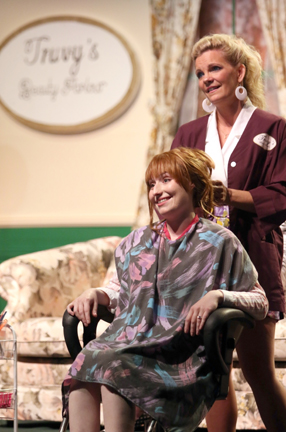
Kristy Bird and Alyssa McCallum in “Steel Magnolias” (courtesy of the Capitol Theater).
capture the essence of this story about five female friends. It’s a story about ordinary people that takes place entirely in a 1980’s beauty parlor in a small Louisiana town. We follow the eddies and currents of love and loss, revisiting these women at intervals of some months. There’s Truvy (Alyssa McCallum), the sassy proprietress and mistress of ceremonies at the beauty parlor that bears her name who always has earthy wisdom at the ready: “We’re as busy as a one-armed paper-hanger.” There’s M’Lynn (Honor Sylvester) and Shelby (Kristy Bird) a mother and daughter whose milestones (in the former of the latter’s impending marriage, subsequent risky pregnancy, and health crises) punctuate the play’s emotional arc. (There’s a startlingly realistic moment involving a mighty convincing episode of diabetic shock.) There’s Ouiser (Helen Pitt-Matthew) the ornery dame who declares “I am not crazy. I’ve only been in a very bad mood for 42 years.” There’s Clairee (Brenda Barr-Worsnop), who isn’t quite sure what to do with herself as a recently widowed lady. And there’s Annelle (Talen Waller) the initially shy, unsure, and ‘mousy’ young woman who grows in conviction. Vividly painted characters all, they are convincingly portrayed by the talented cast that director Antonio Sarmiento has assembled for this Capitol Theater production.
Best known for its 1989 film adaptation, Robert Harling’s play, “Steel Magnolias,” is full of heartwarming wit and down-to-earth wisdom: “I would rather have 30 minutes of wonderful than a lifetime of nothing special.” At its heart, it’s a story about enduring friendship. To their credit, the cast here do not take the easy route of imitating Dolly Parton and others from the film version; instead, they bring their own originality to their roles. The Capitol’s production opens with projected credits and music in one of Sarmiento’s patented cinematic touches. The entire production takes place on a single, authentic-looking set: It comes equipped with running water for the hairdresser’s sink, and its walls are adorned with fashion photos sporting the ‘big hair’ and perms befitting the time in which it is set. But, and this is an unmistakable sign of a well-written, well-acted play, the story could almost have been presented on a bare stage – that’s how wrapped up we get in the lives of these women and their plain-spoken verbal interaction. It is yet another in an unbroken series of wholly engaging nights at the theater. The venue may be in a small town, but this is professional theater at its finest. One only wishes that the Capitol’s summer season extended later into the year, with even more theatrical riches for its appreciative audience to savor: Why not offer new in-house stage productions till the snow falls?
John Arkelian is an award-winning author and journalist.
Copyright © 2017 by John Arkelian.
Editor’s Note: “Steel Magnolias” runs through July 22; and the Capitol’s 2017 summer season concludes with the stage musical “Disney’s Beauty and the Beast” on August 8 through September 10.
The Capitol Theater is located in the picturesque town of Port Hope, Ontario. For information about upcoming events, call 1-800-434-5092; or visit http://capitoltheatre.com/
*****************************************************
“Bombers: Reaping the Whirlwind” at 4th Line Theater
© Reviewed by John Arkelian
A crotchety old man gets an unexpected visitor from England who
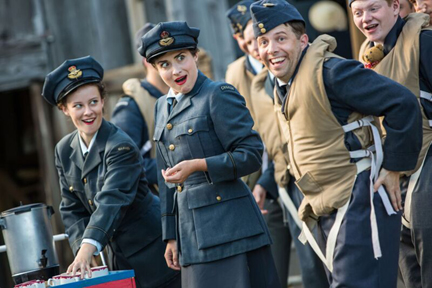
Frances Loiselle, Kait Dueck, & Colin A. Doyle in “Bombers: Reaping the Whirlwind” (photo by Rebekah Littlejohn — courtesy of 4th Line Theater).
draws him reluctantly back to the war years. Try as he might to banish that time from his thoughts, he is surrounded by his memories – quite literally, as his past comrades (and love interest) declare, “We’re all right here.” It’s a little-known fact, but one third of all RAF bomber crews in the Second World War were Canadian. As playwright David S. Craig says, “We built the planes and made the bombs [and] we trained 130,000 pilots.” (Yes, that’s one hundred and thirty thousand!) Craig adds that according to some estimates, flying in a bomber was the most dangerous place to serve in that war, with only one man in four escaping death, serious injury, or capture and imprisonment. Craig’s new play, “Bombers: Reaping the Whirlwind” fictionalizes the experiences of
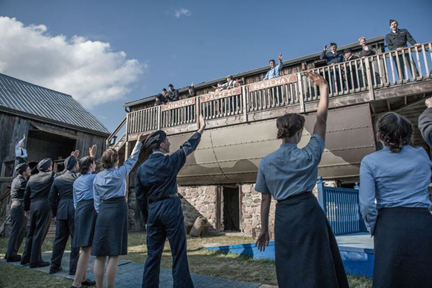
“Bombers: Reaping the Whirlwind” (photo by Rebekah Littlejohn — courtesy of 4th Line Theater).
Canadian bomber crews in 4th Line Theater’s first offering in its annual two-play summer season.
Like all 4th Line productions, “Bombers” is inspired by the history of its surrounding region, though this one ranges much further afield than is the norm. Here, we follow the wartime life of Peter Benton (Michael Cox) a young man from the area who enlists in the RCAF at the age of 18, trains at an induction camp (there’s a speech by ace fighter pilot Billy Bishop along the way), then travels across the country and across the sea to take up his duties (at the tender age of 20) as a bomber pilot. Along the way, he finds friendship, especially with the mischievous Danny O’Neil (the crowd-pleasing Colin A.

“Bombers: Reaping the Whirlwind” (photo by Rebekah Littlejohn — courtesy of 4th Line Theater).
Doyle), love (with Shaina Silver-Baird’s service-woman Emma), and camaraderie (with the rest of his seven-man crew in the Thunderbird Squadron). Another characteristic of 4th Line productions is music, and this show has plenty of it, starting with a prologue’s “Wings of Glory… We’re asking you to play your part,” as columns of players in uniform stand at attention below the Union Jack The later trip, by land and sea, to the war theater is set to the lively tunes of “Leaving Home.” The playwright and 4th Line’s in-house music director Justin Hiscox were both involved in creating the play’s abundant songs and instrumental music. In additional to much original music, we get nods to such period staples as “As Time Goes By.” In an interlude among the Germans, we get civilians

“Bombers” Reaping the Whirlwind” (photo by Rebekah Littlejohn — courtesy of 4th Line Theater).
singing “Ode to Joy” in German, with hands raised in the notorious stiff-armed salute that ought to be regarded as anything but joyous: It’s a moment that simultaneously humanizes the enemy and reminds us of the perniciously vile ideology to which they succumbed en masse, to the terrible detriment of all of humanity.
Among the cast, the aforementioned leads do very well, as do Kait Dueck and Frances Loiselle, who capture the look and manner of the period extremely well in their multiple roles (including the comedic relief ‘tea girls’ who are close kin to “The Odd Couple’s zany English Pigeon sisters). It’s nice to see 4th Line regular Matt Gilbert in a succession of supporting parts: he brings a strong stage presence to

Michael Cox in “Bombers: Reaping the Whirlwind” (photo by Rebekah Littlejohn — courtesy of 4th Line Theater).
each of his incarnations here. And the troupe’s founder and creative director Robert Winslow appears as the cross 94-year-old version of the play’s protagonist. Opinions may vary on the utility of keeping the trio of present-day figures (the aged Peter, his adult daughter, and a young researcher from Britain) onstage, as observers, while the wartime story unfolds. For our part, we found their lingering presence a needless distraction – an intrusion of the mundane into the more ‘romantic’ past. True, the themes of memory and lifelong post-traumatic stress loom large in the play; but, for us, the whole flashback conceit adopted by the playwright adds nothing vital to the core story.
What we did like very much was the effective conjuring of a past time and place – through the costumes, the physical bearing of the young air force crews, the music, and especially the note-perfect performances. Raucous revelry alternated with poignant moments of loss, the power of romantic love, the stress of combat, and the pain of loss – all that and abundant humor, too. A surprising (and unnecessary) note came in the form of several gratuitous (and off-putting) uses of the eff-word, which one doesn’t typically encounter in 4th Line shows. On the plus-side, the sound effects (by Esther Vincent) were so good that we repeatedly looked upward at the sound of vintage aircraft in flight. Monica Dottor took a break from acting this time around, to serve as the show’s choreographer. And the production invited us to be imaginative: One of the crew’s flights was represented by them holding a large model of a bomber above their heads, another by having the seven crew members occupy different sections of some intricate scaffolding, as befit their roles (as pilot, navigator, bomb-aimer, and so on). And there was a nice touch near the end with paper airplanes made of Union Jacks soaring over the heads of the audience.
As always, 4th Line lives up to its hallmark traditions of presenting new plays (typically developed specifically for their debut by and at 4th Line), mining regional history for a myriad of fascinating human stories, combining spoken word and songs, and using innovative staging in its outdoor venue to tell stories with both drama and humor.
John Arkelian is an award-winning journalist and author.
Copyright © 2017 by John Arkelian.
“Bombers: Reaping the Whirlwind” runs through July 29. 4th Line Theater’s second production of the summer, “The History of Drinking in Cavan,” runs August 7 through 26, 2017. 4th Line Theater is situated on the Winslow Farm, 779 Zion Line, just outside the picturesque village of Millbrook, Ontario. For more information and tickets, call 1-800-814-0055, or visit http://4thlinetheatre.on.ca/
*****************************************************
‘Wouldn’t it be Loverly?’
My Fair Lady on Stage at the Capitol Theater
© Reviewed by John Arkelian
Artistic Director Antonio Sarmiento brings a stylish cinematic

Ellen Denny, Terry Belleville, & David Leyshon in “My Fair Lady” (courtesy of the Capitol Theater)
flair to all of the plays he directs at Port Hope’s Capitol Arts Center. That’s apparent from the opening moments of “My Fair Lady,” in which the musical prologue and projected credits mimic the opening of a movie. The visual flair, acting chops, and confident command of the song and occasional dance numbers inject sparkling energy and moments of considerable pathos into this production of the beloved Lerner and Loewe musical. It’s a story about crossing the great divides of class and gender, in which an egocentric professor of ‘simple phonetics, the science of speech’ takes up an older gent’s challenge to remake a randomly selected representative of the lower classes – a rough and sometimes raucous flower seller named Eliza Doolittle. That bumptious duckling is transformed – in speech, bearing, and manner – into a beautiful swan: “I have made you a consort for a king,” Henry Higgins proudly declares.

Deborah Tennant & Ellen Denny in “My Fair Lady” (courtesy of the Capitol Theater)
When they first meet, Higgins is more inclined to dismiss his reluctant protégé as a “guttersnipe” and declare her guilty of “the cold-blooded murder of the English language.” Tall panels glide and pivot on stage between scene changes to provide the multiple screens on which evocative projected scenes appear. Nowhere are the projected visuals more effective than in the exterior scenes of Higgins’ stately town-home – all white Georgian architecture, with staggered panels situated further back on stage to depict the upper stories to very appealing three-dimensional effect. (An added nice touch is the projected shadows of unseen foliage on the house’s facade.) Higgins’ study is the scene for much of the story, and it is a felicitous combination of physical set design and projected illusion:
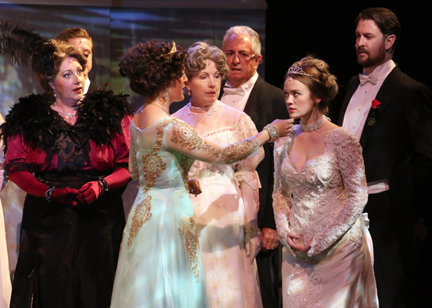
At the ball in “My Fair Lady” (courtesy of the Capitol Theater)
We liked the combination of a fully dressed set and added projected touches (of chandeliers and bookcases) very much.
The costume designs by Alex Amini are worthy of anything on Broadway. In a standout scene, society’s ‘who’s who’ gather at Ascot for horse races, the women all resplendent in black and white gowns. Everything clicks perfectly in that scene, which makes ever-so-adept use of sound design to convey the passage of galloping horses around and behind the audience, as the actors’ gaze follows their progress. It is Eliza’s debut in society: Her diction is polished, but her anecdotes are earthy for this company – a fact that generates much mirth in the audience. Indeed, there is no shortage
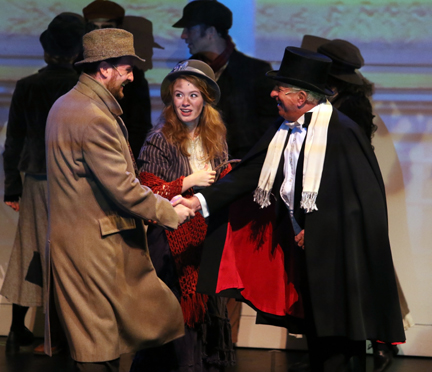
David Leyshon, Ellen Denny, & Terry Belleville in “My Fair Lady” (courtesy of the Capitol Theater)
of humor in this tale of “a pretty pair of babies [in the form of two grown gentlemen] playing [platonically, of course] with [their] live doll.” It’s not just class and gender clashing here; it is temperaments, too – with the dry, ironic, and supercilious Henry Higgins matched to a tee by the fiery, outspoken, and equally willful Eliza. Their battle of wills is often laugh-out-loud funny.
Sarmiento has assembled a talented and appealing cast, with Ellen Denny (as Eliza), David Leyshon (as Henry Higgins), Terry Belleville (as Colonel Pickering) and Sweeney MacArthur (as Doolittle père) note perfect in their respective roles. Other highlights are a seemingly improvisational percussion section that turns “With a Little Bit of Luck” into a high-octane song and dance routine. The fancy ball that closes out the first (of two) acts is a visual treat, with our heroine looking positively regal in a white gown. Couples elegantly dance across the thrust stage while a vain, preening linguist prowls the periphery: Higgins’ pretentious competitor is nicely played by Jay T. Schramek, who played the male lead in the Capitol Theater’s “Crazy for You” last year and had a key role in its “Singin’ in the Rain” in 2015. Kyle Golemga shines in his romantic solo “On the Street Where You Live.” And a young male member of the ensemble (name unknown, alas) exudes notable stage presence. A standout moment of staging comes with “Poor Professor Higgins,” in which a coterie of loyal maids and butlers, shown in intriguingly mottled light, serve as a latter-day Greek chorus, commenting on the action. Music director Michael Barber delivers a fine orchestral score to propel the action, while Stephan Dickson choreographs dance moves which range from infectiously raucous to stately and refined.
Romance and humor, song and dance, beautiful costumes and cinematic visuals, affecting performances, and a battle of the sexes: It’s a sure-fire recipe for a darn good time at the theater, courtesy of this talented cast and production team.
John Arkelian is an award-winning author and journalist.
Copyright © 2017 by John Arkelian.
Editor’s Note: “My Fair Lady” runs through June 24th; “Steel Magnolias” runs from July 4th through 22nd; and the Capitol’s 2017 summer season concludes with the stage musical “Disney’s Beauty and the Beast” on August 8th through September 10th..
The Capitol Theater is located in the picturesque town of Port Hope, Ontario. For information about upcoming events, call 1-800-434-5092; or visit http://capitoltheatre.com/
*****************************************************
The Odd Couple at the Capitol Theater
© A capsule review by John Arkelian
Toronto’s esteemed Soulpepper Theater sent its show on the

Albert Schultz & Diego Matamoros in “The Odd Couple” — photo by Cylla von Tiedemann (courtesy of Soulpepper Theater).
road when its very entertaining production of Neil Simon’s perennial comedy, “The Odd Couple,” took up residence at the Capitol Theater in Port Hope, Ontario on October 27-30, 2016. With two of Soulpepper’s founders, Albert Schultz and Diego Matamoros in the leads, we were guaranteed a good time at the theater. They brought conviction, timing, and well-honed acting chops to this warring pair – the neurotic neat-freak Felix Unger and his free-and-easy friend Oscar Madison, who is driven half crazy by his none too compatible choice of houseguest. The playwright is a sure-hand, of course, and the script is full of quips, retorts, and one-liners. Lines like “Don’t drive me crazy before you move in,” “I’m cooped up here with Mary Poppins 24 hours a day,” “You gotta cook gravy. It doesn’t just ‘come,’” and “You want to live through the night, you better tie me up and lock all your doors and windows” are delivered with gusto. And the leads are backed by strong supporting players, with Derek Boyes, Kevin Bundy, Oliver Dennis, and John Jarvis as the rest of their poker circle, and Raquel Duffy and Sarah Wilson as the wild English roses (the Pigeon sisters) upstairs. All three acts take place in Unger’s apartment – and the set design gives it a very authentic, lived-in feel. All in all, the production breathed new life in a familiar and fondly remembered story.
In a past season, the Capitol (a venue that’s always a pleasure to visit) hosted a touring production of Soulpepper’s “Kim’s Convenience” (which was recently reborn as a very good weekly sitcom on CBC-TV). What a treat to see them in our own neighborhood. Let’s hope more touring shows are in the Capitol’s future plans.
Copyright © 2016 by John Arkelian
*****************************************************
The Shadow Walk of Millbrook
© Reviewed by John Arkelian
The inimitable 4th Line Theater left the farm in late October

The Shadow Walk of Millbrook — photo by Wayne Eardley (Brookside Studio).
2016 for The Shadow Walk of Millbrook – a theatrical experiment on the fringes of the picturesque town of Millbrook, Ontario. Each evening, a group of about 75 peripatetic theater-lovers assembled outside the Victorian-looking Old School to begin a 90 minute walk in the dark. In a fanciful blend of humor, fractured history, and sheer All Hallow’s Eve seasonal fantasy, our jovial guide led along winding paths, down hills, beside the stream, across fields, and into the woods in his ghost-busting mission to uncover and banish spectral sprites and fancies that lurked there. A spectral child appeared at the window high above before the crowd even began its chilly journey. Three ghostly ballerinas did pirouettes on an islet, rising from the reeds like nocturnal swans of the stream.

The Shadow Walk of Millbrook — photo by Wayne Eardley (Brookside Studio).
One of the best bits was an encounter with a pair of tipsy Irishmen (meant to be inebriated versions of the township’s own hymn-smith Joseph Scriven and early Canadian politico Sir John A. MacDonald. But the prize for best Halloween-mood encounter involved three young women curled-up in web-like nets and dangling aloft in a forest clearing like Cirque de Soleil acrobats. They unwound themselves and assumed zombie-like behavior, chasing the lot of us from the forest in short order.
It was an entertaining night out – and an off-farm experiment that’s well worth repeating. But why not make more use of Millbrook Old School, by, say, holding a monsters’ ball inside? Audience members could mingle with undead actors, and be offered some simple
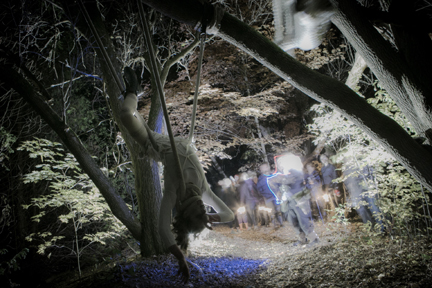
The Shadow Walk of Millbrook — photo by Wayne Eardley (Brookside Studio).
refreshment in the process. And, why not move further into town, by adding stops along the town’s heritage-filled main street? And it might be worth adjusting the thematic blend of humor, history, and mild, half-serious chills. Why not tone down the broad and boisterous humor for a more serious tone? If 4th Line wants to broaden its audience catchment area for this event, why not get licensing rights to incorporate elements (and characters) from well-known genre franchises as the Gothic drama “Dark Shadows” (but not its awful 2012 parody) or the current hit “The Walking Dead?” The popularity of the former 50-year old franchise is still such that fans in the U.S. would flock here to attend a Shadow Walk reoriented to recall their beloved series – a series, incidentally, that made a star out of the late Canadian Shakespearian actor Jonathan Frid, as the haunted, tragic anti-hero who happened to be a vampire.
4th Line’s in-house musical talent tagged along on the Shadow Walk with some folksy, accordion-driven musical accompaniment, but something darker and more classical would serve even better (something like Robert Cobert’s classic orchestral score for the 1966-71 iteration of “Dark Shadows” – brooding, eerie, and darkly romantic music that fit its Gothic horror theme note-perfectly). Also, it might be wise to move the outdoor event ahead a few weeks, to, say, late September. Its current late-October perch made for some damp nights – and one bone-chillingly cold one. But the weather didn’t hamper the ‘good spirits’ (pardon the pun) of the audience or cast.
Copyright © 2016 by John Arkelian.
*****************************************************
“Graeme of Thrones”
© Reviewed by John Arkelian
“Winter is coming,” and so is a new season of HBO’s hit series “Game

Libby Northedge (Byony), Ali Bryce (Graeme), & Michael Condron (Paul) in “Graeme of Thrones” (photo by Paul Wilkinson).
of Thrones.” For aficionados, the next best thing to being there is now on stage at Toronto’s Panasonic Theater. “Graeme of Thrones” is at once a comedic parody of George R.R. Martin’s fantasy world of Westeros, and, strangely, a loving tribute to its characters and storylines. A cast of three actors – Ali Bryce, Libby Northedge, and Toronto-born, Ireland-raised Michael Condron – play multiple roles with gusto, channeling a mock-serious, Monty Pythonesque knack for the absurd along the way. While swords, fur-lined cloaks, and a certain throne (beware the pointy ends) look authentic, the rest of the props and attire look like they spring from Mr. Dress-up’s box of tricks. And that’s the point. The framing premise here is that an ardent fan recruits two friends to do a G.O.T. tribute, despite a dearth of infrastructure, financial resources, or theatrical experience: It’s meant to be an awkward, ultra low budget tribute

Michael Condron in “Graeme Of Thrones” (photo by Paul Wilkinson).
to the fantasy saga, and we, the audience, are cast as a theater full of potential investors. Truth be told, though, this framing device, positing a show within a show, adds nothing of value to the mix. We like it best when the trio is in character, or, as it were, characters.
Before it begins, fourteen banners (most with recognizable sigils, or heraldic symbols, of Great Houses from the series) hang above the stage, while as dramatic music plays over fog effects. The fan in us wishes it were actual music from the series. Then, our wish is granted, as Ramin Djawadi’s thrillingly addictive theme from the series comes over the speakers. Events from the entire first season (and odds and ends from later ones) are compressed into a single show (two hours, including intermission), with such memorable moments as an opening encounter with a White Walker beyond the Wall, a litter of dire-wolves, a really good vocal imitation of Sean Bean’s noble-hearted Ned Stark, an over-inquisitive boy’s tragic tumble from a great height, an amusing (deliberately amateurish) decapitation stunt, the fiery rebirth of the ‘Mother of Dragons,’ and an unfolding tangle of scheming, treachery, promiscuity, ruthlessness, and (occasionally) honor. We even get a (deliberately clumsy) demonstration of the technique (used to good effect in “The Lord of the Rings” movies) of “forced perspective” (in which, put simply, someone is made to look smaller by situating them further from the viewer than the person they are supposedly standing next to). And getting the audience involved in creating sound effects in one scene was entertaining. The result? Why, the show is laugh-out-loud funny. Ali Bryce’s gentle, soft-spoken earnestness is particularly appealing: He’s all a-fluster as things go wrong (repeatedly) with his plans for the best Game of Thrones tribute ever.
There are missteps here: A bizarre (and overly protracted) scene with Sansa Stark’s first menstrual period is kind of dumb. The same decidedly goes for a digression to needlessly inform us about the point of view of the boar that killed a king, a scene that ends in an icky depiction of ham sandwich gluttony. Humor also goes off the rails in a scene that has the two males in nude suits, with exposed, oversized prosthetic genitalia. (This show is not for minors!) An S&M scene likewise struck us as off-putting. Part of the conceit here is that the sole distaff member of the cast is a bit of a diva, but that notion is done to death: It’s a case in which less would have been better than more. Even some scenes that amuse – like a couple singing their love in Dothraki to the tune of pop songs from the real world – would have benefited from some trimming. The idea is funny, but its execution needn’t have gone on as long as it did. But, then, that’s the nature of the comedic: To try everything and see what works. And, what does or does not work will be in the eye of the beholder. Most of what’s here worked very well indeed for this particular observer. As a wag in the audience was overhead to remark afterwards, “this will teach Game of Thrones not to take itself so seriously.” Be that as it may, fans of the series and Martin’s books should not miss “Graeme of Thrones.” Get thee thence.
Warning – For ages 18+: Coarse language; simulated nudity; sexual content; and violence.
“Graeme of Thrones” plays through Sunday, October 23, 2016 at the Panasonic Theater, 651 Yonge Street (s. of Bloor St.), Toronto, Ontario. For tickets, visit mirvish.com or call 1-800- 461-3333.
Copyright © 2016 by John Arkelian
*****************************************************
Thank You for the Music:
Mamma Mia! on Stage at the Capitol Theater
© Reviewed by John Arkelian
Artistic Director Antonio Sarmiento has done it again. His
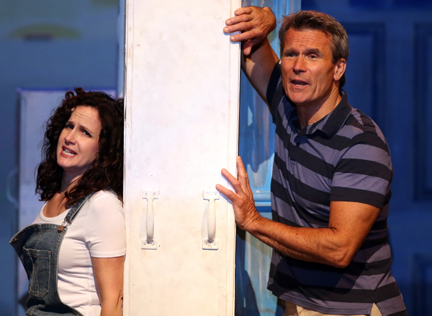
Cara Hunter (Donna) & Kent Sheridan (Sam) in “Mamma Mia!” (courtesy of the Capitol Theater).
production of “Mamma Mia!” at Port Hope’s Capitol Arts Center is a rollicking good time. It’s got two dozen or more utterly infectious songs; a cast of professionals who can really sing, dance, and act; the director’s trademark innovativeness when it comes to the use of projected backdrops; and moments of electrifying high energy. It opens with projected credits that perfectly mimic the opening of a Hollywood movie. (Film buffs will get a kick out of that creative touch.) And filmic technique is present throughout the production, thanks to filmed backdrop scenes shot for this production on the Greek isle of Santorini: A small boat drifts slowly in the gently rippling waves under a cerulean sky and floating clouds; later we see whitewashed buildings with blue roofs clinging to the craggy cliff-

AJ Bridel (Sophie) & Jonathan Gysbers (Sky) in “Mamma Mia!” (courtesy of the Capitol Theater).
sides; and there are the iconic Greek windmills and high-speed transitions to dusk as clouds scud across the sky in front of glorious sunsets. It’s lovely, evocative stuff – and it sure sets the mood for the story’s blend of humor, romance, and poignancy set on a small Greek island.
As a musical, “Mamma Mia!” is really all about the songs. The story itself is pretty slender – it’s really just an excuse to string together the greatest hits of that Swedish wonder-band ABBA (there was only one song here that we did not recognize). The protagonists are a single mother, Donna (Cara Hunter), who runs a small hotel, and her daughter Sophie (AJ Bridel, whom we instantly recognized as one of the finalists from CBC-TV’s “Over the Rainbow” talent

Krista Leis and other cast members in “Mamma Mia!” (courtesy of the Capitol Theater).
competition). Sophie is about to get married; gleaning information from her mother’s diary about past trysts, Sophie has secretly invited the three men who could be her father. Meanwhile, her mother’s two best friends arrive to help celebrate the nuptials. Old memories reawaken, new feelings are kindled, and much frivolity ensues, punctuated at times by some touchingly poignant moments – like a mother’s bittersweet letting-go of a daughter who is embarking on adulthood to the tender song “Slipping through My Fingers.”
An early stand-out scene, to the song “Lay All Your Love on Me,” starts as a duet between Sophia and her beau (Jonathan Gysbers’ Sky). They are soon joined by male chorus members in swimming
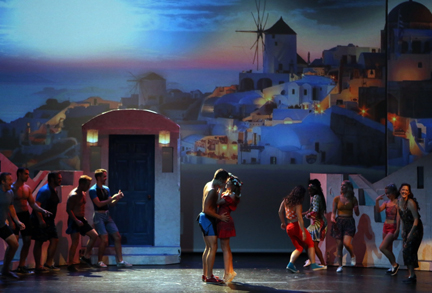
From the Capitol Theater production of “Mamma Mia!”
trunks and scuba flippers – curious footgear that’s used to choreographically creative (and very funny) use. And the projected backdrop is used to especially strong effect here, because it is unobstructed, with lush white sand, aquamarine water, and gentle lapping waves all on glorious display. Earlier, a scene between Sophie and two friends has alternating sections of spoken dialogue and singing. But the music continues at full volume during the spoken sections, requiring the speakers to talk loudly, and the result is a tad distracting. This cast is admirably adept with the three-fold tasks of singing, acting, and dancing. At isolated moments (as when the men do a refrain of “Mamma Mia” midway through the first act), the delivery, while musically very good, comes across as a tad
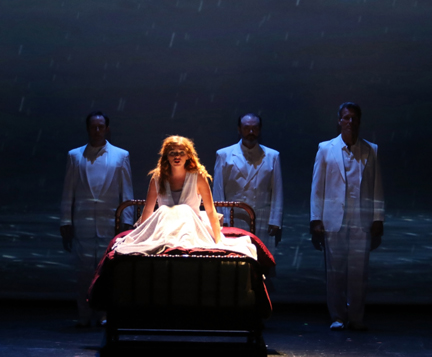
AJ Bridel (Sophie) with Rob Torr (Harry), Sweeney Macarthur (Bill), & Kent Sheridan (Sam) in “Mamma Mia!” (courtesy of the Capitol Theater).
mechanical. Here and there, there’s almost a sense of an in-concert performance rather than an in-play one. Some of that simply comes with the nature of this musical itself, which, as we have said, is essentially a presentation vehicle for ABBA songs; while some may simply reflect the fact that we saw the production very early in its run. In one scene, the projected background has an interesting multi-layered, three-dimensional look, as portions of it are projected onto physical portions of the set. If technically feasible, it would have been a very nice touch to digitally paint-in silhouettes of Sophie and Sky walking down the projected pier at the musical’s end, since the performers were obliged to stop when they neared the screen.
One thing is certain: There is abundant talent in display here. The
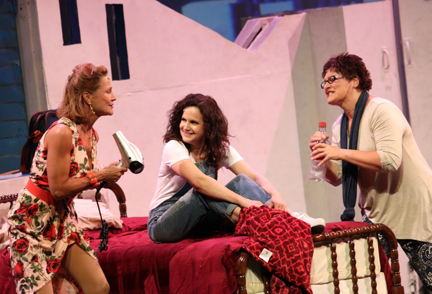
Jayne Lewis (Tanya), Cara Hunter (Donna), & Denise Oucharek (Rosie) in “Mamma Mia!” (courtesy of the Capitol Theater).
two leads are appealing; while Donna’s friends Rosie (Denise Oucharek) and Tanya (Jayne Lewis) feel more authentic and amusing than their big-screen counterparts (i.e. from the 2008 movie version of this musical), who came across more as caricatures. Donna’s three past suitors (from 20-odd years ago) – Sam (Kent Sheridan, who gives a rock-and-rollishly gravelly rendition of “The Name of the Game”), Bill (a really entertaining Sweeney Macarthur as a Scot instead of the film’s Swede), and Harry (Rob Torr, whom, we think, actually plays the guitar to good effect in one scene) – are likewise very good. Tanya shines in an age-inappropriate pas de deux with a much younger man in “Take it Easy,” a comedic number that’s very catchy and very well choreographed by Julie Tomaino (who did the same honors for last season’s “Singin’ in the Rain”). Meanwhile, Rosie and Bill exude comedic charisma in all of their scenes together, as a couple on the verge of ‘taking a chance’ on a mid-life romance. Elsewhere in the cast, it’s a treat to see returning faces from other Capitol productions, especially Jay T. Schramek, whose tap dancing prowess wowed us as the lead in last month’s “Crazy for You,” and the hard-to-take-your-eyes-off-her Krista Leis, who has stage presence and charisma to spare.
There are numbers here that are worth the price of admission all by themselves: One of them is that aforementioned men in flippers routine. Can they top it? Yes, they can. And do – with the high octane number “Voulez Vous.” It comes right before the intermission, and this big ensemble scene is a showstopper, one that will leave you breathless with excitement. And, the sexy nubiles in the likewise high-energy piece “Gimme Gimme” conjured a bacchanalian delight. Harry and Donna share an emotive scene with “Our Last Summer.” On occasion, as in “Knowing Me, Knowing You,” a solo or duet is accompanied by an offstage (and unseen) chorus, an effect that puts added feeling into those numbers and really sells them. The chorus is also used innovatively for “I Do, I Do, I Do,” prompting Donna to say the ‘magic’ words. This production always peaks when its full cast is on stage; those are the moments when the accelerator goes down, and the energy positively sizzles. That’s nowhere more apparent than in the grand finale’s return to the show’s title song and the other crowd-favorite “Dancing Queen.” The effect is electric! Mind you, there are no slouches when it comes to solos or duets, either: Sophie’s solo rendition of “I Have a Dream” is wonderfully emotional, a good counterpoint to Donna’s earlier poignant scene with her very strong solo piece “The Winner Takes it All.” As we said, “Mamma Mia!” is all about the songs – and they are delivered with gusto, élan, and sheer talent here. Don’t miss this production!
John Arkelian is an award-winning journalist and author.
Copyright © 2016 by John Arkelian.
Editor’s Note: The ABBA-inspired musical “Mamma Mia!” runs through September 10; the Pulitzer and Tony Award winning play “August: Osagee County” runs from September 27 through October 7 in the Capitol’s Sculthorpe Theater (upstairs); and a touring Soulpepper production of “The Odd Couple” visits the Capitol on October 27-30, 2016.
The Capitol Theater is located in the picturesque town of Port Hope, Ontario. For information about upcoming events, call 1-800-434-5092; or visit http://capitoltheatre.com/
*****************************************************
They Got Rhythm! “Crazy for You” is a Hit at Port Hope’s Capitol Theater
© Reviewed by John Arkelian
It’s a certifiable hit! Artistic Director Antonio Sarmiento’s

Cast members from “Crazy for You” (courtesy of the Capitol Theater).
production of “Crazy for You” is the best time you’ll have at the theater – any theater – this summer. (And there’s still more to come in Port Hope’s 2016 summer season at its Cameco Capitol Arts Center!) This musical is really just a way of combining a cavalcade of great Gershwin songs (“Embraceable You” and “I Got Rhythm” to name but two): The result is all about the songs, the dancing, the romance, and the delightful staging. Our leading man, Bobby Child, is being groomed for a career in banking (the family business), but his heart lies elsewhere – on Broadway, to be precise. When a banking foreclosure takes him (reluctantly) to Deadrock, Nevada, it’s about as far from the bright lights, big city, as one can get. But that’s where he unexpectedly finds not only his destiny in musical theater but also the gal of his dreams, in the feisty person of Polly Baker. Jay T. Schramek (one of the leads in the Capitol Theater’s memorable 2015 production of “Singin in the Rain”) is firing on all cylinders again this year as Bobby – with acting, tap dancing, and singing of Broadway caliber. He is winning in the role.

From the Capitol Theater production of “Crazy for You.”
So is Natalie Daradich as Polly, the woman he woos and wins. And every other member of the cast positively shines, too! (Krista Leis, as showgirl Patsy, and Mark Weatherley as one of two incarnations of impresario Bella Zangler, get special mention, but the entire ensemble does standout work.) Let’s see more of this company of players – please!
The musical starts in the Big Apple, with New York streetscapes and big city hustle and bustle effectively conjured by Sarmiento’s characteristically deft and innovative hand with projected backgrounds. This time round, those backgrounds (whether they’re urban avenues of the stars, or literal star-fields, backstage theatrical settings, or a dusty, sun-burnt western town) draw us into the story
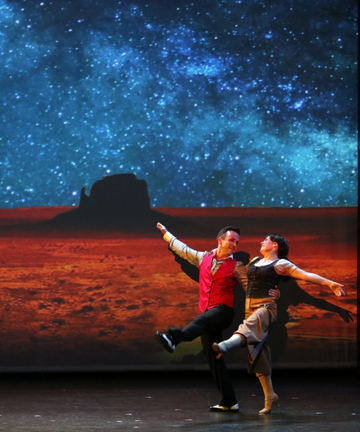
Jay T. Schramek (as Bobby) & Natalie Daradich (as Polly) in “Crazy for You” (courtesy of the Capitol Theater).
like an irresistible magnet. And they work in perfect tandem with the physical sets and screens, which twirl and turn and glide into place, magically transforming one setting into another in ways that perfectly reflect the sheer theatrically of the musical: The production’s scene changes are a treat to watch. Bobby and a sextext of sexy showgirls (male hearts were aflutter at the pulchritude of the fair sex) tap dance against a field of swirling stars in a night sky. And the foot goes down on the proverbial accelerator as these performers propel us into high energy song and dance numbers with rousing enthusiasm and a virtuoso artistry that’s simply infectious. When the action moves to the Southwest, a projected train rushes towards us, accompanied by some stand-out sound effects (courtesy of sound engineer Lance Jeffrey, we presume) that persuasively conjure the real thing.
The story’s love-at-first-sight dynamic will appeal to all true romantics. And the production’s direction (by Sarmiento),
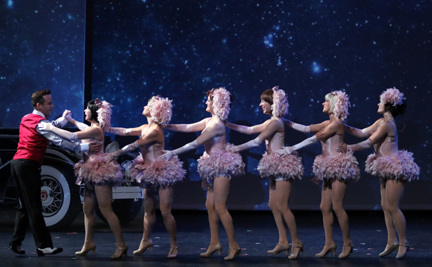
A fantasy under starlight from “Crazy for You” (courtesy of the Capitol Theater).
choreography (by Stephanie Graham), and music direction (by Michael Barber) combine to create something wonderfully exciting, lively, colorful, and fun. Kudos, too, to Alex Amini’s costumes and Jareth Lee’s lighting design. The show’s jokes are simple but effective. (Someone exclaims, “I did not come here to be insulted” to which a wag replies, “Oh, where do you usually go?” Later, someone remarks, “You are close to an idiot!” which prompts the object of that scorn to take an exaggeratedly large step away from his nearest neighbor.) The production’s show-stopping number comes right before the intermission. With its improvised percussion (using metal cookie sheets and everything else at hand), and a bravura display of fast and furious singing and tap-dancing, “I Got Rhythm” sends a full current electrical charge through the audience: It’s a miracle we didn’t leap to our feet and join in! That number is worth the price of admission all by itself. But there’s still more to come, what with a playful barroom brawl between showgirls and cowboys, a bit of British stiff upper lippiness that leaves the leads atop chairs that are atop a table, a heartfelt rendition of “Not for Me” from Polly, a fantasy in pink to the strains of “Nice Work if You Can Get It,” and a big finish with the girls in silver wings. Wow! If they’d offered to repeat the whole show then and there, nary a soul would have budged from their seat. For here is a production that’s every bit as good as anything you’d see it New York or Toronto! It’s a sheer high energy delight. Don’t miss it!
John Arkelian is an award-winning journalist and author.
Copyright © 2016 by John Arkelian.
Editor’s Note: “Crazy for You” runs through July 23; the ABBA-inspired musical “Mamma Mia!” runs from August 6 through September 10; the Pulitzer and Tony Award winning play “August: Osagee County” runs from September 27 through October 7 in the Capitol’s Sculthorpe Theater (upstairs); and a touring Soulpepper production of “The Odd Couple” visits the Capitol on October 27-30, 2016.
The Capitol Theater is located in the picturesque town of Port Hope, Ontario. For information about upcoming events, call 1-800-434-5092; or visit http://capitoltheatre.com/
*****************************************************
Ordinary Heroes: Local History, Drama, and Music at 4th Line Theater
© Reviewed by John Arkelian
Ordinary heroes are just like you or me, but they rise to the occasion

Monica Dottor & Liam Davidson in “The Hero of Hunter Street” (photo by Rebekah Littlejohn).
when catastrophe strikes, forgetting about self preservation as they rush to the aid of others. Ordinary heroes have been in the news in recent days as they lay prone atop the body of a shooting victim and her young son to protect them from a sniper’s bullets even as they put themselves into harm’s way. Ordinary heroes are also the stuff of 4th Line Theater’s first play of the summer – “The Hero of Hunter Street.” Set in the small city of Peterborough, Ontario, and based on real events, the story takes place in 1916, in the days leading up to a sudden disaster on December 11th of that year – an explosion and fire that demolished the city’s Quaker Oats factory, killing 24 men and badly injuring many others. It’s one of those long lost moments of regional history which 4th Line is so adept at finding
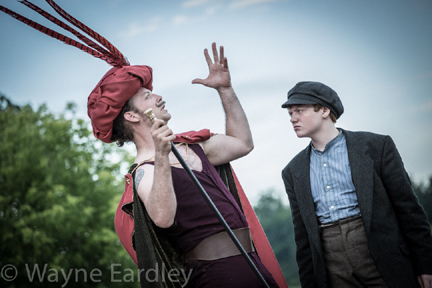
Mac Fyfe & Liam Davidson in “The Hero of Hunter Street” (photo by Wayne Eardley).
and turning into live theater at its outdoor venue amidst the green hills of Cavan Township. “The Hero of Hunter Street” was written by Maja Ardal (who also contributes the original music and lyrics) and directed by Kim Blackwell.
It opens with many workmen bringing carts (laden with foodstuffs headed for market), barrels, and bits and pieces of set dressings. There’s a simple percussive beat as they bustle about: Innovative use of percussion is used at intervals throughout the play, to very good effect. Already in place along the permanent barn balcony are a series of old-fangled sewing machines and a skeletal clock tower. A narrator sets the scene for us and leads us through the story, occasionally snapping his fingers to freeze the cast in place while he
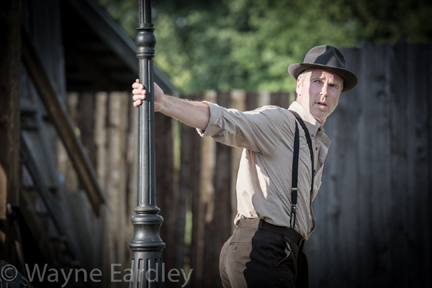
Ryan Hollyman in “The Hero of Hunter Street” (photo by Wayne Eardley).
elaborates on this point or that or redirects the players. He’s the voice of hindsight struggling to guide the players into better paths. It’s a warm evening, so it takes some suspension of disbelief to fully accept the townsfolk going about their Christmas preparations, thanks to the unmistakable seasonal disconnect between story and reality. But the director and company do a very good job with staging. The hallmark of this production lies in its small details of activity. At one point nine men yield shovel in a pantomime of digging while an assembly line of others move sacks of flour (or oats). On a long balcony above, girls and women turn rolls of cloth into sacks. (In one misstep, the narrator is briefly “disguised” as a woman: It’s too broad an attempt at humor.) The overall effect is
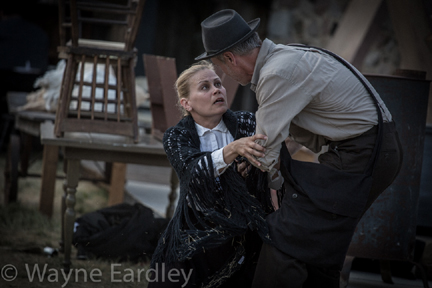
Monica Dottor & Ryan Hollyman in “The Hero of Hunter Street” (photo by Wayne Earley).
to capture the spirit of human industry (or industriousness), as we see the large cast of 44 actors “working day and night to feed the country and our boys at the front.”
In its early sections, especially, the play comprises a consecutive series of vignettes, surveying every nook and cranny of peoples’ lives, even the excitement among the young over the impending arrival (announced by a banner) of Ajax the Strongman. Leads Monica Dottor and Mac Fyfe appear in dual (and mighty diverse) roles – as an Irish-Canadian working class couple, Laura and Dennis O’Brien – and as Gertie and Ajax the strongman, a colorfully flamboyant (and funny) couple of larger than life entertainers who are paying this mundane community a visit. As Gertie, Dottor
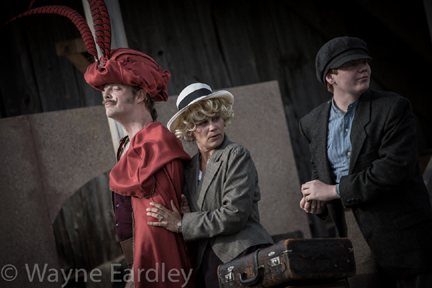
Mac Fyfe, Monica Dottor, & Liam Davidson in “The Hero of Hunter Street” (photo by Wayne Eardley).
seems to be channeling television’s Gloria Bunker in accent and attitude. Dottor has a wistful, bittersweet song, “16 Years,” as Laura. It starts a tad weak but gains stream when she is briefly joined by several other woman. It’s a poignant vocalization of an ordinary woman’s love for her husband and children and her everyday worries about making ends meet. It’s followed by another nice moment – the very convincing sound of an approaching train, complete with a convincing rumble which we feel in our bones. And, there’s more of that effective use of inventive percussion: cutlery, tools, and even newspapers all help to keep the beat. And remember those effective little moments we mentioned? There’s another one with people carrying sacks of oats – held aloft, they do double-duty, becoming stylized pillows, supporting the heads of upright sleepers.
The play’s strongest relationships are those in the dual roles played
by the leads – one serious, the other comedic. One wishes the play had focused even more tightly on the O’Brien clan – husband, wife, grandfather, and kids. They are the heart of this story. As the head of that household, Dennis gets a poignant solo of his own with “The Key to Your Castle.” Elsewhere, Dottor and two girls put aside their cares for a moment’s dance with brooms as props; the females all sigh in unison at a romantic passage in a story being read aloud; a factory gate guard has trouble distinguishing between a German bomb and an Irish stew; and clotheslines appear over the audience’s heads.
Besides those mentioned already, Geoff Hewitson (as Laura’s father William), Hilary Wear (as Sophia Loreno, another ordinary hero, in the form of the Italian-Canadian immigrant who puts her foreign, and therefore unaccredited, nursing training to vital use when it is most needed), Frances Loiselle (as the O’Briens’ eldest daughter Irene), Ryan Hollyman (as the narrator), and Matt Gilbert also stood out. There’s a half-hour rain delay, which sends the audience good-humoredly scampering for shelter. When the play resumes,

Monica Dottor in “The Hero of Hunter Street” (photo by Wayne Eardley).
the factory blows, and lives are lost or saved, while others are forever changed in the aftermath. One local hospital seeks to redirect Italian (Catholic) patients elsewhere, a bit of sectarian discrimination that’s played for laughs, though, in the real world there’d be nothing funny about it. And we see the play’s foremost ordinary hero, Dennis O’Brien risking his own life to save his co-workers. If he perishes, will his family thank him for that heroism? A roll-call of the dead is well done, though the mood soon swings, as it so often does in real life, to the absurd, as a man-sized pig is hoisted aloft by ‘Ajax the not-so-strong.’ The end result? One of 4th Line’s typically entertaining blends of local history, human drama, comedy, and original music. Did we say original? That’s the very byword of what 4th Line does!
John Arkelian is an award-winning journalist and author.
Copyright © 2016 by John Arkelian.
“The Hero of Hunter Street” runs through July 23. 4th Line Theater’s second production of the summer, ““The Bad Luck Bank Robbers,” runs August 2 through 27, 2016. 4th Line Theater is situated on the Winslow Farm, 779 Zion Line, just outside the picturesque village of Millbrook, Ontario. For more information and tickets, call 1-800-814-0055, or visit http://4thlinetheatre.on.ca/
*****************************************************
“On Golden Pond”
© Reviewed by John Arkelian
Aging with as much grace as we can muster is the subject of Ernest

Norman (John Winkworth) & Ethel (Jennie Ryan) Thayer in the Capitol Theater production of “On Golden Pond.”
Thompson’s warm, funny, and sometimes poignant play “On Golden Pond.” Best known to us from its 1981 movie adaptation, it’s a summer in the life of an aging couple at their summer retreat on a lake in Maine. He’s older than her, and his age is starting to show. His heart isn’t what it was, and neither is his memory: he returns from a solitary berry-hunting ramble in the once familiar woods shaken by his sudden inability to recognize terrain he once knew as well as the proverbial back of his hand. He’s a bit of a cantankerous “old poop,” as his wife affectionately calls him, but his half-playful orneriness seems to a lifelong characteristic: “We’re not ‘old.’ You’re old, and I’m ancient!”
The opening entrée in Port Hope’s 2016 summer season at its

Peter Kedwell as Charlie Martin in “On Golden Pond” (courtesy of the Capitol Theater).
delightful Cameco Capitol Arts Center mixes humor with serious moments, like the long overdue reconciliation between a father and daughter. In the frank exchange that opens the way for healing in their strained relationship, he tells her, “I didn’t know we were mad at each other. I just thought we didn’t like each other.” The play starts slowly: Just as the couple has to become reacquainted with life ‘on the pond,’ with its testy telephone operators, perpetually broken screen door, old treasures (books for one, a childhood doll for the other), and the immediacy of nature, in all its pleasant (the call of the loons) and unpleasant (mosquitoes galore) forms, so, we, too, need time to get comfortable with these characters and the gentle rhythm of their lives. Things feel a tad

Jennie Ryan & John Winkworth in “On Golden Pond” (courtesy of the Capitol Theater).
stiff at first, like clothing we haven’t tried on for awhile, but very soon we are won over by the engaging cast and their characters’ sometimes teasing, sometimes affectionate interactions. One of the play’s funniest moments comes with the patriarch’s serial interruption of a new arrival (his daughter’s new beau). And there’s a good laugh when he tries saying his wife’s name (‘Ethel Thayer’) with a mock lisp.
There’s a small real pond atop the orchestra pit: it isn’t really used in the play, but it helps set the mood for the audience. We were wowed by projected cloudscapes and star fields and arboreal landscapes – beautifully evocative use of projected film effects of the sort Artistic Director Antonio Sarmiento is so very good at. But might they have had even greater impact if they’d been on more prominent display? Much of the projected scenery was blocked by the set itself. Might replacing the cottage’s solid back wall and doors with a floor to ceiling picture window, with the projected lake and forest then on unobstructed full display have enhanced the connection of these characters to this place?
The cottage set design looks suitably ‘cottage-like.’ And the cast, who seem to mostly hail from the surrounding region, acquit themselves very well, with John Winkworth as Norman and Jennie Ryan as Ethel. Everything turns on them, as one or both of them are on stage in practically every scene – and they make these roles (as a couple of “old characters”) their own, rather than attempting to channel their illustrious filmic forbears (Henry Fonda and Katherine Hepburn). Peter Kedwell is amusing as the nautical mailman, while Alyssa McCallum (Winkworth’s real-life daughter playing his fictional one here), Talen Waller (her second convincing appearance at the Capitol as a boy, after her appearance in “Mary Poppins”), and Shaun Savoy all do solid work.
“On Golden Pond” is an auspicious start to the Capitol’s new season. What a treat to have such delightful theater so close at hand, for those of us who live east of the metropolis. Indeed, these shows are easily strong enough to draw the big city crowds out here to small town Ontario!
John Arkelian is an award-winning journalist and author.
Copyright © 2016 by John Arkelian.
Editor’s Note: “On Golden Pond” runs through June 17. The Gershwin musical comedy musical “Crazy for You” runs from July 2 through July 23; the ABBA-inspired musical “Mamma Mia!” runs from August 6 through September 10; the Pulitzer and Tony Award winning play “August: Osagee County” runs from September 27 through October 7 in the Capitol’s Sculthorpe Theater (upstairs); and a touring Soulpepper production of “The Odd Couple” visits the Capitol on October 27-30
The Capitol Theater is located in the picturesque town of Port Hope, Ontario. For information about upcoming events, call 1-800-434-5092; or visit http://capitoltheatre.com/
*****************************************************
You’ll Laugh Till it Hurts – “Gimme That Prime Time Religion”
© Reviewed by John Arkelian
Who’d have guessed that a show about a traveling evangelical
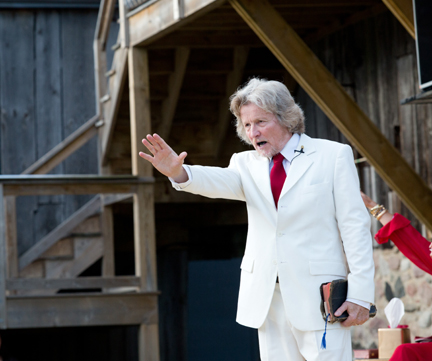
Robert Winslow as Bobby Angel in “Gimme That Primetime Religion” (photo by Miranda Studios, courtesy of 4th Line Theater).
preacher could be so side-splitting funny? But that it is – in spades! It may be satire, but it’s also affectionate toward its spiritual slicksters. We are laughing so hard it hurts at their over-earnest antics, but we can’t help but like them, too. There’s more than a bit of the ‘loveable jackass’ (and/or ‘loveable rogue’) among the ranks of the ‘Bobby Angel Miracle Crusade.’
A gentle breeze caresses the audience seated at the edge of the meadow, clouds hurry past, and swallows practice their daredevil aerobatics overhead. We’re here to see 4th Line Theater’s second offering of the season: “Gimme That Primetime Religion.” It’s fully a quarter of an hour before show time, but this most unconventional of shows begins early – with a prelude in the form of
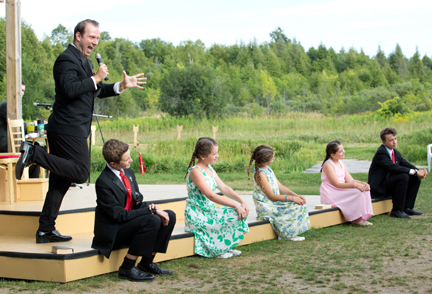
Jeff Schissler in “Gimme That Primetime Religion” (photo by Miranda Studios, courtesy of 4th Line Theater).
a figurative “High Five for Jesus.” The audience gathered for a play becomes the audience gathered for theatrics of another kind: For this is the living, breathing simulacrum of an evangelical revival: There’s singing, testifying, preaching, and healing. And it all begins, with a prologue, as the preacher’s people circulate among the seated audience, faux-Southern drawls in full flourish, greeting us before the main event begins. Their improvisational powers impress us to no end. Most of the preacher’s helpers (the boys are in dark suits and sunglasses, the girls in braids) are youths – some of them just young children. Yet they never break character – and they’re able to improvise on a dime. (We ask one where the collection plate is, and he has a convincing answer at the ready.)

Alison J. Palmer & Robert Winslow in “Gimme That Primetime Religion” (photo by Miranda Studios, courtesy of 4th Line Theater).
The youngsters (very cutely played by Madeleine Bryenton, Maude Rose Craig, Max Czmielewski, Ethan King, and Samuelle Weatherdon) are overseen by the reverend’s right-hand man, Orville. Here’s a bit of brilliant casting if ever we saw one. Orville is hyped-up on Jesus, so animated that he’s got ants in his pants, equipped with a rubber-faced grin that never falters, and positively oozing self-confident earnestness. He dances, he prances; he hilariously improvises an interaction with a red-hatter, complimenting her on her “red fascinator” in his honeyed Southern drawl. He leads the audience in a sing-a-long; and when we don’t meet his musical expectations, he reminds us that, “Folks, you gotta remember who you’re singing to!” The word ‘unctuous’ comes to

Jeff Schissler, Allison J. Palmer, and helpers in “Gimme That Primetime Religion” (photo by Miranda Studios, courtesy of 4th Line Theater).
mind for Orville, for he surely is ingratiating, with a capital “I.” But is his fulsome earnestness insincere? He’s so awash with earnest conviction that he wears it on his sleeve and it flows from his very pores. But he may mean it. He just means it so much that it’s hilarious! Jeff Schissler delivers award-caliber work in the role: He a sight to behold. (As this reviewer’s wag of a seatmate quipped, “His squeaky clean demeanor, complete with slicked-back hair and charming dimple, would lead you to believe he just came from his weekly bath.”) Never have we laughed so long and so hard at the theater! Schissler’s facial expressions alone are a hoot – and note-perfect for his extravagant character.
Schissler’s Orville is worth seeing all on his own: he could handily
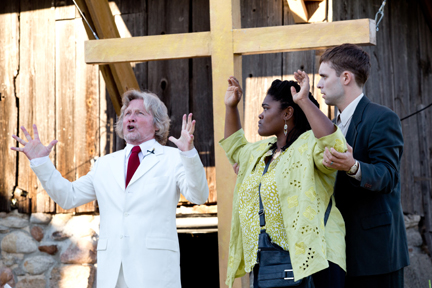
Robert Winslow, Dian Marie Bridge, and Tim Ziegler in “Gimme That Primetime Religion” (photo by Miranda Studios, courtesy of 4th Line Theater).
constitute a one-man show onto himself, a whirling dervish of devotional fervor, with a twinkle in his eye. But Orville has company, and his cast mates bring to this show an embarrassment of deep-fried riches: There’s Orville’s wife Tammy (Allison J. Palmer), a singing, twirling, testifying gal in blonde hairdo and heavy eye shadow. Husband and wife conjure a vision of the proverbial ‘hot place’ with helpers who are clad in shredded strips of red cloth as they twirl red ribbons. The couple does a pantomime dance duet that’s a comedic attempt at something balletic, and long swathes of scarlet cloth unfurl from the balconies. Orville and Tammy are both larger than life. When it’s time to testify, Orville talks about his father’s death as the result of a misadventure with a cotton-picking machine. For her part, Tammy became “loose with my affections” as a camp-follower of music idols, before she arrived at her unforeseen destination as a “groupie of the Lord.” Their sheer extravagance is nicely balanced by the revival’s keyboardist Dean (Tim Ziegler) who gives a shy account of his presumed healing. Dean is very low-key, very subdued, very normal – an understated character who has been caught up in the whirlwind, along with his skeptical wife (Dian Marie Bridge’s Shirley).
Then the main attraction arrives, emerging from a black SUV in an all-white suit. Here’s the Rev. Bobby Angel, charismatically played by 4th Line’s founder and creative director, Robert Winslow. He is returning to a character he first played 35 years ago: “Originally inspired by my anger at the conning of the public by huckster TV preachers in the 1970s, my motives for reprising the show in 2015 are quite different. I am personally interested in faith, character, and the scars that life leaves on us… the canyons of the heart etched in the face, body, and soul…. I will try to show them me, flawed and human….” And the preacher is even more of a force of nature than his lieutenant Orville. Rev. Angel is quick on his feet; and he comes armed with quips: “I don’t need Facebook; I got FaithBook” and “God Almighty won’t be texting you on Judgment Day!” There are hyper-paced admonitions against checking into hell’s hotel; funnily facile answers to prayer requests (with allusions to names recently in the news, like Bill Crosby and Bruce-turned-Caitlin Jenner); the laying-on of hands to drive out afflictions; and a quick pitch for “a very special gift offer” in the form of a lurid (but rather interesting) oil painting depiction of Armageddon. Rev. Angel has no patience for errant ways: “You would think this generation discovered sex! Poke, poke, poke! Stick, stick, stick!” The audience punctuates things at intervals with “Praise the Lord” and “Hallelujah!”
The entire play is an astonishingly convincing recreation of an evangelical revival meeting. Winslow delivers the production’s other award-caliber performance. His evangelist gets roused and riled, rising time and again to a climax of pure preaching fervor. He’s self-aware enough (is he also meant to be deliberately manipulative?) to know when he goes overboard in orgasmic excess, and he always pulls back, settling himself and his audience down with a practisedly sheepish grin. Bobby Angel seems so sure of himself and his message; but Winslow’s performance hints that Angel also desperately needs our approval. But, be his fervor real or feigned, we like Bobby Angel; just as we like Orville and the rest of this wonderfully entertaining Miracle Crusade. Winslow notes that, “[This] play exists in the relationship with the audience, somewhere between performer and observer.” How true! The audience gets so engaged in its hilarity that we become an integral part of the whole thing.
“Gimme that Primetime Religion” is a jewel in 4th Line’s crown – a must-see night of theater. Our only slight cavil is that it loses some of its irresistible momentum late on (there are no intermissions, after all), changing gears when it ought instead to have pushed through to its biggest crescendo and ended with a flourish (or at least a powerful ‘Amen’)! Aside from that misstep, the play was beautifully written by Robert Winslow, Ben Henderson, Marianne Copithorne, Murray McCune, and Edward Lyszkiewicz; and it is directed by 4th Line’s managing artistic director, Kim Blackwell. 4th Line stalwart Justin Hiscox along with Tim Ziegler provide the music. Bravo to Winslow & Company: 4th Line Theater’s “Gimme that Primetime Religion” is one funny and endearing theatrical hallelujah!
John Arkelian is an award-winning journalist and author.
Copyright © 2015 by John Arkelian.
4th Line Theater’s second production of the summer, “Gimme That Prime Time Religion,” runs through August 29, 2015. 4th Line Theater is situated on the Winslow Farm, 779 Zion Line, just outside the picturesque village of Millbrook, Ontario. For more information and tickets, call 1-800-814-0055, or visit http://4thlinetheatre.on.ca/
*****************************************************
Gotta Dance! Capitol Theater brings “Singin’ in the Rain” from the Silver Screen to the Theater Stage with Style and Verve!
© Reviewed by John Arkelian
Take a love story, wrap it in unashamedly hammy humor, give it
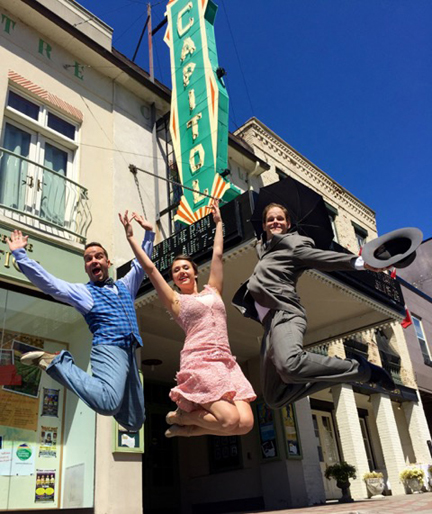
Jay T. Schramek, Kate Blackburn, and Timothy Gledhill in “Singin’ in the Rain” (courtesy of the Capitol Theater).
some high-octane zip with a bevy of irresistibly energetic songs and dance, add a soupcon of Hollywood glamour and all the trappings of the movie business, and what have you got? Why, you’ve got one of the great movie musicals of all time. It’s old-fashioned, good-hearted fun with a capital “F!” Its transposition from the silver screen to the theater stage is a marvel to behold. It opens, cinema-style, with the growl of the MGM lion. Then credits roll on a big screen; but the cast and crew listed are not those from the 1952 movie version. Rather, they are the dramatis personae – on stage and off – of the Capitol Theater’s new hit production of “Singin’ in the Rain.” Now, “That’s entertainment” (as the slogan goes), indeed! Artistic Director Antonio Sarmiento, who produced and directed the
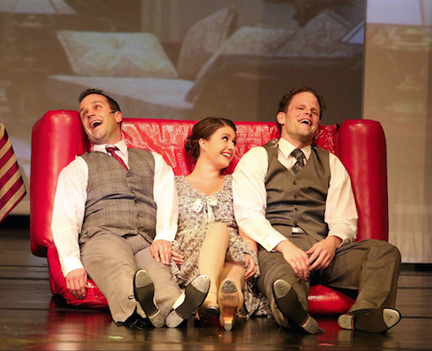
Jay T. Schramek, Kate Blackburn, and Timothy Gledhill in “Singin’ in the Rain” (courtesy of Capitol Theater).
production, has done it again – hitting this one out of the ballpark, to the sheer grinning delight of the Capitol’s record-breaking audiences!
The time is 1927. Hollywood’s big stars stand at the brink of monumental change, or, for some, at the brink of the precipice. All the rules are about to change, with the arrival of “talkies,” which will rapidly displace the silent pictures of yesteryear – and many of their stars. One silent duo, Don Lockwood (Timothy Gledhill) and Lina Lamont (Amanda Struthmann) are famous on-screen paramours. In real life, Don can’t stand Lina. Fate brings him across an aspiring young actress (and current chorus-girl), Kathy Selden (Kate
Blackburn), who seems unimpressed by his star-power. Her disinterest sparks his interest in her – and a love story springs to life; but Lina’s not going to give Don up without a fight. The leading man’s best friend, Cosmo Brown (Jay T. Schramek), came up with Don from vaudeville. And he doesn’t need any prompting to break into the frenetic tap routines that punctuate his verbal patter and wise-guy one-liners (“You have to show a movie at a party. It’s a Hollywood law.”)
The production boasts a dream-cast – too many to list here, but not a weak-link in the entire ensemble. This ensemble’s acting, singing, and dancing skills would be perfectly at home on any of North
America’s big city stages. How lucky for us that we can get up close and personal with them at Port Hope’s intimate theater venue. And each and every one of the players is impeccably cast: Gledhill and Struthmann look just like the matinee idols they portray, Blackburn is every inch the sweet (but feisty) ingénue, Schramek is the loveable clown, with endless reserves of energy, Kent Sheridan is as right as studio head R.F. Simpson as Eric Fink is as veteran director (who’s dressed as if for safari) Roscoe Dexter. And for sheer va-va-voom wow-factor, Allison McCaughey is the dancing stand-out in the role originated by the great Cyd Charisse: She looks like Charisse – with short dark hair, strikingly beautiful features, lithe physique, and legs that never end – and she dances like her, too, with legs that sweep upward at impossible angles! Her dance numbers are breathtaking – and that’s saying something in this company: there are no slouches among the rest of these singing, dancing phenoms, either!
Tap-dancing atop tables; a frenetically acrobatic dance solo to Cosmo’s call to “Make ‘Em Laugh!;” a very funny lesson in diction and elocution for the screechy-voiced Lina (who sounds like she hails from Yonkers or Jersey); romantic scenes, like the one to the lyrics of “You Were Meant for Me;” the buoyant optimism of numbers like “Good Morning, Good Morning” and “All I Do is Dream of You;” a hilarious demonstration of talking pictures by an inventor; and, of course, the famous scene – with man, umbrella, and downpour – that gives the show its title (yes, it does rain on stage!) are among the best moments of this enchanting evening of theater.
But the surprise stand-out of the entire production is the way snippets of B&W silent films are woven into the story. Are these gleaned from actual silent films from the Twenties? They sure look like the genuine article. But, no, these are original mini-productions, performed by this production’s cast – attired in the clothing of pre-Revolutionary France – and directed by Sarmiento. What a treat for cinephiles! In style, content, and élan, these little marvels are worth the price of admission all by themselves. They even have the authentically scratchy, aged look of film clips made nearly one hundred years ago. This reviewer couldn’t get enough of them: They are eminent examples of ingenuity and artistry in design – so much so that we would happily watch an entire faux-silent movie made by this cast and crew!
One of Sarmiento’s calling cards and strengths as a director is his use of multi-media. Motion picture studio sound stages, the exterior of Grumman’s Chinese Theater in Los Angeles (complete with the moving arcs of spotlights), city streetscapes, and the interiors of movie stars’ posh homes: all of these are evoked through the skilled created use of projected images – changing, moving, gliding seamlessly from one locale to another. A particularly effective moment is the illusion of a trio of parallel brick walls – the effect is positively three-dimensional. The slightest of cavils might be the very frugal use in this production of actual (non-projected) physical sets and props. But the masterful use of virtual substitutes practically renders them redundant in their near-absence. Every contributor to this production has contributed to its professional polish: Julie Tomaino’s giddy, glorious choreography, Alex Amini’s eye for glamour in her spot-on costume design, Steven Woodjetts’ musical direction, and Charlene Saroyan’s stage management – all of these, and that marvelous cast (including those not singled out by name here), complement and enhance Sarmiento’s direction – for a production that will leave you on your feet in standing ovation and in full, hearty agreement with the story’s leading man that we “Gotta dance!” This production completely won over your humble reviewer, a theatergoer whose stage preferences don’t normally turn to musical comedy. Bravo!
John Arkelian is an award-winning journalist and author.
Copyright © 2015 by John Arkelian.
“Singin’ in the Rain,” inspired by the famous MGM motion picture, runs through August 29, 2015.
The Capitol Theater is located in the picturesque town of Port Hope, Ontario. For information about upcoming events, call 1-800-434-5092; or visit http://capitoltheatre.com/
******************************************************
The Bard on the Bluffs: Guild Festival Theater’s Romeo & Juliet
© Reviewed by John Arkelian
Two years ago, we were very impressed with the production of “The Misanthrope” mounted by the Guild Festival Theater atop the
Scarborough Bluffs in Guild Park. But the company was deprived of their talented artistic director and founder, Sten Eirik, when he died on April 1, 2015. So this summer’s production (in the theater’s fifth season), of Shakespeare’s “Romeo & Juliet” did not have the benefit of his sure guiding hand. The result was a production that under-whelmed at first, and only gradually grew on us.
Things got off to an unfortunate start even before the play began. The Guild Festival Theater presents its plays outdoors, on a stage framed by imposing stone pillars and arches, in Graeco-Roman style, that were salvaged from some temple of commerce in downtown Toronto years ago. It’s a striking backdrop. Fully half an hour
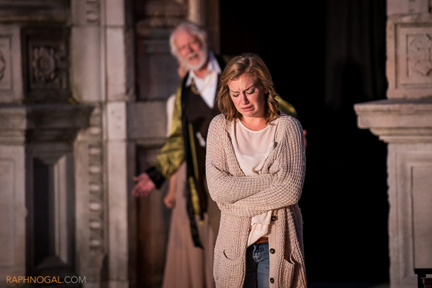
“Romeo & Juliet” — Juliet and Lord Capulet (photo by Raph Nogal, courtesy of Guild Festival Theater).
before the play was due to begin, this reviewer, as well as several other members of the gathering audience, felt impelled to take a picture of the architecturally compelling setting. No closely-guarded production secrets were on display: The stage was all but bare; what prompted the photographic interest of several onlookers was simply the permanent backdrop of the imposing faux-Roman ruins. Alas, company personnel manning the lighting tent behind the audience reacted with harsh (and rather boorish) alacrity to such innocent picture-taking (fully 30 minutes prior to the show), by bellowing at us inadvertent offenders that picture-taking of the empty stage was forbidden! Such a loud, rude, and grossly over-reactive response to such an innocent and natural impulse by
audience members was no way to treat guests – and it soured the mood of those on the receiving end of this unwarranted dressing-down.
This production of the famous play used modern dress. It’s hardly the first time that one of Shakespeare’s plays has been clothed in the garb of an era other than the one in which the story is set. But the casual street-wear (which looked like it consisted of whatever the actors had strolled in wearing) utilized here robbed the story of some of its vital suspension of disbelief. In short, it, and the extremely minimalist set decorations (they mostly consisted of a few pieces of flimsy wooden patio chairs and tables), spoiled the mood. Or, at least, it made establishing the proper mood an uphill struggle. Other misfires include the jarringly abrupt switch from classical music to rap in an early scene; depicting the Prince of Verona as a (literal) policeman who is half-heartedly reading the riot act to unruly youth; a failed attempt at comic relief that has one of Romeo’s friends cross-dressing in an off-putting purple wig and glimmering dress at the Capulets’ ball; and some clumsy staging at self-same ball, that has an unnaturally tight cluster of players in one corner with two prospective lovers sitting side-by-side at the opposite end of the stage: It’s awkward staging – meant to focus our attention on the leads but instead distracting us with the huddle of mute others.
Worse still, at that relatively early juncture, the leads lack any
emotional wallop; they certainly cannot command the all but empty stage at that point. Both actors, but especially Romeo (Jovan Kocic), seem very young. It’s true that their characters are mere teens; but somewhat older actors might more consistently muster emotional substance. Still, both leads improve, in fits and starts, as things progress. The famous balcony scene (atop a balustrade) works better than the ball; Romeo gains some momentum as the scene progresses, though both paramours seem prone to fading slightly at intervals – in conviction and in volume. “Thy beauty has made me effeminate,” says Romeo at one point, but he needn’t have taken it so literally. He does conjure commendably authentic emotion in the wake of his banishment and in the climactic scene at the crypt. Along the way, we get an effective confrontation between Juliet (Lindsey Middleton) and her father (Michael McLeister), and a vigorous defense of Romeo by his friend Benvolio (Emilio Vieira).
There’s a pretty substantial gap in the ages of the production’s players – some are very young (recent graduates of theater studies); others are well-seasoned veterans. Among the latter, Christopher Kelk brings welcome gravitas to the role of Friar Laurence. British-born Laura Meadows also makes a lasting impression in the role of Nurse. With her solid stage presence, she’s reminiscent of her countrywoman, Gemma Arterton. Though she doesn’t have a great deal to do, Kaya Buchoic is also appealing as Lady Capulet.
The second act benefits substantially from nightfall and the evocative interplay of floodlights on the ruins. Some swaths of material are used effectively at one point, in an all too brief nod to the value of some stage ornamentation. The production’s conviction gathers force, with lines like, “Upon his brow, shame is ashamed to sit;” and, in the end, we’re glad we came to a somewhat uneven, but still sporadically rewarding night of theater.
John Arkelian is an award-winning journalist and author.
Copyright © 2015 by John Arkelian.
“Romeo & Juliet” ran from July 16 through August 9, 2015 at Guild Park in Scarborough, Ontario. For more information about the Guild Festival Theater, visit: http://www.guildfestivaltheatre.ca
******************************************************
Vignettes from Ordinary Middle Class Lives – “The Dining Room”
© Reviewed by John Arkelian
Port Hope’s Capitol Theater plays host this month to a touring production from Toronto’s Soulpepper Theater. A.R. Gurney’s play “The Dining Room” consists of vignettes from the lives of ordinary middle class people – all of whose stories are grounded in the formal, elegant dining room that seems to have fallen out of fashion in too many homes today. For these characters, it is the
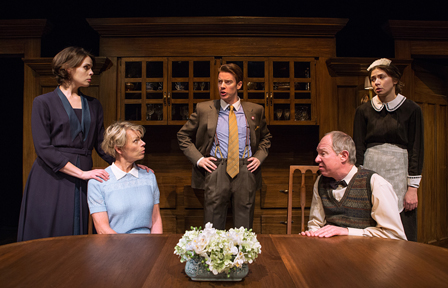
Sarah Wilson, Brenda Robins, Jeff Lillico, Diego Matamoros, and Courtney Ch’ng Lancaster — Five cast members (out of six) from “The Dining Room” (photo by Cylla von Tiedemann, courtesy of Soulpepper Theater).
central, essential heart of their home. A single set represents the dining room of eighteen different family homes. The setting and characters are meant to represent white Anglo-Saxon Protestant middle (and upper middle) class families in the New England states. But the ebb and flow of these lives, the characters’ manners, mores, family rituals, and familial conflicts are just as familiar on this side of the border.
The central conceit of the play is that a small cast of only six does repertory company work by portraying (between them) some 50 roles. And this Soulpepper cast of three women – Brenda Robins, Sarah Wilson, and Courtney Ch’ng Lancaster – and three men – Diego Matamoros, Derek Boyes, and Jeff Lillico – do bravura (not to mention yeoman) work in shifting adeptly from one role to another. An actor may represent a child, an elderly grandparent, and a household domestic in quick succession. The result is a series of vignettes – little glimpses into other lives, often revolving around a change of some kind in a family’s dynamic. There are coming of age vignettes, passing of an age vignettes, humorous moments, wistful moments, and reflective ones.
The result is eminently worth seeing – well-acted and consistently interesting – but the play lacks a through-line: Instead, these are little unconnected moments in time. That structure may dampen the emotional impact of the whole. Instead of a journey through the ebbs and flows of successive generations of a single family, or at least, successive occupants of the same house, the play opts to present eighteen different family scenarios – in eighteen different dining rooms (though the same set does multiple duty standing in for all of the dining rooms). But, then, perhaps that’s the idea: It’s the idea of a dining room – as the place where families gather – that is central and common to each of these disparate vignettes. The series of scenes, as eminently amusing as they are, lack a lasting emotional impact. They entertain and edify while we are watching them; but we aren’t left with a lasting emotional connection to the array of characters whom we’ve met. The focus here is, as others have said, on ‘powers of observation’ conjuring a ‘comedy of manners.’ And, indeed, it is impossible to watch these glimpses into the lives of middle class North Americans without experiencing many moments of fond recognition and nostalgia gleaned from our own lives in North America of the mid to late twentieth century.
John Arkelian is an award-winning journalist and author.
Copyright © 2015 by John Arkelian.
“The Dining Room” runs through July 31, 2015; and the musical “Singin’ in the Rain,” inspired by the famous MGM motion picture, runs from August 7 through August 29.
The Capitol Theater is located in the picturesque town of Port Hope, Ontario. For information about upcoming events, call 1-800-434-5092; or visit http://capitoltheatre.com/
******************************************************
The Musically Swinging Sixties – “Shout! The Mod Musical”
© Reviewed by John Arkelian
“Just listen to the rhythm of a gentle bossa nova / You’ll be dancing with ’em too before the night is over / Happy again / The lights are much brighter there / You can forget all your troubles, forget all your cares / So go downtown / Things will be great when you’re downtown / No finer place for sure, downtown / Everything’s waiting for you”
Those lyrics from Petula Clark’s signature song, “Downtown,”

Cara Hunter, Laura Laing, Alison J. Palmer, Amanda De Freitas, & Quinn Dooley in the Capitol Theater’s production of “Shout!” (photo by Carmen Amini).
capture the very essence of “Shout! The Mod Musical,” the high-energy musical show now on stage at Port Hope’s Capitol Theater. We are hurled through time to the Swinging Sixties, as five girls (who enter wearing in raincoats and Union Jack adorned umbrellas) guide us though a decade or more of musical hits from Mod London. Those were the days, indeed: Flamboyant fashions, sexy ‘birds,’ and song after song that hasn’t lost one whit of its power to energize and excite the listener! The production design is psychedelic – all bright primary colors, oversized stuffed plush vinyl ornamentation in the shape of stylized flowers and curlicues, with shag carpeting below. There’s a sporadic lightshow overhead (which conjures visions of a starship going into warp) and changing images
on a large projected background. Many of its images are taken from the cover of the pop-culture magazine that gives the show its name. Its pages contain the latest in celebrity gossip and music news, with advertisements for everything from cosmetics to The Pill, and a facile advice column that’s ready-made for spoofing. (Its cure for relationship problems? Get a manicure.)
The delightful cast of five – Amanda De Freitas, Laura Laing, Alison J. Palmer, Quinn Dooley, and Cara Hunter – acquit themselves very, very well. Their singing talents range all the way to first-rate. And their moves are as seductive as their voices. (When they descend into the audience at one juncture to make their moves on some lucky spectators, this reviewer’s seatmate asked if he were wishing that they’d come his way, or fearing that they might. His answer was, “A bit of both.”) Some of the cast were experienced pros; one was a relative newcomer, but all five grabbed the audience’s attention and took us for a wild whirl. To a man (or woman), we were simply delighted by the singing, Sixties’ style dancing, and bright-hued spectacle. Kudos to director Antonio Sarmiento, musical director Scott Pietrangelo, choreographer Stephen Findley, costumer designer Alex Amini, and stage manager Charlene Saroyan for this ever-so-entertaining production of the musical by Philip George and David Lowerstein.
There are jokey bits, brief monologues addressed to the advice lady (complete with her prerecorded replies) that are akin in tone to the Sixties show “Laugh In” or to the “Austin Powers” movies that spoof that decade; but they are just there to give the cast time to catch their collective breath, because, asides aside, this is an all-singing, all-dancing show. And what songs: There’s “London Swings like a Pendulum Swings,” “It’s Crazy, but I Only Wanna be with You,” “Wishing and Hoping,” It’s Easy,” “To Sir, With Love,” “Don’t Sleep in the Subway, Darling,” “You Don’t Have to Say You Love Me,” “Georgy Girl,” “Don’t Give Up,” “These Boots Were Made for Walking,” The Age of Aquarius,” “Let the Sun Shine In,” “You Make Me Want to Shout,” and the song that says it all, “Downtown,” to name some memorable examples.
One of the best numbers has the girls singing “Goldfinger,” using vocalization to utterly irresistible effect in key places that normally would be done by instrumentals (“Ta Da Da! Daddle daddle da…”). What a hoot! Elsewhere, there’s nice use of sound effects (an aerosol spray, squeaky window glass); a cute monologue on how to break up with different sorts of guys (from slightly superior Oxbridgers, to East End blokes, to sensitive types); mini-skirts galore; a knock-out rendition of “Son of a Preacher Man;” and a nice duet in counterpoint. References to drug use were less appealing, but they are few and brief. (Those comedic references and some mild sexual ones make this production best suited for ages 16 and up.) “Shout!” is not ‘a play’ in the conventional sense, and there is little or no plot. Rather, it’s a musical stage show – a showcase for its musical numbers. It had its audience on its feet, and it’s a guaranteed good time! It’s like the song says: “You’ll be dancing with them too before the night is over!”
John Arkelian is an award-winning journalist and author.
Copyright © 2015 by John Arkelian.
Editor’s Note: “Shout!” runs from June 26 through July 11; a touring Soulpepper production of “The Dining Room” runs from July 15 through July 31; and the musical “Singin’ in the Rain,” inspired by the famous MGM motion picture, runs from August 7 through August 29.
The Capitol Theater is located in the picturesque town of Port Hope, Ontario. For information about upcoming events, call 1-800-434-5092; or visit http://capitoltheatre.com/
*****************************************************
A Farce in the Meadow – “The Bad Luck Bank Robbers”
© Reviewed by John Arkelian
Decompression: It’s what divers have to do when ascending from
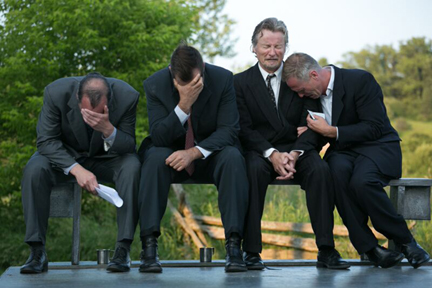
4th Line Theater’s Production of “The Bad Luck Bank Robbers” (photo by Wayne Eardley Brookside Studio).
the depths to the water’s surface, to compensate for the difference in air pressure. More broadly, it’s about adjusting to an unfamiliar environment. For this reviewer, the theatrical genre known as “farce” is an unfamiliar environment. It’s also something of a departure for 4th Line Theater, the theater in the meadow company situated in the farmlands of Ontario’s Cavan Township. 4th Line champions original plays gleaned from regional history, and its opening play of the summer, “The Bad Luck Bank Robbers,” written by Alex Poch-Goldin, is no exception, inspired, as it is, by the real-life armed robbery of a Havelock bank in August 1961. But this production is an unapologetic excursion into the comedic terrain of outright farce. And, in that respect, it is atypical fare for 4th Line.

4th Line Theater’s Production of “The Bad Luck Bank Robbers” (photo by Wayne Eardley Brookside Studio).
The sheer broadness of the comedy took some getting used to, but once that environmental adjustment clicked in, we were well and truly onboard for the rollicking ride.
Inspired (rather loosely, one is confident in assuming) by the aforementioned robbery of more than a quarter-million dollars from a small town bank, the play follows the misfortunes (and pratfalls) of an ill-fated quartet of robbers from Montreal, who make off with a fortune, only to run afoul of the rural area’s wetlands, stinging bugs, and inept lawmen, whose pursuit of their prey has all the hallmarks of the Keystone Kops. The robbers are far from home – and not shy about trumpeting the respective merits of their favorite hockey team over its struggling Ontario rivals (the Montreal vs. Toronto
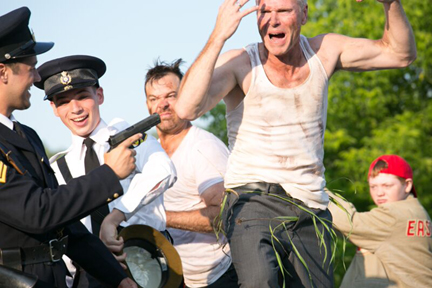
4th Line Theater’s Production of “The Bad Luck Bank Robbers” (photo by Wayne Eardley Brookside Studio).
hockey rivalry is a running joke). At first glance, these rough-and-tumble Quebecois seem like mere ne’er do wells, prone to loud roughhousing and general tomfoolery; but they soon get promoted in our esteem to the rank of loveable jackasses. Their chief spokesman (Jean Claude, played by Paul Braunstein) makes a particular impression. At the bank, Christie Stewart is the standout as Jean, a teller who turns on a dime from shrieking panic to outraged defiance. It’s a high-energy performance that only accelerates as she descends into something like a comedic variation on post-traumatic stress later in the play. But the source of her distress is never meant to be truly frightening. After all, the bungling crooks order everyone into the bank’s vault before remembering that they need to go in there themselves to collect the loot! One of Jean’s co-workers, Jim, is a manic, grinning, scenery-chewing goofball: His broad antics grate just a tad, which just goes to show that even farce can go overboard.
We also spend time with the assorted townsfolk, farmers, Ontario Provincial Police rank and file, reporters, and courtroom personnel who are caught up in the aftermath of the heist. Of them all, Monica Dottor is a hit in all three of her roles, but especially as the dimwitted but relentlessly perky café waitress (she’s as given to abrupt mood swings as Jean back in the bank) who sounds like she’s channeling a North Dakota accent straight out of the movie “Fargo.” She is a certifiable hoot! This production was less organically connected to its outdoor setting than most 4th Line productions, save for providing the backdrop for the miseries of the fleeing robbers who get lost in the inhospitable bush. But 4th Line’s customary ingenuity is on display with such innovative props as the two-dimensional side facade of a car held aloft by its players as they move at a slow jog (amusingly, one has to remind another to hurry up and stay with the moving prop). The trial of the malfeasors takes up the entire second half of the play, which is more weight (and time) than it needed to be given. And, some anti-Semitic references to the defense lawyer felt out of place in a comedy, however much they might have accurately represented the prevailing views of bigots, then and now. Like every 4th Line production, live music is woven into the very fabric of the story. The end result had the capacity audience laughing uproariously, winning over even a drama-snob, like your faithful reviewer.
John Arkelian is an award-winning journalist and author.
Copyright © 2015 by John Arkelian.
“The Bad Luck Bank Robbers” runs June 30 through August 1. 4th Line Theater’s second production of the summer, “Gimme That Prime Time Religion,” runs August 10 through 29, 2015. 4th Line Theater is situated on the Winslow Farm, 779 Zion Line, just outside the picturesque village of Millbrook, Ontario. For more information and tickets, call 1-800-814-0055, or visit http://4thlinetheatre.on.ca/
*****************************************************
“On a First Name Basis” –
A not to be missed production at Port Hope’s Capitol Theater
© Reviewed by John Arkelian
Port Hope’s jewel in the crown, the Cameco Capitol Arts Centre, under its talented Artistic Director, Antonio Sarmiento, got its summer theater season off to a smashing start with the utterly delightful play “On a First Name Basis.”
There are only two characters on a single set, but they exude great strength of character, holding us completely charmed and amused
throughout, with witty repartee that proves that comedy can still be smart and sparkling – in a time that too often instead favors the lowest common denominator as a way to generate laughter. The playwright himself, Norm Foster, portrays his leading man, David Kilbride, a successful academic turned novelist, who has a wry, somewhat superior outlook on the world around him. At perhaps 60-something, he enjoys commenting on the foibles of human nature and he’s ceaselessly sure of himself. But he meets his match in his housekeeper of 28 years, Lucy Hopperstaad, played to perfection by Patricia Vanstone. She is punctilious and correct, but she’s not one to suffer impudence lightly. She has the manner of an iron-willed English housekeeper (though she is not British), rather than their dumbed-down colonial cousins. David seems to have barely noticed his domestic amanuensis: He has even delegated to her the task of completing her own annual performance appraisal – and Lucy has had no qualms in writing glowing reviews of her own work. After 28 years, David professes not to know his helpmeet’s first name – and on the evening on which this story is set, he vows to rectify that omission. He wants them to talk, as if they were “chums,” in order that he can learn more about the woman who has been in close proximity but all but invisible to him for so long: “The interest you’ve taken in me is not little,” says Lucy, “it’s imperceptible.”
It all takes place on a single, very nicely designed set – a sitting room that has air-force blue walls set off by white wainscoting and shelves and burgundy chairs. David may have the superior airs of a bright, successful “egg-head,” as he dubs himself, but he encounters a feistily able foil in Lucy. She may lack formal credentials, but she most decidedly does not want for an inquiring (and well-read) mind. And, my, oh my, is she candid: “I’m nothing if not forthright, sir,” a self-assessment that is a major understatement. Indeed, each of the play’s two characters have hints of the antihero of Moliere’s great play, “The Misanthrope” (who proclaims about his fellow man that, “I’d have them be sincere and never part with any word that isn’t from the heart”). Not that Davis or Lucy have anything of the misanthropic about them. Skeptics? Yes. Outspoken? Undoubtedly. Not shy about relentlessly probing for the truth of a situation or a proposition? Definitely. One might almost describe them as acerbic, as there is a sharpness to their verbal barbs – but it is never harsh or intent on causing pain. Perhaps the best analogy is a pair of well-matched sparing partners, with verbal épées always at the ready: When David tells Lucy that she’s “uneducated and common, “ he doesn’t mean it; but she has a fitting retort, skewering his self-satisfied disdain with a verdict that he’s a “self-involved, oblivious jackass.”
“On a First Name Basis” is beautifully written and flawlessly performed: Its verbal interplay is the stuff of dryly ironic repartee: The quips come fast and furious, generating frequent laughter among the audience: “Do you drink Scotch?” asks David. “Like mother’s milk,” replies the prim and proper Lucy. As to her dating life, she says, “I’m selective.” David practically harrumphs in response with, “Two men in 28 years. Mensa isn’t that selective.” There’s a subtle love story buried in this verbal fencing match, and it conjures happy memories of such pairings as Clark Gable and Claudette Colbert in 1934’s “It Happened One Night,” William Powell and Myrna Loy in their “Thin Man” movies, and Katherine Hepburn and Spencer Tracy in any or all of their cinematic pairings. That’s pretty illustrious company – and that’s exactly where this winning production belongs. David and Lucy may not be soft and cuddly in the conventional sense, but we instantly feel that we know – and like – them. The two hours literally fly by. The writing, the performances, the staging, and the set would not be amiss on the leading stages of Toronto or New York. And this production would feel equally well at home at Niagara-on-the-Lake’s Shaw Festival. Yet, here it is: Eminently affordable and situated right on the doorstep of theater-goers in the eastern Greater Toronto Area. This is a not to be missed production. So, don’t miss it! It’s running through Saturday, June 20. Go see it – and, like us, you’ll be wanting to return for a second helping.
John Arkelian is an award-winning journalist and author.
Copyright © 2015 by John Arkelian.
Editor’s Note: “On a First Name Basis” runs through June 20th. The musical “Shout!” runs from June 26 through July 11; a touring Soulpepper production of “The Dining Room” runs from July 15 through July 31; and the musical “Singin’ in the Rain,” inspired by the famous MGM motion picture, runs from August 7 through August 29.
The Capitol Theater is located in the picturesque town of Port Hope, Ontario. For information about upcoming events, call 1-800-434-5092; or visit http://capitoltheatre.com/
**************************************************
Practically Perfect:
“Mary Poppins” on Stage at the Capitol Theater
© By John Arkelian
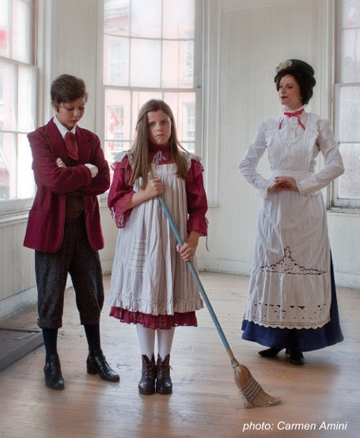
Talen Waller (as Michael), Keira Phillps (as Jane), and Heather McGuigan (as Mary Poppins) in “Mary Poppins” — courtesy of the Capitol Theater (photo by Carmen Amini)
Mary Poppins, the eponymous heroine of the stage musical based on the beloved movie and the stories by P.L. Travers declares that she is “practically perfect” in every way. Well, so, too, is the Capitol Theater’s production of the stage musical “Mary Poppins.” It is a Toronto-caliber show put on in the more intimate surroundings of Port Hope, Ontario’s charming atmospheric theater. The Banks household is in need of a nanny – and a few life lessons about happiness – and who better to provide them than the benevolent force of nature who appears, as if by magic, at their door? To the household’s patriarch, whose bywords are “precision and order,” the irrepressible newcomer brings “chaos in her wake.” And perhaps she does, for Mary Poppins embodies a benevolentchaos and a merry disorder; she is the living, breathing embodiment of the words: “Anything can happen, if you’ll let it.” Anything and everything does happen – starting with a quintet of marble statues that come to life in a park, dancing to the strains of “Jolly Holiday.” Settings are evoked through very effective use of back-screen projections (an otherwise still image of St. Paul’s Cathedral has white clouds moving above its dome),
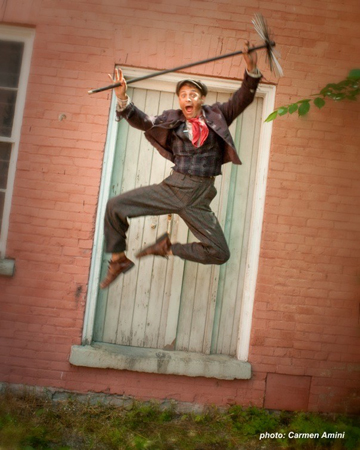
Chris Zonneville (as Bert) in “Mary Poppins” — courtesy of the Capitol Theater (photo by Carmen Amini)
and they often segue artfully into three-dimensional sets inside the Banks home. There’s a jolly encounter with carnival folk, who are brightly attired in multi-colored garb reminiscent of Cirque du Soleil’s eccentric characters, a scene which yields the show-stopping song and choreographyof “Supercalifragilisticexpialidocious.” For its part, “Feed the Birds” provides the show’s most poignant song.
When our narrator Bart takes to the rooftops as a chimney-sweep for “Chim Chim Cher-ee,” the production combines an exterior scene with an interior view of the children sleeping inside – a juxtaposition that tends to break the spell somewhat in the limited staging space available. A later scene, which devotes the full stage to the rooftops works better, and it yields the show’s most lively and infectious song-and-dance number, “Step in Time,” an irresistible mix of well-choreographed tap dancing and sheer manic energy that sweeps everyone and everything before it. There’s also a near-operatic singing duel between Mary Poppins and her temperamental opposite, the dour disciplinarian Miss Andrew, a character who makes a
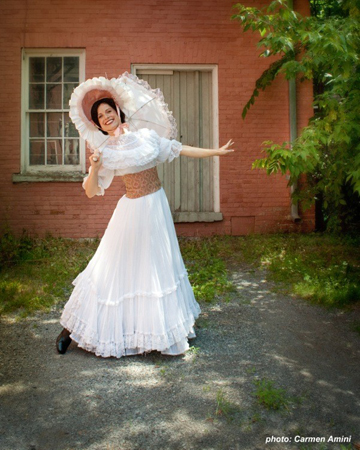
Heather McGuigan in the title role of “Mary Poppins” — courtesy of the Capitol Theater (photo by Carmen Amini)
remarkably strong foil to our heroine. If you think “Mary Poppins” is kids-stuff, “In that, as in so many things, your information is faulty,” as our heroine is fond of saying to the obstinate or misinformed. It’s a show for all ages, and it’s got a big canvas bag full of humor, poignancy, and the healing of wounded spirits.
Many of its performances have sold out, and it’s easy to see why. Director Antonio Sarmiento has fashioned an entertainment that will leave audiences with a spring in their step and a song in their heart. The talented cast includes Heather McGuigan (as Mary Poppins), Chris Zonneville (as Bert), Ian Simpson (as Mr. Banks), Kristin Galer (as Mrs. Banks, whose character has more substance here than we recall in the movie version), Jayne Lewis (who makes a memorably imperious ‘Holy Terror’ of a harshly strict nanny), Talen Waller (who, imperceptibly, is a girl playing the role of the boy Michael), and Keira Phillips (as young Jane). And all of the supporting players likewise ably contribute this production’s success. That goes for costume designer Alex Amini (and her assistant Carmen Amini), choreographer Kiri-Lyn Muir, music director Stephen Woodjetts, and the rest of the crew, too. We wait with keen anticipation to see what comes next at the Capitol Theater.
Copyright © August 2014 by John Arkelian.
Editor’s Note: The Capitol Theater is located in the picturesque town of Port Hope, Ontario. For information about upcoming events, call 1-800-434-5092; or visit http://capitoltheatre.com/
*******************************************************
“Wounded Soldiers”
© Reviewed by John Arkelian
It opens with a procession of soldiers and nurses, bent over as they intone
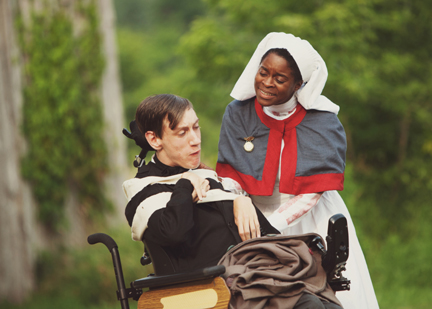
Sean Towgood (as Johnny) & Jajune Mandiela (as Lydia) in “Wounded Soldiers” — courtesy of 4th Line Theater (photo by Rebekah Littlejohn)
an onerous dirge: “Mud, mud, murderous mud.” It’s a tableau that conjures words from Wilfrid Owen’s poem, “Dulce et Decorum Est:” “Bent double, like old beggars under sacks / Knock-kneed, coughing like hags, we cursed through sludge…” 4th Line Theater’s new play, “Wounded Soldiers” is set amidst physical and psychological charnel-house of the First World War. Since we recently marked the 100th anniversary of the outbreak of that so-called ‘Great War,’ a story gleaned from its grievous maelstrom of death and shattered lives could not be more timely. The play is a kind of sequel to 4th Line’s 2005 hit (which was remounted in July of this year) “Doctor Barnardo’s Children,” insofar as it visualizes a reunion of two alumni of the British home for homeless children. Both of them are young men; both are in dire straights: One, Billy Fiddler, is a patient at a war
hospital, the victim of traumatic stress encountered on the battlefields of France. The other, Johnny Singer, is consigned to an adjoining “Idiot Asylum” (an accurate bit of ungenerous nomenclature from the time) on account of a purely physical disability, namely cerebral palsy.
Billy appears (as a child and as an old man) in the earlier play; but he’s unrecognizable at this point in his life: He first appears in a straight-jacket and with a reputation for being “sullen and unresponsive, with violent outbursts.” The military doctor’s ‘treatment’ for “mute-ism” is electrical shocks inflicted in the patient’s open mount – a dire remedy that piles more abuse on the awful psychological trauma Billy has already endured at the front. As his memories gradually return, he is tormented by visions from the battlefield. Those flashbacks are staged very effectively. In one, a

Griffin Clark (as Billy) & Jajune Mandiela (as Lydia) in “Wounded Soldiers — courtesy of 4th Line Theater (photo by Rebekah Littlejohn)
scene with troops in a trench segues into a song and dance number with the theme, “I’m a rat. I’m society’s outcast.” Three human-sized rats in gas mask hoods join that number, as does a Rat Leader on a balcony, who sports a lifelike rat mask and channels the ominous basso profundo rumblings of Darth Vader himself. A later flashback, to the song “I Remember,” has several actors with their helmeted heads down, high-stepping in slow motion as they carry a large turret: They are the living pantomime of a tank in motion – as it obliviously rolls over its own wounded compatriots. It’s a wonderfully imaginative and strikingly effective scene. Every 4th Line production makes pronounced use of original music and song; but none more so than “Wounded Soldiers,” which comes closest to being a full-fledged musical, even though most of it

Sean Towgood (as Johnny), Griffin Clark (as Billy), and other cast in “Wounded Soldiers — courtesy of 4th Line Theater (photo by Rebekah Littlejohn)
consists of spoken (rather than sung) dialogue. The songs in this production are particularly strong. And the outdoor setting is used to strong effect: As always, the grassy lawn next to the barns, with adjacent balconies, serves as the primary stage. But the nearby pasture has been dressed to resemble a battlefield, complete with some 30-odd tree trunks (stripped of lateral branches and foliage), along with impact craters, sandbags, and a trench. It’s stark and realistic – and so, too, is the play itself, which takes a darker tone than the season’s first play, the aforementioned “Doctor Barnardo’s Children.”
Once he recovers his voice, Billy is insistent that he wants to return to the front. Not even the protestations of his childhood chum Johnny can dissuade him. Confined to a wheelchair, Johnny’s mind and spirit are
unconfined. He wants to be a writer, and he is inspired by the anti-war writings of Bertrand Russell. He’s secretly enamored with his fetching nurse, Lydia, and he has her recite the poems he writes. His words show insight and have the power to move those who hear them (he writes about the front he’s never seen: “as the metal rain falls on our heads”); but only Lydia (and his friend Billy) see him as a man – actual and whole. (He slyly tells Billy that “It’s all in working order,” as far as his physical attraction to Lydia is concerned.) As for Lydia, she’s a firecracker of a young woman, who’s come from Jamaica to tend to wounded soldiers; she speaks her mind and breaks the rules in the best interests of her patients. Billy is as smitten with her as Johnny – and who can blame them? Lydia’s plain-spoken good sense and genuine compassion light up the bleak surroundings. The trio
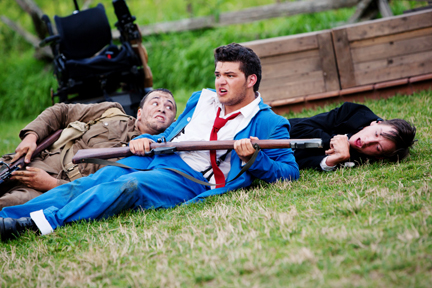
Other cast with Griffin Clark (as Billy) & Sean Towgood (as Johnny) in “Wounded Soldiers — courtesy of 4th Line Theater (photo by Rebekah Littlejohn)
sneaks off to a pub, where one of the patrons, who has clearly had a few drinks already, is a hoot with her comical facial expressions. (Kudos to the actress concerned!) There, they also encounter racial prejudice and general small-mindedness, to a song with a hip-hop rhythm called “Piss Poor Protoplasm.” An earlier scene uses outright satire, as ten troopers sporting big red clown noses make a scathing musical comment on the career elevation of senior officers who lost thousands of soldiers yet profited handsomely in promotions.
There’s a subtle allusion to the earlier play (no knowledge of which is needed to fully appreciate this one), when Billy proclaims, “I’m the king of nothing, and I like that title” – words which ironically echo his childhood boast in the other play, that, “I’m the king of the mountain, and you’re…

A big basso profundo rat in “Wounded Soldiers — courtesy of 4th Line Theater (photo by Rebekah Littlejohn)
the dirty rascals.” Of dirty rascals (and outright villains) there is no shortage in these plays (just as in life); but there are also three admirable characters as the leads. Griffin Clark takes Billy on his arc from a grievously damaged to sporadically recovered man who has lost all illusions and hope amidst the carnage and futility of the battlefield. Sean Towgood, who is handicapped in real life, is very affecting (and effective) as the man who is imprisoned within his own body, the man who “needs to find a way out… to live my own life.” And Jajube Mandiela is the irrepressible heart of the play, as Nurse Lydia, a woman whose calling is to heal people. “Wounded Soldiers” was written by Ian McLachlan and 4th Line’s artistic director Robert Winslow. Justin Hiscox composed the original songs and score, and Andrew Scriver designed the set. What better way to recall the devastation that was World War One than to see this memorable play? Will we, as Wilfrid Owen put it, continue to tell “To children ardent for some desperate glory / The old Lie: Dulce et Decorum est / Pro patria mori.*” Or, will we join Johnny in “longing for a future free from pain… Let us go there together – before it’s too late.” The choice is ours.
John Arkelian is an award-winning author and journalist.
Copyright © August 2014 by John Arkelian.
4th Line Theater’s second production of the summer, “Wounded Soldiers,” is the world premiere sequel to “Doctor Barnardo’s Children.” It runs through August 30, 2014. 4th Line Theater is situated on the Winslow Farm, 779 Zion Line, just outside the picturesque village of Millbrook, Ontario. For more information and tickers, call 1-800-814-0055, or visit http://4thlinetheatre.on.ca/
Have a Farm Picnic! For an extra treat, play-goers can preorder a tasty farm picnic lunch from Baxter Creek Golf Club, or from The Pastry Peddler in Millbrook. This reviewer has tried – and can happily recommend – both!
*Editor’s note: The English poet, Wilfred Owen (1893-1918), is regarded as one of the leading poets of the First World War. His poem “Dulce et Decorum Est;” was written in 1917-18. Its ironic final words (cited in Latin, above) translate as “It is sweet and fitting to die for your country.”
**********************************************************
“Maud of Leaskdale” – A Play, a Hidden Gem, and the Kindling of a Kindred Spirit
© By John Arkelian
In her beloved novel “Anne of Green Gables,” Canadian author Lucy Maud Montgomery (1874-1942) has her irrepressible young heroine say,
“Kindred spirits are not so scarce as I used to think. It’s splendid to find out there are so many of them in the world.” Well, there’s a hidden gem of a play in a small village northeast of Toronto (in Durham Region) that introduced a new kindred spirit to this reviewer – in the form of the author herself. Gleaned from her extensive published journals, the one-woman play, “Maud of Leaskdale” is a marvel of eloquent words eloquently delivered by actress Jennifer Carroll. It is no less than bravura acting work: The solo performer shares a non-stop inner monologue that spans 15 years in the life of its protagonist and a lovely two hours in the lives of its audience. Maud, as she was known, came to the village (or is it a mere hamlet?) of Leaskdale in 1911, as her husband, Ewan Macdonald took up the post of minister at St. Paul’s Presbyterian Church in the small rural community. There they stayed until 1926, during which span Maude gave birth to three sons (the second of whom was stillborn), wrote half of her 22 novels, and endured both the death of her closest friend and her husband’s struggle with severe depression.
Like all of us, Maud knew joy and sorrow; but, unlike most of us, she was gifted with the astute observation, dry wit, and adept use of language to record her experiences – and to breathe life into her printed words. There is a formality of expression (in part, no doubt, a sign of the times in which she lived) to Maud’s words that is at once elegant, keenly observant,
confiding, and gracious. Her words, given oh-so-convincing voice by Jennifer Carroll, are also gratifyingly accessible: We instantly like this woman and get drawn into her observations of her new life. She confides, in what’s almost a stage whisper, that, “I have another opinion; but I do not tell it to all in sundry,” even as she proceeds to confide it to us. The play pulls us in to the inner thoughts and heartfelt feelings of this thoughtful woman, making us the trusted her trusted confidants. And in the intimate setting – an unostentatious, down-to-earth, yet thoroughly charming, country church (with gracefully curved wooden pews and the words “The Lord is in His Holy Temple” painted in scrolling letters on the front wall) – we are up-close-and-personal with this woman and her life: She addresses us directly, with disarming directness, and on occasion plays a tune on a piano. Indeed, the venue, the Historic Leaskdale Church, is the very same church where Maud’s husband served as minister. It’s as though she has been there all along, just waiting to be channeled by the actress who speaks her words.
Maud’s words are full of astute observations about the stuff of ordinary life. At times, she feels the loneliness of an outsider: As an author and
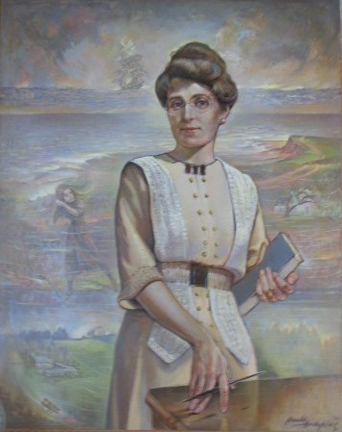
“A Moment with Lucy Maud Montgomery” © Oil painting by Arnold Hodgkins — courtesy of the Lucy Maud Montgomery Society.
intellectual, she cannot easily find others with similar outlooks and preoccupations in this rural community: “I feel as though I was stranded on a coast where no one speaks my language.” When she becomes pregnant, the prospect of giving birth for the first time amazes her. And when her first-born arrives, she marvels at “this tiny blinking mite of humanity… Love, such love, I never dreamed there could be such love.”
The play was written and directed by Conrad Boyce, from The Selected Journals of L.M Montgomery, 1911-1926, edited by Mary Rubio and Elizabeth Waterston (Oxford University Press). It was first presented in 2011 for the 100th anniversary of Maud’s arrival in Leaskdale; and it has become an annual attraction ever since. Its sole thespian originated the role; and, now that she has returned permanently to her native Canada from a sojourn abroad, we look forward to seeing the talented Jennifer Carroll in other productions as well. In this play, she combines confidence, delicacy, and perfect timing, changing the mood and tone as she follows the high-points and vicissitudes of Maud’s life: “What has my life been but a succession of leaving things I loved?” When she writes her last Anne book, Maud makes a ‘dark and solemn vow,’ of the self-same sort her fictional heroine is so fond of, to henceforth devote her attentions to other stories and new characters. There’s wry humor here: She’s not at all keen on the neighboring village of Zephyr (maybe she had it in mind when she said a small village could be “the pettiest place in the world”); and, as to the then popular board game known as crokinole, Maud insists that, “I loathe [it] with a deadly hatred.” There is also a clear-sighted view of life’s absurdities, blessings, and losses. And there’s wisdom, too. To paraphrase Maud, ‘One cannot have imagination and the gift of wings, as well as placidity and contentment. And imagination is better.’ Those of us who are devoted to the imagination will have no trouble at all imagining that Maud herself is confiding directly in us, in her own intimate and inimitable fashion.
The play is a not to be missed experience. And for a perfect after-play event, take a half-block stroll across the road to the Leaskdale Manse, where Maud and her family lived for 15 years. The house has been lovingly restored by the Lucy Maud Montgomery Society. Their work in replicating its furnishing (right down to the books Maud read) was facilitated by her meticulous chronicling – in her journals and photographs – of every aspect of her day-to-day life. And for a house of its vintage, this cozy abode is remarkably full of natural light – as bright and welcoming as the lady of the house herself. And what bibliophile could resist embracing as kindred one who confides, “I am simply a ‘book drunkard.’ Books have the same irresistible temptation for me that liquor has for its devotee. I cannot withstand them.” In her novel “Anne of the Island,” Maud said that, “It seems to me a most dreadful thing to go out of the world and not leave one person behind you who is sorry you are gone…” The fascinating play that recreates her life is warranty enough that she will never go unmissed!
John Arkelian is an award-winning author and journalist.
Copyright © July 2014 by John Arkelian.
Editor’s note: “Maud of Leaskdale” continues its run through August 28, 2014 at Historic Leaskdale Church, 11850 Regional Road 1, Leaskdale, Ontario (due north of the town of Uxbridge). Performances are on Thursdays at 7:30 pm and on Saturdays and Sundays at 3 pm. Tickets are $25 for adults; $20 for seniors and students. For more information, or to purchase tickets, call (905) 862-0808 or visit http://lucymaudmontgomery.ca/
***********************************************
“Doctor Barnardo’s Children”
© Reviewed by John Arkelian
“I tried to save them all. Why did I do that? I love the children…. I have many regrets but no shame.” So says the crusading children’s welfare
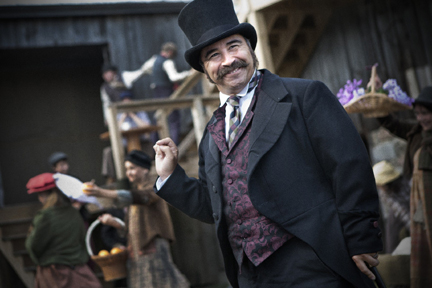
Herbie Barnes as Thomas Barnardo in “Doctor Barnardo’s Children” — courtesy of 4th Line Theater (photo by Wayne Eardley, Brookside Studio)
advocate Thomas John Barnardo. In 1866, Barnardo founded an eponymous charity which, today, is the biggest children’s charity in the United Kingdom. The man’s missionary zeal to save children from poverty and neglect – and the impact his work had, for good or ill, on the lives of the children it took into foster care – is the subject of both of this year’s plays at 4th Line Theater. As ever, the venue is a barnyard and adjacent pasture of artistic director Robert Winslow’s family farm. And, all of the rest of 4th Line’s staples are in place: (a) using the grist of local and regional history to tell highly original stories, (b) incorporating the outdoor, rural setting into the very bones of the production, (c) making liberal use of original music and song in every production, and (d) showing a refreshing flair for innovative storytelling.
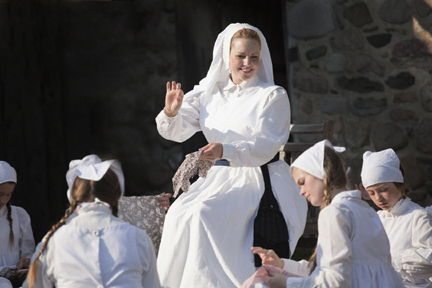
Heather Barnes & Barnardo Girls in “Doctor Barnardo’s Children” — courtesy of 4th Line Theater (photo by Wayne Eardley, Brookside Studio)
4th Line’s July 2014 offering is a remount of its popular 2005 hit, “Doctor Barnardo’s Children,” written by Ian McLachlan and Robert Winslow. It opens sometime in the 19th century with two dozen or more street urchins, who are right out of Dickens, selling oranges, matches, and their virtue. The Artful Dodger could easily be one of them. Barnardo, an Irish-born physician who intends to go to China as a missionary doctor, is appalled by what he sees closer to home in London: “These children had no one; they were utterly alone and destitute.” He founds a home to take in as many as he can, proclaiming that he will never turn away a child in need. As depicted in the play, discipline in these orphanages was severe. “Things wasn’t so gentle in those days,” as one character remarks.” Barnardo didn’t always hew closely to the letter of the law, taking it upon himself to

Gary Bryant & Jenna LeFrancois in “Doctor Barnardo’s Children” — courtesy of 4th Line Theater (photo by Wayne Eardley, Brookside Studio)
‘liberate’ children who had parents he regarded as unfit or incapable. He was charged with kidnapping on multiple occasions; but he defended his actions by characterizing them as “philanthropic abductions,” carried out without a family’s consent, yes, but with the children’s best interests at heart. Appropriating onto himself the right to overrule those mostly chiefly concerned, namely, the parents and children themselves, suggests an outsized ego. In the play, he proclaims that, “I had the moral right. Their neglect has proven them unworthy of the title ‘parents.’” And, in the play, Barnardo is full of bombast: He never speaks when he can shout and bluster. He comes across as a P.T. Barnum, with his very own Ringling Brothers charitable circus. The trouble is, whether by accident or design, the script and performance (by Herbie Barnes) yield a character who is all

Barnardo Girls in “Doctor Barnardo’s Children” — courtesy of 4th Line Theater (photo by Wayne Eardley, Brookside Studio)
of one blowhard note. The character only shows real nuance late in the play, when he senses that a girl placed in foster care with a preacher in Ontario is being sexually abused by her guardian. Barnard’s first response does him credit: He is outraged. But righteous indignation quickly turns to moral failure when expediency prompts him to turn a blind eye. The actor conveys the irrevocable toll that bad choice takes on Barnardo’s soul, as he turns his face from one of the children he swore to protect.
In time, Barnardo found common cause with other child welfare advocates in Britain, like the Scottish Quaker Annie MacPherson, by joining the Home Children movement. From 1869 on, that movement (of which Barnardo’s charity was just a subset) sent more than 100,000 children to the British colonies of Canada, Australia, New Zealand, and South Africa. But, the
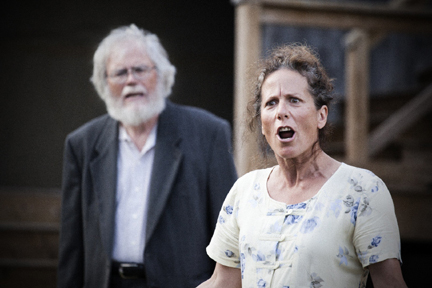
Gary Bryant & Marjie Chud in “Doctor Barnardo’s Children” — courtesy of 4th Line Theater (photo by Wayne Eardley, Brookside Studio)
practice had much longer antecedents, with orphans being sent to settler colonies as far back as the early 17th century. Barnardo joined the emigration movement in 1872, embracing it wholeheartedly in 1881. His charity’s home in Peterborough (not far from the 4th Line farm) was called Hazelbrae, and it hosted some 9,000 children over 39 years. Overall, Barnardo’s charity alone may have sent something like 20,000 children to Canada. Those numbers, part of the even larger Home Children immigration, prompted the government of Canada to proclaim 2010 the ‘Year of the British Home Child,’ while Ontario enacted legislation in 2011 to make September 28th its annual ‘British Home Child Day.’
Some Home Children were treated decently; others were taken into what amounted to indentured servitude (one of the play’s boys says, “I’m just a captive slave”) – as unpaid (and sometimes abused) labor on farms or in the homes of the families that took them in. In 1891, a leading Canadian newspaper reported that, “The attention of the Dominion Government has been drawn to the fact that the children sent to Canada from England are street waifs and workhouse paupers, and that the professional philanthropists engaged in the work are largely prompted by mercenary and not charitable motives. A demand will be made that parliament should investigate the matter before voting any money to promote this kind of immigration.” The play depicts both extremes of treatment – with a few children which it follows from Britain to the countryside of central Ontario. The play especially follows the stories of George White (née Murphy), his beloved sister Lily, and his best friend, the all around scamp and mischief-maker Billy Fiddler. The play divides its attention between Walter and Billy’s childhood and their old age. Their younger selves suffer the vicissitudes of poverty and wrenching separation from family. The six Murphy kids are forcibly separated from their father, who delivers his children to the Barnardo institution on the understanding that he’ll return for them; when he does, the orphanage refuses to return the children – in an act of institutional hubris, that, arguably, amounts to child abuse. If the aged Walter hews a tad too closely to the unvarying note of a grouchy old man; his younger self, along with the young Billy, and Lily, played, respectively, by Justin Laurie, Liam Davidson, and Frances Loiselle, are the play’s most affecting characters – along with Matt Gilbert, who plays their unfortunate father (as well as another, not at all sympathetic character).
Late in the play, there’s a century-spanning confrontation between a modern woman and Barnardo. The didactic nature of her message – that the children were not, in point of fact, protected – may undermine the drama of the moment somewhat; but it’s a face-to-face challenge that we are all itching to see happen. In the play’s most touching scene, Lily has a monologue giving voice to her tragic fate. It’s a truly poignant scene, before the play ends on a note of Billy’s irrepressible childhood hijinks: “I’m the king of the castle, and you lot, you’re just the dirty rascals.” Humorous words, yes, but they pretty accurately sum up the gap between children in need of protection and care, and the adults who, through well-intentioned fumbling, neglect, or something worse, dropped the ball.
John Arkelian is an award-winning author and journalist.
Copyright © July 2014 by John Arkelian
Editor’s note: 4th Line Theater’s second production of the summer, “Wounded Soldiers,” is the world premiere sequel to “Doctor Barnardo’s Children.” It follows the story of a Barnardo boy who returns to Europe as a young man to fight in the First World War. “Wounded Soldiers” runs from August 5 through August 30, 2014. 4th Line Theater is situated on the Winslow Farm, 779 Zion Line, just outside the picturesque village of Millbrook, Ontario. For more information and tickets, call 1-800-814-0055, or visit http://4thlinetheatre.on.ca/
***********************************************
“Broadway: Andrew Lloyd Webber” at Port Hope’s Capitol Theater
© Reviewed by John Arkelian
Kudos to the new artistic director of Port Hope’s Capitol Theater for making a convert out of this generally reluctant purveyor of the musical
stage. Antonio Sarmiento’s musical anthology show, “Broadway: Andrew Lloyd Webber” (which closed on July 12th) gathered together many of the most memorable songs from seven of the British composer’s musicals, and turned them into a rousingly good time at the theater. The ensemble cast hit all the right notes as the songs ran the gamut of moods: Some (Like “Memories” and “Another Suitcase”) were poignant; others (like “Rolling In” and the finale to “Joseph and the Amazing Technicolor Dreamcoat”) were high-octane numbers that propelled cast and audience alike with infectious energy. The production made effective use of projected backdrops, in the form of still and moving images: Some illustrated the life and career of the composer, while others reflected the setting or mood of the songs on stage. There were operatic gowns for some of the solos; but the production also made surprisingly good use of simple, colorful cotton attire. The most elaborate set design was reserved for a punt (or canal boat) in catacombs beneath the Paris Opera; and, “The Phantom…” provided four of its thrilling songs to this production, among which were two standouts: “Think of Me” and “Angel of Music.” The talented ensemble cast of eight men and women – Erin Breen, Tim Funnell, Laura Laing, Genevieve Leclerc, Dale Miller, Trevor Patt, Stephanie Roth, and Ian Simpson – really delivered the musical goods. Other highlights (in a show that had many) were “Unexpected Song,” “With One Look” (in which the soloist was clad in a scarlet gown bearing a sparkling phoenix-like design), “Heaven on Their Minds,” and “Gethsemane.” The actor portraying Judas (who happened to look a lot like “True Blood’s Vampire Bill) was particularly strong in his pieces from “Jesus Christ Superstar.” And “Sunset Boulevard’s” diva ballad, “As If We Never Said Goodbye,” knocked the audience’s collective socks off. Sarmiento had big shoes to fill in taking over where the Capitol’s estimable Uwe Meyer left off, but this production leaves no doubt that he, too, has the right stuff to produce first-rate live theater in the Capitol Theater’s charming setting.
Copyright © July 2014 by John Arkelian.
Editor’s note: Located in the picturesque town of Port Hope, Ontario, the Capitol Theater’s final summer production, the Broadway version of “Mary Poppins,” runs through August 24, 2014. For information and tickets, call 1-800-434-5092; or visit http://capitoltheatre.com/
*********************************************************
“The Book of Judith” –
Art, Disability, & Missionary Zeal
© Reviewed by John Arkelian
“This is not the world that I would have designed.”
The setting is a big white tent. We are there for a play, a play that unfolds like a missionary revival meeting. It’s in the style of a secular religiosity – complete with white pulpit, an animated preacher delivering a first-person testimonial account of his particular road to secular salvation, a choir clad in white gowns, a “missal” (or prayer book) with hymns and words of wisdom, and even a venerated secular saint – in the person of real-life disabilities advocate Judith Snow. The chief animateur, master of ceremonies, and evangelist in the Church of Judith is the show’s co-creator Michael Rubenfeld. With considerable on-stage charisma (and a speaking manner very reminiscent of Canadian actor Jay Baruchel), Rubenfeld is a bundle of energy, sincerity, and earnest conviction: ‘I didn’t know my life needed changing, but it did.’ His ‘Road to Damascus’ moment came when he met the quadriplegic activist and artist Snow, who refused to let self-pity (or a grim medical prognosis) stand in the way of her zeal to live life to the fullest: “She said no to death,” we are told. Her simple desire to find a lover prompted Rubenfeld to reexamine his hitherto complacent world-view. The result was a 2006 play called “Suck and Blow” (the title referencing the air tube with which Snow interacts with the world around her); and, now this evening’s production, which was co-created by Rubenfeld, director Sarah Garton Stanley, and Snow herself. The result is delivered in a very natural, conversational style: It feels ad-libbed, though presumably it’s mostly scripted. Choir leader Alex Bulmer (who herself appears to be blind) leads a locally-recruited choir comprised largely of men and women with disabilities, some of them pronounced enough to prompt what appear to be unscripted outbursts – unscripted developments to which Rubenfeld adroitly fields improvised responses.
The songs have very simple lyrics, and that sing-song quality that is characteristic of so much Pentecostal-style worship. But what’s happening here feels too much like ‘worship.’ It is part and parcel of the self-referential theme, one supposes, that the show’s creators have turned their subject into a saint. But the reverential tone adopted toward Snow rankles a bit. The gushing admiration expressed for Snow would have carried more heft if it had been earned by the play simply demonstrating her qualities, instead of heavy-handedly praising them to the heavens. Why not tone down the outpouring of praise and hallelujahs and instead tell us the woman’s story? Her fortitude and insights would make an even greater impact without the overlay of reverential admiration. However, there was a lot of knowing laughter in the audience. Is it largely an ‘in-crowd,’ comprised of people who get the ‘in-joke?’ Is the intent to be coy, or perhaps a little satirical? The answer was never clear, and that vagueness of purpose is to the detriment of the show. But, one must give the production its due as being strikingly original. It holds the viewer’s interest from beginning to end, and it is performed, mainly by Rubenfeld, with great verve, energy, and conviction. (The poor fellow needed a helper to take the microphone to the various readers of the lessons; all the running about on stage left him a tad winded at one juncture.) There were also moments of surprising intimacy. One came when our storyteller knelt on the floor and looked some audience members directly in their eyes and told them he loved them – it was a poignant demonstration of the world-changing potential of love in action. That such a simple statement could produce feelings of embarrassment and discomfort says a great deal about how skewed man’s values and priorities can often be. The show has its own secular versions of such ecclesiastical practices as ‘exchanging the peace’ with those sitting nearby and taking a Eucharist. And speaking of intimacy, we were exhorted to put our piece of unleavened bread directly into the mouth of a stranger: Funny how such a simple thing could seem so excruciatingly intimate.
On the other hand, Rubenfeld’s act of briefly stripping down to his briefs, however bold, probably should have been cut. It felt gratuitous and a tad embarrassing for the audience. But the play makes instructive points at regular intervals, noting, in earthy language that for most of us, the idea of making love to someone who cannot move, is, well, “freaky shit.” There’s Snow’s adamant wish that people would see “not the oddity, not the inspiration, but the woman.” And there’s a lot of insight in her description of what it is like to be on the outside looking in – the ensuing feelings of loneliness, isolation, and alienation transcend the physically handicapped and speak to the broader human condition: “Who I am is an intruder…. I do not belong in this world…. The world does not want me.”
The whole show, very deliberately, is completely Judith-centric, right down to the circular banner that has her face and sunbeams emanating from it. Maybe she’s just meant to a symbol or a metaphor. Otherwise, all the paeans of praise for her (she is a mere mortal, like the rest of us, after all) would be off-putting. But if the purpose is indeed symbolic, then the production feels a tad inchoate, as if it strives to get across a message, without fully communicating precisely what that message is. But, while the destination remains elusive, the journey is well-worth making. The production is too unique to permit easy comparisons; but the first-person narrative; the way music is woven into the storytelling, and the story’s autobiographical provenance all bring to mind the work seen each summer at 4th Line Theater in Millbrook, Ontario. “The Book of Judith” eschews conventionality; and that’s a good thing – a very good thing. Kudos to the design team that created the missal and promotional card for the production – both are very fine examples of graphic design.
Copyright © 2014 by John Arkelian.
“The Book of Judith” is performed in a tent adjacent to the Abilities Center, 55 Gordon Street, Whitby, Ontario from June 11-14, 2014. (The June 11th performance seen by this reviewer was a preview.) On Friday, June 13th, a symposium exploring accessibility in the arts will take place at the Abilities Center from 10 am to 5 pm. For more information, visit http://www.bookofjudith.com/
******************************************************
A Brave New World – Cirque du Soleil’s “Varekai”
© Reviewed by John Arkelian
Before the pre-show clowns have stopped their interactive antics with the audience, curious creatures emerge from a golden forest of bamboo stalks to observe them. Human lizards crawl out on all fours; there’s a twelve foot tall robed specter with an elephantine head; and there are grunted vocalizations in what sounds like a proto-Asian tongue. They are joined by troubadours and a promenade of a strange menagerie that’s close kin to the denizens of Dr. Moreau’s island. Overhead, a fanciful staircase constructed of a seemingly haphazard conglomeration of cut bamboo poles zig-zags its way to the heavens. Then a comical fellow with a wheeled contraption that’s straight out of Whoville does a pantomime with a cornucopia of sound effects, ridding this natural paradise of the intrusive sounds of a mechanized world. The stage fills with creatures who look to be hybrids of humans and exotic flora. Into this strange world falls a man, bedecked in feathers – an intrepid Icarus who has plummeted to earth. The stage is set for Cirque du Soleil’s “Varekai,” which opened last night for a five day, eight-performance run at the General Motors Center in Oshawa.
Cirque du Soleil’s shows are always a full-body immersion into a weird and wonderful dreamscape, a bravura presentation of jaw-droppingly great acrobatics, gymnastics, and stylized dance that’s ablaze with a kaleidoscope
of color and exotic costumes and make-up. Every Cirque show treads the borderline of the gaudy but flies high with the supercharged fuel of sheer inventiveness and verve. “Varekai” is very much in that imaginative tradition, though it is more earthbound than some of its siblings. The show flies when it is airbound; but there are fewer trapeze acts than we’d like – and more clowning. Story is always secondary in a Cirque production to visual impact and unfettered flights of imagination. Too often bereft of its wings, like its Icarus-like stranger in a strange land, “Varekai” verges at times toward the raucous, juvenile, and nonsensical; it’s a bit like a mad-hatter’s nightmare. But then, oh then, it redeems itself with electrifying moments that leave the viewer enraptured and awestruck. The first such moment comes when its traveler is hauled airborne in white netting; his ensuing solo acrobatics really get things moving. That goes double with the arrival of a petite female solo trapeze artist in a yellow unitard and blonde wig: She’s a show-stopper. But things drag a bit when the clowning duo returns, as a magician and his assistant, with lounge-lizard ‘muzac,’ in a pastiche of
slapstick and silliness that seems to be disconnected from the rest of the show.
The glowing hot air balloon that comes next has all the soft fragility of a jellyfish floating in the ocean depths. But it abruptly gives way to raucous rock music heralding the arrival of leaping, twirling men clad in scarlet from head to toe who do what looks vaguely like traditional Russian dancing. In the second act, a man is suspended on the axle that connects two over-sized wheels; alas, though, much more could have been done with him than was in his largely pro forma appearance. A dozen swarms of green fireflies make a visual impact; earthbound acrobats lift and suspend their partners’ bodies overhead, with costumes bedecked in frills and tendrils; and there’s a too brief evocation of water with a wavering swath of blue cloth. The chief clown in residence reappears, in a powder-blue suit, singing an impassioned love song en français while he frantically tries to keep up with a wildly errant spotlight: It’s an amusing juxtaposition of an emotional song and slapstick, but, again, it seems disconnected from the rest of the show. But more highlights aren’t long in coming, starting with two men in bouffant black wigs (of the sort favored by Frankenstein’s bride) swinging out above the audience like
androgynous Gemini twins. Then, there is the unexpected thrill of a solo juggler who keeps every manner of numerous objects in high speed motion, even, apparently, propelling small orbs out of his mouth high into the air. It’s a tour de force fueled by frantic, frenetic joie de vivre. We get a too-fleeting glimpse of dark figures with orange lanterns in the forest, then a gymnast descends from on high to do upside-down balancing on small supports on the stage – feats of graceful, sometimes sensuous, agility. In another too-brief sequence, men descend from the ceiling trailing long trains of swirling cloth – in one of the show’s most striking visuals. Then comes the show’s unforgettable climax, with two big metal contraptions – each of them
a demented hybrid of a swing-set, therapist’s coach, and teeter-totter – contraptions which send their acrobatic riders hurling upwards at dizzying speeds and to astonishing heights to be caught by their comrades and the embrace of a great sail of canvass cloth that artfully cushions their dismounts. It’s a showstopper that’s worth the price of admission all on its own. “Varekai” may be a lesser Cirque du Soleil show, with an unmemorable musical score that seems to be inspired by African and Oriental languages and styles; but, even a lesser show from that acclaimed Canadian production company is guaranteed to be mighty fine entertainment!
There are some logistical issues with the venue: The U-shaped
audience
seating array leaves four of the nine seating sections at a severe disadvantage – they are consigned to the sides for what is predominantly a front-facing show. And those sitting anywhere near the massive speakers will feel the bass in their bones, even as they are tempted to muffle their ears against the overwhelming volume. And why is there no printed program for the audience?
John Arkelian is an award-winning author and journalist.
Copyright © 2014 by John Arkelian.
Cirque du Soleil’s “Varekai” runs at the General Motors Center in Oshawa, Ontario from May 21 through May 25, 2014.
****************************************************
I’d Have Them Be Sincere:
“The Misanthrope” at Guild Inn Park
© Reviewed by John Arkelian
Picture the scene: It is early evening in a forested park atop the cliffs overlooking the inland sea we call Lake Ontario. Faux Roman ruins

Bruce Beaton & Rick Persich in “The Misanthrope” (photo by Raph Nogal, courtesy of Guild Festival Theater)
constitute the massive outdoor stage, with a mock-marble wall linked by eight towering Corinthian columns and three aches. Five steps lead down to the greensward. The place conjures a place vacated by the Roman Empire, but it is situated in Toronto, Canada — in the fantastical gardens of the Guild Inn Park. The masonry was rescued from a downtown bank building. (Who but the emperors of old and the too-wealthy banks of today could afford such opulent architectural monuments?) Actors and audiences are gathered here for the Guild Festival Theatre’s production of “The Misanthrope” by Molière, directed by the Theatre’s Artistic Director Sten Eirik.
One of theater’s greatest playwright (in France, he is ranked with Corneille
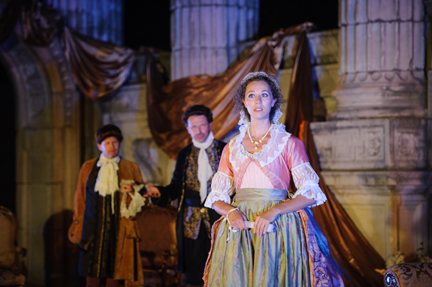
Ryan Egan, Bruce Beaton, & Sochi Fried in”The Misanthrope” (photo by Raph Nogal, courtesy of Guild Festival Theater)
and Racine as their aggregated answer to William Shakespeare), Molière was also an actor and director of his own theatrical troupe and theater. Molière is the pseudonym of Jean-Baptiste Poquelin (1622-73). It has been suggested that he adopted a nom de plume to spare his family the embarrassment of his chosen profession, at a time when actors were regarded as not respectable enough to be buried on consecrated land! Molière was famed for his comedies and satires, though it is said that he actually preferred tragedies. He wrote scathing observations about French society clothed in satirical humor. His work was a marriage of wit and serious purpose, the latter being to skewer social conventions, affectations,
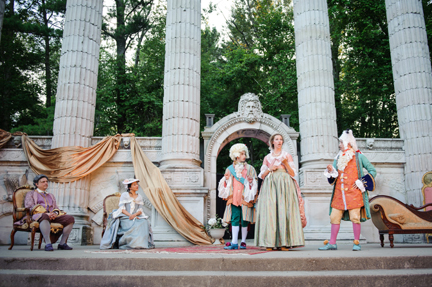
Cast members from “The Misanthrope” (photo by Raph Nogal, courtesy of Guild Festival Theater)
and prevailing views of propriety. Hypocrisy, superficiality, and pretentiousness were among his favored targets. And, my goodness, those targets are as relevant today (and as deserving of our righteous scorn) as ever they were: “What in this shallow age is not debased?” Not surprisingly, then, Molière’s works were denounced by some as being vulgar (and even obscene) as well as impious. But he was celebrated during his lifetime, and his works have stood the test of time. “Le Misanthrope” (1666) is regarded as his greatest masterpiece.
This production begins at twilight and ends under the gleaming stars. And

Andrew Pimento & John Chou in “The Misanthrope” (photo by Raph Nogal, courtesy of Guild Festival Theater)
the English translation by Richard Wilbur loses none of the playfully rhyming wit of the original text (“Suppose you met with someone you couldn’t bear; would you tell them of it then and there?”). Indeed, the play’s language and its rhyming and its wit are irresistible: “I’d have them be sincere and never part with any word that isn’t from the heart,” says the antihero of the title. Alceste is a solitary man who detests all that is insincere, affected, and false (“I am, I fear, inclined to be unfashionably sincere,” he says, in a triumph of understatement). He finds those traits ubiquitous in the society of his day, and so he can scarcely tolerate the company of others. For, something — he would call it honesty, others might
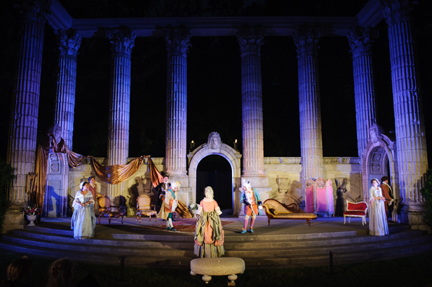
Cast members from “The Misanthrope” (photo by Raph Nogal, courtesy of Guild Festival Theater)
dub it pride — compels him to openly condemn falseness, even when prudence might better counsel him to silence: “I spurn the easy tribute of a heart that will not set the worthy man apart.” Alceste is not one to suffer fools gladly; and he admits of no shades of grey: “I’m either right or wrong.” For him, a thing is true or false, deserving either praise or condemnation. He sets his ideals above all, an approach that is not inclined to moderation. His long-suffering, more moderate friend, Philinte, recommends instead his own approach: “I take men as they are, or let them be.” But Alceste cannot ‘let things be’ when he objects to them. He is driven to criticize all that falls short of his vision of a nobler man; and there are
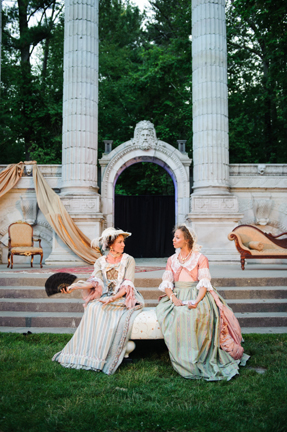
Tina Sterling & Sochi Fried in “The Misanthrope” (photo by Raph Nogal, courtesy of Guild Festival Theater)
targets aplenty among the preening, affected courtiers he encounters. When one high-ranking figure from the royal court insists on Alceste giving a candid, no-holds barred assessment of a love sonnet he has penned, little does he know, despite Alceste’s warnings, that that’s exactly what he will get. Alceste tells him that it is bad enough that the man composed such drek, but that he should be hung from the nearest tree for having the shameless temerity to read it aloud!
Alceste speaks for the playwright in critiquing the ills of his society, under Louis XIV (the so-called “Sun King”). Among those ills are many that are all too familiar to us today, like indecent gaps between rich and poor, conspicuous consumption by the former, sycophancy in place of speaking truth to power, and shortfalls of integrity and public-mindedness at every turn. But Alceste is not simply a critic and habitual contrarian, he is also worthy of some criticism himself. His moral rectitude smacks of pridefulness; and, for all his high standards about sincerity, he is hopelessly smitten with a young lady who wears her coquettishness as a second skin. Indeed, much of the second half of the play is given over to Alceste’s misgivings and torments of jealousy over the lady love whose flirtatious ways and vacuous friends from court make her eminently incompatible with all that Alceste holds most dear. Mind you, who among us has not felt the power of magnetic attraction to one who may be unsuited to us in temperament? But in some respects Célimène is an excellent foil for Alcetse, correctly divining that he is “in love with contradiction,” and refusing to take his stern humors as seriously as he takes himself. Still, the tribulations of Alceste’s jealous wooing are much less engaging than the first half of the play’s focus on his critique of a corrupt and disingenuous world. The real strength of the play lies in the first of its two acts.
Director Sten Eirik makes excellent use of the unconventional stage. It is appointed with three chairs, one settee, a cushioned recliner, and a screen, with soft-gold cloth draped across the walls at the rear. It’s a minimalist stage decoration, but it sets the scene and the mood perfectly. The same goes for the lighting design and for the use of the music by Bach and Handel. And Bonnie Deakin’s lush period costumes are a pleasure to behold. Best of all is the cast. They are simply note-perfect, with Bruce Beaton as Alceste, Sochi Fried as the object of his desire Célimène, Rick Persich as Alceste’s only friend Philinte, John Chou and Andrew Pimento as the effete, primping aristocrats Arcaste and Clitandre, Tina Sterling as a vengeful lady scorned (Arsinoe), Leslie DosRemedios as the gentle Eliante, and Ryan Egan as Oronte, the unfortunate author of maladroit sonnets. Those actors, and each of the remaining supporting players, bring Molière’s wit and rhyme to life in a memorable production of a great play. It deserves to go on the road to bigger venues. In the meantime, we wait with baited breath to see what Sten Eirik and the Guild Festival Theatre have in store for us next summer.
John Arkelian is an award-winning journalist and author.
Copyright © 2013 by John Arkelian.
“The Misanthrope” ran from July 18 through August 11, 2013 at the Guild Inn Park in Scarborough, Ontario. For more information about the Guild Festival Theater, visit: http://www.guildfestivaltheatre.ca
*************************************************************
The Story of a Life:
“Kim’s Convenience” at Port Hope Festival Theater
© Reviewed by John Arkelian
The mark of a great story is its ability to be very particular, to explore the microcosm that is the life of one person, one family, or one culture, and to

Grace Lynn Kung & Paul Sun-Hyung Lee in “Kim’s Convenience” (photo by Cylla von Tiedemann, courtesy of Soulpepper Theatre)
simultaneously have a free-ranging applicability and resonance that strikes a familiar chord with an audience from outside the story’s specific time, place, or cultural setting. “Kim’s Convenience” is just such a story: Funny, poignant, and oh so relatable, this wonderful production is not to be missed! The debut work of playwright Ins Choi was the hit of Toronto’s Fringe Festival in 2011, and it played at Soulpepper Theatre Company the following year. Currently touring Canada, the remounted production (directed by Soulpepper’s Artistic Director Albert Schultz) was presented in July 2013 at the intimate delight that is the Port Hope Festival Theatre (a.k.a. the Capitol Theatre). Artistic Director Uwe Meyer works wonders

Paul Sun-Hyun Lee in “Kim’s Convenience” (photo by Cylla von Tiedemann, courtesy of Soulpepper Theatre)
there year-round, with a full roster of concerts, films, an annual pantomime, and a yearly quartet of plays produced in-house every summer. This summer, in an exception to the in-house norm, Meyer treated us to the touring production of “Kim’s Convenience.” And what a treat it was!
The setting is a convenience store in Toronto’s Regent Park neighborhood. The characters are the Korean-Canadian family that runs it. The subject is a clash of cultures and of generations. There’s a cast of five actors: Paul Sun-Hyung Lee plays the patriarch Mr.Kim Sr. (better known as Appa). He’s set in his ways and stern, but he loves his family, and he generates much warm laughter. Grace Lynn Kung plays Janet, his daughter. She’s 30 and single, to the chagrin of her traditionally-minded parents: “Now is desperation time for you,” observes her ‘calls it like he sees it’ father. Andre Sills plays four roles. One of them is a Jamaican-Canadian whose Rastafarian lingo meets its match in Mr. Kim’s heavily accented English. In another role, he plays a black policeman who reunites with Janet years after their childhood acquaintance and ignites a mutual interest that’s all grown-up, to the initial dismay of the Kims, who’d hoped for an ethnically homogeneous

Ins Choi, Paul Sun-Hyun Lee, Jean Yoon, Grace Lynn Kung, & Andre Sills in “Kim’s Convenience” (photo by Cylla von Tiedemann, courtesy of Soulpepper Theatre)
match. Jean Yoon plays Mrs. Kim’s (better known as Umma). In a poignant flashback scene with her husband, the stage is completely dark, except for a single spotlight on the couple as they recall their arrival in Canada as strangers in a strange land, and the hard work that made them a new life. Playwright Ins Choi rounds out the cast as Jung, the Kims’ son, who left home at age 16 and has been estranged from his father ever since. Each and every member of the cast is note-perfect, conjuring characters who seem as real to us as the people we know in the quotidian world.
Mr. Kim has run his store (the family lives upstairs) for years. But the neighborhood is starting to change: The prospective arrival of some big retailers bodes ill for established small stores like Kim’s. As the play opens, a well-heeled developer (one of Sills’ four roles) offers to buy Kim out. “Do you have an exit plan from this life?” he asks Kim. But Kim has long equated his life with his store. He wants his daughter to take over the business store and make it “a Kim’s Convenience dynasty.” But Janet has other ideas. Thoroughly Westernized and modern, she’s an independent-minded young Canadian woman, and she wants to make her living as a professional photographer. That life-goal, and her growing interest in the police constable (the aforementioned childhood friend) who pays them a visit one day, don’t go over well with Mr. Kim. And will his proud reserve crack when he learns that his prodigal son has a wife and an infant child? The play has a sure-feel for these characters. They are of a specific time and place and ethnic milieu, but their hopes and disappointments and relationship issues are universal. As Albert Schultz has said, it is ‘a picture of one family in one community,’ but, “its subject matter is extremely familiar (literally)… [and] despite that familiarity, it feels so original. And it feels very Canadian.” But, really, one could say North American in lieu of Canadian. It’s about newcomers to the still new ‘New World,’ a place that has traditionally welcomed people from every part of the wider world — whether they are fleeing intolerance or oppression or simply seeking to better their lot in life. And, ultimately, Mr. Kim comes to realize that what really matters in his life is family: “Is this store my story? No. My story is you and Janet and Umma.” The result is heart-warming, funny, and instantly authentic — from its first moment to its last. What is more, “Kim’s Convenience” is a memorable highlight of the theater season, a play we would welcome the chance to see again. If it comes to your town, drop what you are doing and go see it!
John Arkelian is an award-winning journalist and author.
Copyright © 2013 by John Arkelian.
“Kim’s Convenience” ran from July 11 through 28th, 2013 at the Capitol Theatre in Port Hope, Ontario. For more information about the Capitol Theatre’s year-round programming, visit http://capitoltheatre.com/
*************************************************************
Every Answer to the Universe:
“The Real McCoy” at 4th Line Theater
© Reviewed by John Arkelian
Can lightning strike twice? Yes, it can. And, it did, too, at a farm on the
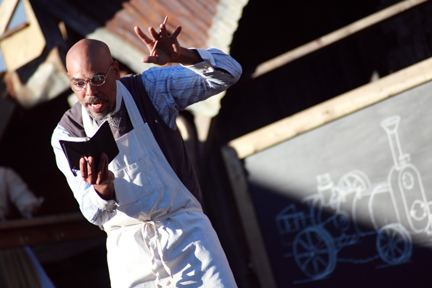
Beau Dixon (as Elijah McCoy) in “The Real McCoy” (photo by Wayne Eardley, courtesy of 4th Line Theatre)
outskirts of the village of Millbrook, Ontario, where 4th Line Theatre is presenting their second winning play of the season. Originally produced by Toronto’s Factory Theatre in 2006, “The Real McCoy” is a biographical drama about the little known engineer and inventor Elijah McCoy. A wunderkind of human invention, McCoy was walking proof of his father’s contention that, “Every answer to the universe is right before your eyes.” What unfolds, between the years 1844 and 1929, is an exploration of the life and psyche of a man who is captivated by the possibilities of the human mind to understand, emulate, and even overcome the physical universe we inhabit. It’s a full-body immersion into human creative intelligence — that
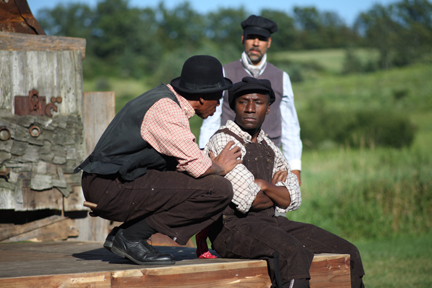
Carson Durven, Andrew Moodie, & Beau Dixon in “The Real McCoy” (photo by Wayne Eardley, courtesy of 4th Line Theatre)
curiosity that makes us ask how things work, and the drive, determination, and sheer creative willpower needed to conquer engineering challenges and extend the realm of the possible in human affairs. Truth be told, those self-same attributes are as apt to yield monstrous new instruments of war as they are the implements of a more peaceable kingdom. But Elijah McCoy’s fertile inventiveness seems to have been devoted to peaceful innovation — particularly in the field of steam engine train transportation.
Elijah McCoy was a black man, the son of former slaves who had found freedom in Canada. After a childhood in the small community of Colchester
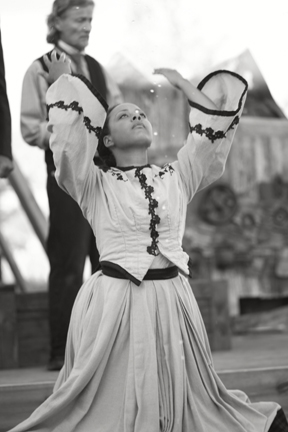
Robert Winslow & Kate Milleman in “The Real McCoy” (photo by Wayne Eardley, courtesy of 4th Line Theatre)
(in southwestern Ontario, not far from the border with Michigan), McCoy’s academic success (and admirably encouraging father) landed him a scholarship to the University of Edinburgh, where he soon distinguished himself under the prominent engineering professor, William Rankine. After graduation, he ended up in Michigan, where not even his brilliance negated the prejudice that came with the color of his skin.
As a play, “The Real McCoy” is as inventive as its subject. An ensemble cast of only seven actors (five men and two women) portray 45 different characters (as well as giving convincing voice to a horse or two). And there’s not a weak link among them: Beau Dixon, Carson Durven, Matt Gilbert (who returns from 4th Line’s other summer production, getting many more opportunities to demonstrate his acting chops here with his eight roles), Kallie Milleman, Melanee Murray, Robert Winslow, and Andrew Moodie (who also wrote the play), make their multitude of role changes look effortless. There’s a very nice hand-over, relay-race style, between two actors playing McCoy at different ages in his life. It opens with the entire cast walking in single file, singing a Negro spiritual. They enter the main set — a workshop comprised of poles and pipes and metal cylinders, as well as wheels and irregular flotsam and jetsam of wood. They take their places at the equipment, which is inventively called into service as impromptu percussion instruments, singing “Hold on! Keep your hand on that plow, and hold on!” It’s as much a song about life as it is about hard work. The adult Elijah narrates the story of his life: Here’s his mother, who dies giving birth to him and then anoints herself from a water feature on the set, an affecting ritual that recurs throughout the play. There’s the stern Scottish don (the aforementioned Rankine), who is as defiantly determined to outwit the universe as Elijah himself. And here’s a playful pantomime of people on a train, with the actors mimicking the sounds and motion of their conveyance, as a newly graduated Elijah looks out the window, with his irrepressible eagerness for discovering all that’s new and unfamiliar. Another song, “O Chesapeake Bay,” is a high point of musical director Justin Hiscox’s original score, perfectly capturing the flavor of the time, the place, and the people. One character, Don Bogie (performed by playwright Moodie) is, likewise, a colorful highlight from a role call of characters that never ceases to grab the viewer’s interest — even when they make only a very brief appearance, like one Mr. Parks, a tyrannical, bigoted variation on Colonel Sanders. Director Kim Blackwell makes effective use of the ground space and multileveled balconies; though this production is an exception to the rule at 4th Line insofar as it is more incidentally staged outdoors than organically so. But don’t pay that ‘no never mind,’ as the saying goes: This is a production that wants for nothing, combining as it does, fine acting, sure-handed direction, a first-rate script, and many engaging details: In one inventive touch, McCoy’s technical drawings and blueprints appear on the sides of the homespun quilts strung on the clothes line that hangs high above the main stage space. In an amusing sequence, a domestic irritant prompts Elijah to design a portable ironing board.
The Elijah McCoy presented in the play is cerebral, stoical, and reserved. It’s a tribute to the cast and writer that they can (and do) invest a man who is a bit stiffly intellectual (there’s more than a little of Mr. Spock in him) with such authenticity. He falls in love twice and is driven to despair by unhappiness late in the play, but his world is the world of ideas: Solving practical problems (be they as mundane as an ironing board or as industrially momentous as a revolutionary way of lubricating steam engines) is his natural element: As a boy (he never loses some ineffable boyishness of enthusiasm) and as a man, he delights in tackling challenges of understanding and mastering questions posed by physics and engineering. A man of technical ingeniousness, boundless curiosity, and a yen to solve insoluble problems, Elijah is a study in creative thinking; leaving more emotive, colorful attributes to the characters that swirl around him. In the end, grief brings him down, but even the words uttered in his delirium epitomize the lifelong search for understanding and order: “I can see. I can see the universe. The order of all things… It’s so simple… so beautiful.” The man depicted in the play may or may not be the inspiration for the aphorism, “the real McCoy,” but there’s no doubt that this play is indeed the genuine article.
“The Real McCoy” runs from August 2 – 24, 2013. Visit 4th Line Theatre at: http://4thlinetheatre.on.ca/
John Arkelian is an award-winning author and journalist.
Copyright © 2013 by John Arkelian.
*******************************************************
Could We Not Be One Strong Tribe?
“The Winslows of Derryvore” at 4th Line Theatre
© Reviewed by John Arkelian
“When you looked at the map, Ireland and England seemed like lovers… ‘Does the map remind you curiously of an embrace? A most extraordinary embrace to throw up all this.’”
William Trevor (Irish novelist and short story writer, “Fools of Fortune,”1981)
“I am an Irish rebel to the backbone and the spinal marrow…”
Charles Gavan Duffy (Irish nationalist and, later, an American politician, 1816-1903)
The year is 1617; the place is County Fermanagh (in what is now Northern Ireland). An unseen bagpipe and drums herald the arrival of a middle-aged man in a cloak as he approaches across an expansive meadow strewn with tall
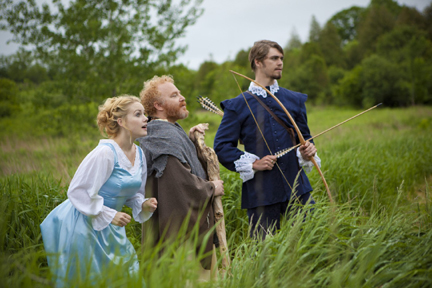
Heather Maitland, Dov Mickelson, & Jake Vanderham in “The Winslows of Derryvore” (photo by Wayne Eardley – courtesy of 4th Line Theatre)
grasses. Brandishing a walking stick that serves simultaneously as a wizard’s staff, a warrior’s cudgel, and a priest’s crosier, this itinerant poet tells the history of an Irish prince who was lost in battle with the English during the Nine Years’ War. Waged between 1594 and 1603, that conflict was the largest armed conflict fought by England during the Elizabethan era; it ended with the defeat of the Irish. In its aftermath, the English victors displaced most of the Irish landowning class in favor of their own, who, in effect, colonized the conquered land, reducing its natives to the status of tenant farmers. So, now, the poet, who has more than a little of a druid about him, decries lost glories, as three female faeries act out the story’s prologue in pantomime as he tells it. His defiant air, and his readiness to meet the eye of his foreign overlords attracts their suspicion, and the poet is on the verge of incarceration (or
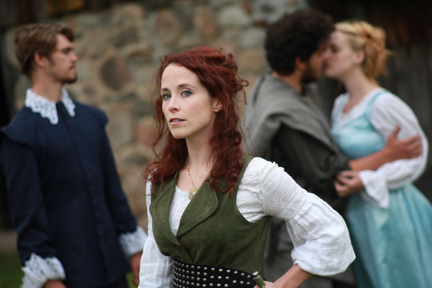
Jake Vanderham, Heidi Lynch, Griffin Clark, & Heather Maitland in “The Winslows of Derryvore” (photo by Wayne Eardley – courtesy of 4th Line Theatre)
worse) when he is saved by a young English boy. Thereafter, the fortunes of the Irish poet are closely linked to those of the English boy, Thomas Winslow, who goes on to befriend an Irish boy and fall in love with an Irish girl. But the Winslows’ affinity for their Irish tenants is not a sentiment that is widely shared among the English: Most regard their subjects with indifference, disdain, or outright hostility.
What ensues is an engaging story of friendships strained by bitter sectarian enmities, as even the best of intentions (“Could we [the combined English and Irish] not be one strong tribe?” asks Thomas) fly asunder in the heat of festering grievances and competing national identities. With a cast of over 65, the play takes a national conflict and boils it down to its essence — the
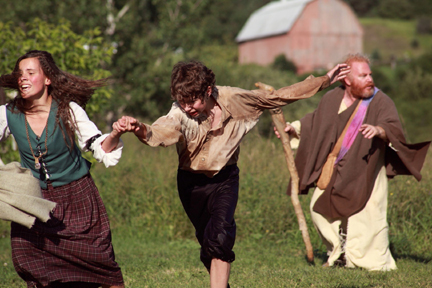
Madison Sheward et alia in “The Winslows of Derryvore” (photo by Wayne Eardley – courtesy of 4th Line Theatre)
attractions and collisions between individual men and women. Sad to say, but when competing tribal, sectarian, or national aspirations roil to the surface, most of what we call human decency drifts away like an insubstantial pageant of mist: It is hard to feel empathy for (and it is correspondingly easier to mistreat) those we choose to see as the “other,” but maybe that is precisely why human beings are so prone to creating arbitrary distinctions between “us” and “them.”
The setting for this drama is a farm in the idyllic countryside of rural Ontario. Situated amidst the gently rolling green hills near the quaint village of Millbrook, the meadows, copses, ponds, and barnyards of the Winslow farm have been transformed into a venue for outdoor theater — original dramas
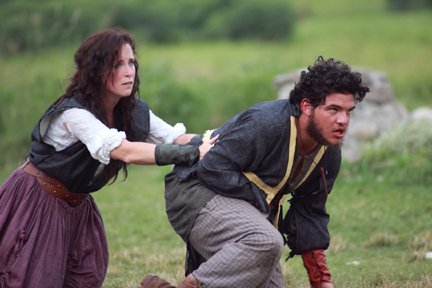
Heidi Lynch & Griffin Clark in “The Winslows of Derryvore” (photo by Wayne Earley – courtesy of 4th Line Theatre)
which spring not only from the rural landscape in which they are set, but also from the rich history of the surrounding Cavan Township and its near-beyond. Past productions have been drawn from the lost era of traveling county fairs; the days of one-room schoolhouses; the rise of a man from Cobourg who became an internationally acclaimed high-wire daredevil; the tragic life of the author of a famous Christian hymn; Millbrook’s contribution to the militia that quashed the 1885 North-West Rebellion (until not too long ago, Millbrook was home to booty from that conflict, in the form of ‘the bell of Batoche’); and, in 4th Line’s seminal production, “The Cavan Blazers,” the township’s early sectarian conflict between Irish settlers of competing denominational allegiances.
Written and directed by 4th Line Theatre’s Artistic Director, Robert Winslow,

Dov Mickelson and friends (of the equine and supernatural varieties) in “The Winslows of Derryvore” (photo by Wayne Eardley – courtesy of 4th Line Theatre)
“The Winslows of Derryvore” spans the years 1617 to 1690, though much of it is set before, during, and after the bloody rebellion of 1641. It travels much further afield, geographically, than 4th Line’s other productions, insofar as it takes place abroad; but there is a tangible through-line that connects this historical drama in Elizabethan-era Ireland to the idyllic surroundings of a farm in 21st century central Ontario: The Winslow farm was settled by the descendants of the play’s idealistic young Thomas Winslow — and, even centuries later, they were beset by sectarian conflict of a sort that would have been all too familiar to him.
The play was originally staged at 4th Line in 1995. This remount assembles many talented players among its large cast. In no particular order, the

Dov Mickelson, Heather Maitland, & Jake Vanderham in “The Winslows of Derryvore” (photo by Wayne Eardley – courtesy of 4th Line Theatre)
stand-outs of this production are: Dov Mickelson (who starred in 4th Line’s production of “The Right Road to Pontypool” for two summers, a delightful account of a resort for working class Jews in the environs of Cavan) as the poet cum wise man O’hEoghusa; Jake Vanderham, as the adult version of Thomas Winslow, a good man whose best instincts come to naught in the face of the single-minded belligerence of those around him; both Heidi Lynch and Madison Sheward, as, respectively, the adult and childhood incarnations of Ciara Maguire, the beautiful free-spirited Irish girl whom Thomas loves (young Sheward is, remarkably, a volunteer actor; she shows great promise as a talented thespian; and the transition between her and her older counterpart is well-nigh seamless; indeed, both actresses in the role share a winning smile and infectious vitality that make them instant scene-stealers); Griffin Clark, as Turlogh Maguire, Thomas’ Irish blood-brother, his competitor for the love of Ciara, and the fearless leader of the ill-fated rebellion against the English in 1641 that takes up much of the play’s second half; Rob Fortin as the ruthless, smugly arrogant Sir William Cole, the overlord of the English in the area; Tim Ziegler as the cruel and brutal Michael Balfour, the young scion to one of Fermanagh’s leading English families; Heather Maitland as the adult version of Mary Winslow, the sister of Thomas, whose pride does not earn her the unhappy fate with which she is beset; Matt Gilbert as Brian Maguire, the only member of the Irish landowning class to retain his lands after the war, a solitary man in a short black beard and wide-rimmed hat, who cuts a dashing, mysterious figure as he navigates precariously between two opposing sides; Mark Hiscox as Guy Winslow, Thomas’ father, an English colonist ‘planted’ in Fermanagh in 1617 as the freeholder of 500 acres in a district that had been the ancestral home of the suddenly displaced Maguire clan for a thousand years; and Victoria Salem, an apprentice actor who makes a strong debut as the Elizabeth Cole, a young English lady of refined manners and upbringing who abides incongruously in the midst of coarse manners and coarser mores.
4th Line’s long-serving Musical Director Justin Hiscox contributes a lively score; each and every 4th Line production weaves instrumental music and song into its storytelling. The production has moments of merrymaking, romance, and steadfast friendship to leaven its portrayal of conflict. There is panorama here, with a natural ‘stage’ that extends into the distant meadows and groves. There are horses and riders — and swallows which seem to appear on cue. And there is humor here, too, most memorably in the loud, angry denunciation by the upright Guy Winslow of a murderous fellow Englishman as an “abominable knave.” The villain responds to his public dressing-down by dropping dead on the spot, which prompts some wag to observe to Guy, that, “Your bark is worse than most men’s bites.” A remark early in the play, that, “I’m for home, sir. Your man’s arse has put me off my pudding,” is no less funny for its mild vulgarity. And, to its credit, the play addresses the irony that common folk never come off well in the contests between their “betters;” knowing this, they still express the sentiment, shared by many who squirm under the yoke of colonialism, that, an oppressive indigenous overlord is to be preferred to a foreign one: “At least the old tyrants were our tyrants.” And the clash of cultures is evident even among friends, as the hot-blooded Irish (is that a stereotype at work?) grumble impatiently at the strenuous efforts of their English friend (and protector) Guy to deescalate a crisis through words — and through a major personal sacrifice. They know he means well, but they nevertheless feel contempt for his use of diplomacy instead of violence. The script might have benefited from a bit of trimming; the second half is dominated by warfare, atrocities, and reprisals — all of which are handled competently, but they remain a tad less engaging than the quieter, character-driven stuff of the first half. And, the pivotal figure of Ciara disappears too abruptly from the narrative, without a satisfying resolution as to her fate, save that she seems to assume the vacated mantle of O’hEoghusa, as the collective memory and conscience of the Irish. At its heart, “The Winslows of Derryvore” is a coming of age story, tracing the life of its central protagonist, Thomas, whose brave attempt at putting aside sectarianism in favor of “one big tribe” collides with the harsh reality of people who see things more narrowly: “I loved my Irish neighbors and I thought they loved me…. There is no magic in the land where the innocent are slaughtered.” But magic does abide in the land, as this bewitching production proves.
“The Winslows of Derryvore” runs from July 2 – 27, 2013. Next up is “The Real McCoy” (August 5 – 24, 2013) about the unsung engineer, scientist, and inventor, Elijah McCoy. Born in Canada to runaway slaves; McCoy’s work revolutionized the steam engine. Set between 1844 and 1922, “The Real McCoy” has 45 characters played by seven actors. It was originally produced by the Factory Theatre in Toronto in 2006. Visit 4th Line Theatre at: http://4thlinetheatre.on.ca/
John Arkelian is an award-winning author and journalist.
Copyright © 2013 by John Arkelian.
*************************************************************
“A Spirit Walk:
Past Meets Present in Sublime Ways at the Pickering Museum Village”
© By John Arkelian
“People will not look forward to posterity, who have never looked backward to their ancestors.” Edmund Burke (1729-97)
Nightfall. The September evening air is crisp as we descend a sloping hill

Stranger in a strange land (photo by Greg Oakes, courtesy of Pickering Museum Village).
under the gleaming stars, the path before us illuminated only by flickering candlelight. We soon enter a dark, silent forest, traveling with a party of a dozen or so others. Our guide is an early 19th century settler named Hannah Matthews, and, as we walk under the boughs of the towering trees, we encounter a succession of characters in period attire from the earliest days of Pickering Township. There’s the haughty Captain George Law, an officer and rather disdainful gentleman who quit the Thirteen Colonies after their Revolution, with other United Empire Loyalists, and now finds himself peevishly out of sorts with the unrefined folk who live and work in the Township. The Captain is here to look over his grant of land; he would not dream of living on-site, or brushing elbows with the homesteaders he regards as mere-ruffians. He would prefer to enjoy the amenities of the capital, while he waits for his unoccupied track of land to appreciate in value sufficiently for him to sell it at a handsome profit. Then there’s the Major family, pitching camp for the night under the trees and offering a hearty welcome (and a few jolly anecdotes) to our band of travelers. Crossing a bridge over the rushing current of the stream, we encounter a breathless, but ever so determined Mrs. Samuel Munger who is abroad alone at night in hunt of the bear that has made off with one of her pigs. She looks us up and down, wondering aloud if we are made of sturdy enough stuff for these parts. When someone coined the term ‘salt of the earth’ they had the doughty likes of Mrs. Munger in mind: And the retort of her rifle after we have parted ways tells us that she caught her prey.
Part scripted play, part full body immersion into the lives of Pickering Township’s original pioneers, the Pickering Museum Village’s wonderful annual event, “A Spirit Walk,” is the next best thing to time travel. It engrosses, it delights, and it edifies. If you thought history was dull, think again. “A Spirit Walk” makes history come alive–capturing the laughter, determination, joy, and sorrows of our ancestors, through a presentation that feels as interactive as it does authentic. The characters portrayed are real historical figures from the area; and the Museum Village’s own talented

Armed for bear (photo by Greg Oakes, courtesy of Pickering Museum Village).
theatrical troupe, the Backwoods Players, imbue those characters with the full gamut of human emotions. Every year, on four evenings in September, the cast of more than 50 volunteers draws visitors into a waking dream, as the audience moves from one location to another: And the journey we take is through time as well as space; with each vignette set at a different moment of a timeline that spans a lifetime. Thus, we see two youngsters exchanging glances at a harvest table. The pair is destined to wed; but young Peter will be executed years later for his part in the Rebellion. And in the bitter aftermath of that desperate attempt to secure responsible government, we see neighbor turn against neighbor, with male members of the Willson family dragged away by the militia in the dark of night.
This marvel is tucked away at the inconspicuous Pickering Museum Village – a kind of Williamsburg of the North – consisting of 19 heritage buildings, occupying a 16 acre site in Greenwood, off Highway 7. Although the museum got its start in 1961, it officially reopened at its current location in 1979. The village comprises a blacksmith shop, a general store, a small church, a school house, a temperance house, a steam barn, and family homes, as well period gardens and orchards, and a forested entry path. Members of the museum staff are justly proud of the authenticity of the restoration work done on the buildings. In the log schoolhouse, for example, the stone hearth features the masonry appropriate to its era, and even the “hewing-marks” on the hand-hewed floor boards match the original style. And authenticity extends to the “prisoner boxes,” exact replicas (fashioned by Museum Village volunteer Darryl Winthrow) of the small carved keepsakes made by Rebellion members during their imprisonment.
The brainchild of the Museum Village’s Katrina Pyke, “A Spirit Walk” started as a one-night-only event. Successful beyond the organizers’ wildest dreams, the number of performance nights doubled to two, then doubled again to four. The event is not unlike the “rum and spirits” tours given in some Ontario provincial parks, the “ghost walks” in countless English towns and cities, and similar events in the Maritimes. But Pyke and her colleagues have taken the concept and run with it – creating a unique play that’s as gripping as anything you’ll see in conventional theaters. As Pyke says, “Our history is something worth sharing and saving…” At the Pickering Museum Village, history is not only saved and shared, it is richly celebrated. Their “Spirit Walk” is an engrossing experience that’s not to be missed. Indeed, you’ll want to repeat the experience the moment it ends!
© October 2012 by John Arkelian.
Editor’s Note: Funded by the City of Pickering, the Pickering Museum Museum Village is situated on Highway 7, 2365 Concession Road 6, in Greenwood, Ontario. The Museum Village offers a range of special events during the year, including “Christmas in the Village,” a Victorian Christmas and Scottish Hogmanay event on December 9, 2012 at 12 pm -3:30 pm. (The Backwoods Players presentation of “A Duffin Creek Sunday School Pageant” is free with admission on December 9th.) Tickets for certain special events, including “A Spirit Walk” should be purchased in advance. For information, call the museum at (905) 683-8401. Or visit: www.cityofpickering.com/museum
************************************************************
Now the Wild White Horses Play — Cavalia’s Odysseo
© Reviewed by John Arkelian
“Now the great winds shorewards blow;
Now the salt tides seawards flow;
Now the wild white horses play,
Champ and chafe and toss in the spray.”
Matthew Arnold, from “The Forsaken Merman” (1849)
Equus: Horse. Eques: Horseman. Horse and man in noble partnership: That

The Travellers from “Odysseo”
is what is at the wild pulsing heart of Odysseo, the follow-up show to Cavalia from the Canadian-led troupe of 71 horses and 55 human performers. It begins in a forest glade: Horses enter the clearing one-by-one, nuzzling a lone woman who greets them; as she sings under the woodland boughs, the nine horses gallop around her, in a scene that could have been written by J.R.R. Tolkien for his mythological masterwork “The Silmarillion.” It’s a magical opening to a show that enthralls with the beauty of movement, form, color, and
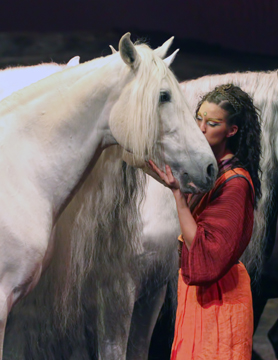
Photo by Pascal Ratthe from “Odysseo”
sound. In the next scene, each of six pairs of white horses carry a woman swathed in purple and standing upright with one foot on each of her two mounts. Then come bare-chested acrobats from Guinea, for hyperkinetic gymnastics with an Afro-beat. They are joined by several men who wear curved prosthetic-stilts which enable them to spring impossibly high into the air. The wonderful effect is that of leaping satyrs, and it is something you have to see to believe. Then, a blonde beauty of the human variety leads six exquisite white Arabians in a languorous dance; her equine partners stand shoulder-to-shoulder, mirroring her every movement, like beloved companions.
Be prepared to gasp in wonder when the forest curtain opens — to reveal a

The Tribe from “Odysseo” (photo by Francois Bergeron)
great vista of rolling foothills. Part of the panorama is the hitherto hidden back half of the stage, which rises in a steep incline; the rest is an illusion deftly conjured by a projected landscape and sky. The vistas change as the show goes on. Day becomes night; summer turns to winter; green hills morph into sand dunes; towers of rock out of the American southwest meld into mighty waterfalls on spring-green hills reminiscent of Iceland. But first comes a stately

Photo by JF Leblanc from “Odysseo”
procession of sixteen horses with silky manes, each bearing a rider adorned in rich hues of ochre, gold, and rose. Is it an Andalusian musical ride, or a re-imagining of Tolkien’s Riders of Rohan? Acrobatics meets modern dance in the next scene, as a large carousel descends from the ceiling and performers artfully ascend its poles like Cirque du Soleil’s finest. When the rear curtain opens again, we’ve been transported to the Grand Canyon: The African tumblers are back; riders race by trailing blood-red banners; and others hang from their saddles at breakneck angles — sometimes upside down!
After the intermission, we’re in the Sahara, with sand dunes stretching to the horizon. A dozen or more horses are arrayed across the enormous stage, laying still in various poses like dancers at rest. One-by-one, they awaken and roll around in the dust. Soon they’re joined by more, until a full-fledged herd of up to 30 horses
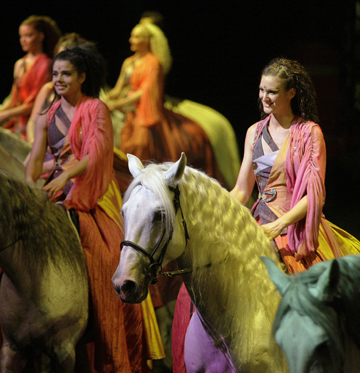
Grand Cavalia from “Odysseo” (photo by Pascal Ratthe)
occupies the stage. They divide themselves according to color and breed, with quartets following human companions. One black stallion becomes an impromptu solo act by leaving his appointed group and racing to the top of the hill — earning applause through his independent act of improvisation. Storm clouds and thunder clear the stage. A large circular hoop descends, and a male performer is lifted high off the ground in a riveting display of high-wire acrobatics that is the very epitome of strength, gracefulness, and life-or-death precision.

Oasis from “Odysseo” (photo by Pascal Ratthe)
The Guineans return for more prodigious flips, drumming, and tumbling. This time, they also do some chanting and get the audience to join-in. They entertain, but perhaps they also feel a bit like “filler” on this return appearance. The drumming continues as a gorgeous white horse – pure white – races about, kicking its legs and suddenly changing direction as
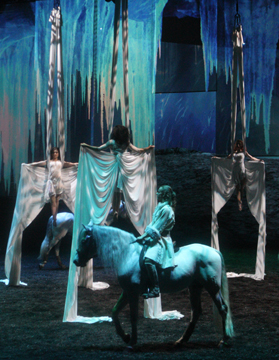
Yhi from “Odysseo” (photo by Pascal Ratthe)
its long silken mane and tail fly free. Then, the scene turns to winter, with a projected blizzard and painted blue-white icicles. Four women are lifted off their horses by twelve-foot swathes of white silk: They perform an aerial ballet while trailing another 25 feet of silken material beneath them. They come together as a human snowflake, as riders circle below, and the resulting carousel of icicles is a showstopper — one of the most breathtakingly beautiful tableaux in the show.
Next come breakneck riding tricks that would be right at home among the Tartars of the Russian steppes. One rider goes down one side of the saddle, works his way under his galloping horse, and returns up the other side, in a stunt that’s almost too unnerving to watch. The final scene is visually arresting: Misty waterfalls are projected on the backdrop as a lone rider and horse stand vigil atop the hill in black silhouette. They are motionless at first; then they go
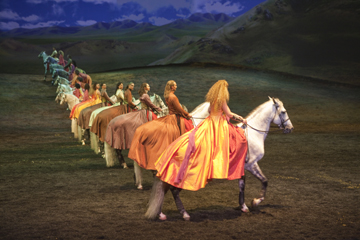
Living carousel from “Odysseo” (photo by Francois Bergeron)
into a canter, dancing in place as they perform precise and elegant dressage moves. Down below, the front stage becomes a shallow lake, quickly filling with water as eight white horses race down the green hill and through the water, “champing and chafing and tossing in the spray,” as Matthew

Merry-Go-Round from “Odysseo” (photo by Pascal Ratthe)
Arnold’s poem would have it. It’s a beautiful, moving tableau. Odysseo is horse and man in noble partnership. It will bring a song to the heart of every man, woman, and child who beholds its wonders.
John Arkelian is an award-winning journalist and author.
© Copyright 2012 by John Arkelian.
Editor’s Note: Odysseo continues its run under an immense pavilion-style big-top on Toronto’s Portlands through Sunday, June 24, 2012. Visit http://www.cavalia.net/en/odysseo for information of how to attend.
***************************************************************
“Jane Eyre on Stage”
© Reviewed by John Arkelian
Whitby Courthouse Theater closed out its main season* with an ambitious stage production of “Jane Eyre” on May 4 & 5, 2012. Despite a commendable effort, the amateur troupe’s reach may have exceeded its grasp in this case. Willis Hall’s stage adaptation of Charlotte Bronte’s beloved 1847 novel about star-crossed love ran to just over three hours (including the intermission). Its heavy reliance on a kind of Greek chorus to narrate its heroine’s experiences was an interesting idea, but its over-use tended to distance us from the character instead of giving us deeper insight into her thoughts and feelings. Perhaps the fault lay in devoting so much of the narration to mundane (and unnecessary) plot explication, rather than plumbing the depths the heroine’s soul. Director Janet Strevenson efficiently wrangled a large cast, but their acting ability was uneven. As young Jane (30 minutes of the play is devoted to Jane’s childhood), Isabelle Blanusa made her strongest impression when she was called upon to sing a brief solo: The youngster is a strong singer. Amanda Langille was quite good as the adult Jane; but she played the character as more demonstratively emotive than seems to fit a character we more typically associate with calmness, reserve, and stoicism. For his part, Robert Calvert (as Edward Rochester) was hampered in the first act by an affected accent that grated; but he redeemed himself admirably in the opening part of Act 2: The accent receded as real acting gave voice to his anguished and desperate pleas to Jane not to leave him. Elsewhere, the skilled Judith Edmondson made an impression as Mrs. Fairfax; while Mark Kalzer brought some unexpected comic relief to the small role of Lord Ingram by seemingly channeling Oscar Wilde.
Off-stage laughter by the confined first Mrs. Rochester did not evoke the eeriness or mystery it should. And the very spare production design left too much to the imagination. In many scenes, the only set-dressing was a plain staircase, leaving fully three-quarters of the stage in need of something — mayhap a Gothic arch or two, windows (were there walls on which to put them), framed paintings, a fireplace, a chandelier, or a grandfather clock — to convey a more tangible sense of place. “Jane Eyre” gains its traction from the interplay of character, setting, and mood. The minimalist approach to the set design in this production undermined the latter two ingredients; although the costume design was nicely done. “Jane Eyre” was a strong effort for a fair result from one of the region’s finest little theater troupes.
© May 2012 by John Arkelian.
*The WCT’s youth group will present a musical, “Back to the 80’s,” in June 2012. Watch Artsforum’s online edition or visit www.whitbytheatre.org for details.
***************************************************************
In the Vinyl Cafe
Raconteur, storyteller, and humorist Stuart McLean is a mainstay on CBC

CBC Radio’s Stuart McLean
through his weekly radio show, The Vinyl Cafe. Many episodes of the show are taped on the road, on stages across the country. On a very fortuitous Friday the 13th (in April 2012), it was Oshawa’s turn to enjoy the patented combination of engaging stories, good music, and folksy charm that are the hallmarks of McLean’s show. The heritage Regent Theater (recently bereft of its ornate plaster ceiling, alas) was filled to the brim with enthusiastic listeners. So enthusiastic were they, in fact, that sections of the show became interactive, to the apparent delight of McLean & company. In a good-natured drawl, he treated the assembled throng to three of his beloved “Dave and Morley” stories. The first was the ever-popular account of the waterslide to beat all waterslides that is assembled by neighborhood children at the urging of an elderly onlooker. The second story recounted mishap-prone Dave’s visit to the carwash with his neighbors’ pride-and-joy Lexus. Disaster ensues, of course; but, as McLean wryly noted, at least his hapless protagonist “was exceptionally clean” by the end of his ordeal. The third story was, perhaps, still a work in progress, involving the struggles of Dave’s daughter at university — with her dreaded statistics class, an eccentric professor, and his metronomically-gifted cat. The secret of McLean’s storytelling? Why, no more or less than instantly likable characters (they feel as familiar as good friends), humorous, down-to-earth, and often gently poignant situations, and impeccable timing.

Ruth Moody
McLean’s music director, John Sheard, offered up a bittersweet Scottish ballad, “You Take the High Road,” on solo piano; there was amusing horseplay over the distribution of prizes to audience members on both ends of the age-scale; and the audience was treated to four songs by the exceptionally talented Canadian singer-songwriter Ruth Moody. Moody is a founding member of the dazzling Wailin’ Jennys (the Juno Award-winning trio performed at a concert put on by Durham’s late, lamented Vital Spark Folk Society a few years back), but on this occasion, she sang selections from her solo album “The Garden.” One, “Tell Me,” was inspired by Patsy Cline; another, “Closer Now,” was a love song in the style of a waltz. Moody also sang Randy Newman’s song “I Think It’s Going to Rain Today” for the first time in public. At the end of the show, McLean promised to be back in two years; but it will take the patience of the long-suffering Morley for Durham audiences to wait that long for a return visit from such old friends.
Review © April 2012 by John Arkelian.
****************************************************************
Of old the world on dreaming fed —
Cirque du Soleil’s “Quidam”
Reviewed by John Arkelian

From “Quidam” (courtesy of Cirque du Soleil)
“The woods of Arcady are dead,
And over is their antique joy;
Of old the world on dreaming fed;
Grey Truth is now her painted toy.”
(W.B. Yeats from “The Song of the Happy Shepherd” — 1889)
Color came back into this grey old world of ours in the triumph of the imagination which is Cirque du Soleil’s “Quidam” — now playing at Oshawa’s G.M. Center. Like the dream of a child, it is filled with innocence and wonder, as a knock on the door announces the arrival of a headless figure. That surreal visitor leaves behind a bowler hat, which, once it is donned, transports the child (and us along with her) to a place that is strange and wonderful. And, oh, the marvels we behold: A man in a giant wheel rotates and spins across the stage at impossible angles; women of Oriental visage fling dumbbell-shap
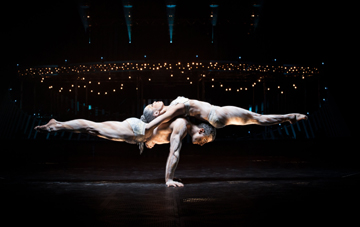
From “Quidam” (courtesy of Cirque du Soleil)
ed props high in the air and gracefully catch them — on mere string; a fe
male f
igure emerges from a cocoon of scarlet silk high in the air to perform an airborne ballet; a man does an infectiously funny pantomime of driving a
car, making amorous advances to the hapless member of the audience he recruited to sit beside him in his invisible conveyance; an ensemble does things with skipping ropes that defy belief; and that’s just the first act!
When the lights go down again, a lone woman does acrobatic gymnastics on three miniature platforms; a quintet of men and women soar on ropes; and, in what may be the most jaw-dropping exhibition of the evening, a pair of pale blonde Gemini twins perform astonishing feats of balance and strength as their intertwined bodies become mirror images of one another (a

From “Quidam” (courtesy of Cirque du Soleil)
t one point, he stands motionless while she poses upside down with her legs straight up, supported by nothing more than his shoulders); a
nd the ensemble returns for a tour de force display of gymnastics, forming a human trapeze and assembling a living tower of three men standing on each others’ shoulders as they catch the girl who is hurled up to them from below.
All these enchantments, and more, are punctuated by cracks of thunder and flashes of lightning (a thunderstorm is a central motif of the show) and flawlessly choreographed to music from a live band that conjures Jewish, Greek, Italian, and Gypsy musical roots. “Quidam” is an astounding,
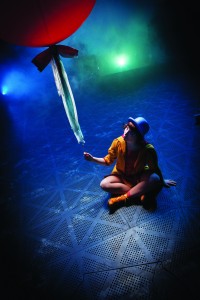
From “Quidam” (courtesy of Cirque du Soleil)
kaleidoscopic blend of color, movement, music, and form. It is the heady stuff of pure imagination, boundless artistry, and sheer athletic excellence. It transfixes like a dream — and it is not to be missed! It will leave you absolutely spellbound — and wanting to see it all over again!
John Arkelian is an author and journalist based in the Toronto area.
© 2012 by John Arkelian.
Cirque du Soleil’s “Quidam” plays at the General Motors Center, 99 Athol St. E., in Oshawa on January 4-8, 2012. For tickets call 1-877-436-8811 or visit www.generalmotorscentre.com
****************************************************************
“Groovin’ Thru the 60s” at Port Hope’s Capitol Theater
© Reviewed by John Arkelian
The Sixties were many things to many people: The decade was a time of vigorous social and political dissent, over war in Southeast Asia, racial inequality at home, and prevailing notions of conformity; but it was also a period of fertile experimentation and change in such fields as music, fashion, lifestyle choices, and civil rights. Sometimes turbulence has the effect of oxygenating and enlivening an otherwise turgid, static environment; and, surely, the 60’s were just such a time. For the Capitol Theater in Port Hope, Ontario, the summer of 2011 was a time to relive, remember, and relish the summer of 1967 (or thereabouts). Its production of “Groovin’ Thru the 60s,” written and direct ed by the theater’s versatile artistic director Uwe Meyer, was a musical trip down memory lane, alternating a succession of instantly recognizable songs from the Sixties with narrated anecdotes from the lives of Canadian teens from “the summer I came of age:” One picked tobacco on the long hot days of summer; one embarked upon a cross-country jaunt in a beat-up old jalopy nicknamed ‘Harold,’ learning to ‘French-kiss’ along the way; others made a surreptitious trip across the border to Woodstock; while another went about the even more secret mission of buying his first package of condoms. Those stories, and others, were full of nostalgia and wry humor, transporting the audience back, in the interludes between songs, to their adolescence, in whatever decade their own awkward maturing toward adulthood may have occurred. The seven young men and women who sang the songs and told the stories were supplemented by a convincing live four-man band, as the theater rocked to the utterly infectious sounds of stand-outs like “Good Vibrations,” “Baby Love,” House of the Rising Sun,” “Downtown,” “Wipeout,” “Let the Sun Shine In,” “Age of Aquarius,” “California Dreaming,” and “Shout!” All told, there were about 23 full songs and two medleys of songs by such diverse Sixties’ singers as The Beatles, The Supremes, The Beach Boys, and Jefferson Airplane. The instruments were first-rate throughout, with a particularly fine guitar-riff for “Pretty Woman.” Never shy of quite good, the vocals were at times excellent, as a powerful rendition of “You Don’t Own Me” illustrated. For this reviewer’s conservative fashion preferences, the hippy attire and unruly hirsute do’s that prevailed in the first half were less appealing than the mini-skirts and coordinated girl-band fashions that followed. But the audience was putty in the hands of the show’s energetically upbeat music and nostalgic coming of age tales from beginning to end
Note: “Groovin’ Thru the 60s” ended its run on July 16th. The Capitol Theater’s final production of the summer, the musical “Hairspray,” runs through September 3, 2011.
© 2011 by John Arkelian.
*******************************************************************
“The 39 Steps” Opens the 2011 Summer Season at Port Hope’s Capitol Theater
© Reviewed by John Arkelian
Theater lovers east of Toronto have need not look far for their theatrical fix. The Capitol Theater in Port Hope, under the capable hand of artistic director Uwe Meyer, offers engaging professional theatrics, a charming venue in a beautifully restored 1930 theater in the “atmospheric” style, and a delightfully picturesque small town setting that’s replete with 19th century architecture. The Capitol’s 14th season of summer plays got off to an infectiously entertaining start in June with “The 39 Steps.” Adapted by Patrick Barlow, the play finds its source in the novel by John Buchan (also known as the First Baron Tweedsmuir, who served as Governor General of Canada from 1935 until his death in 1940). But the play follows the 1935 film adaptation by Alfred Hitchcock more closely than the novel itself. It’s a story about an urbane man about town who gets unwittingly entangled in a world of espionage and murder (anticipating the premise of Cary Grant on the run from bad men in “North by Northwest” by several decades). The novel was written in 1915 and set in Britain immediately before the First World War. The play, like the movie, moves the story ahead in time to the 1930’s. But the play has an added innovation. It transforms a suspense drama into a comedy, which draws its humor from the conventions of English farce. Its cast of four impersonates something like 87 characters, switching personas along with their attire at the literal change of a hat. In one scene, a man undergoes rapid-fire changes of personas between a train passenger, conductor, and English bobby — a staccato piece of acting that has to be seen to be believed. And there are many more instances of thespian spilt-personalities where that came from. Dry understatement (“Nobody would miss me. I wouldn’t miss me.”) on the part of the story’s unlikely protagonist Richard Hannay (played with élan by Jade Eliott) plays nicely off the near-slapstick antics of the all-purpose thugs and bunglers embodied by Brett McCaig and Kris Ryan. Meanwhile, Brenley Charkow is the only distaff member of the cast, playing everything from a German femme fatale to an English ingénue who has to navigate the risks of partially undressing while handcuffed to a man she doesn’t trust. Uwe Meyer and his crew adopt some wonderfully inventive staging throughout, with honors going to a self-propelled door that glides across the stage and opens to reveal a cast member. Just as good are the playful pantomimes of travels by plane, train, and automobile. The play’s chief villain has a bit of Dr. Strangelove in him; and, the banter of a pair of Scottish hoteliers is one of many funny encounters along the way (an overlong episode at a political rally is the only scene to hit an unfunny note). To this reviewer’s pleasant surprise, it turns out that it is possible to re-imagine a suspense drama as an engaging exercise in humor that will win over even a determined drama -snob like yours truly!
Although “The 39 Steps” completed its run the day after we saw it, there’s much more on offer at the Capitol Theater this summer, with the musical salute “Groovin’ Thru the 60’s” running on June 30-July 16; the comedy “The Caramel House” playing July 21-August 16; and the Broadway hit “Hairspray” playing August 11-September3.
See http://www.capitoltheatre.com/ for details.
© Copyright 2011 by John Arkelian.
************************************************************
“Zastrozzi — Theatrical Gothic Meets Modern Morality Play”
© Reviewed by John Arkelian
It may sound like a variety of Italian ice cream, but “Zastrozzi” is actually an ever-so-sly theatrical confection, comprised, in equal measures, of dark deeds, satirical humor, and a philosophical reflection on hubris, morality, and revenge. Canadian playwright George F. Walker’s 1977 play is loosely based on the 1810 Gothic novel “Zastrozzi: A Romance” by the English poet Percy Bysshe Shelley. Staged at Canada’s Stratford Festival in 2009, Walker’s play also closes out the 2010-11 season of the redoubtable Durham Shoestring Performers. And, what a way to end a season! DSP’s wonderfully entertaining production of “Zastrozzi” must be the highlight of the theatrical season in Toronto’s eastern reaches, with first-rate performances from the sextet of accomplished thespians — amateur work that rises to the professional level in conviction and execution. Set in Italy in 1893, the play concerns a self-styled exemplar of darkness, the eponymous Zastrozzi, a man who revels in depravity and cruelty and scorns both God and morality. (If he were in London, he could easily give the Holmesian nemesis Professor Moriarty a run for his money in the arch-villain department.) But, even as he exalts his own unfettered freedom and proclaims
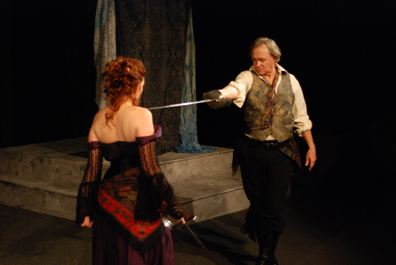
Uneasy allies: Jaime Morgan & Rick Kerr in “Zastrozzi” (photo by Rick Bunting)
his superiority over “ordinary” mortals, he is a captive of his own relentless need to exact revenge on one Verezzi, a man (now happily mad) whom Zastrozzi blames for the death of his mother. (Apparently, even super-villains are capable of filial love.) Veteran Rick Kerr plays the dastardly fellow with great relish and élan. His Zastrozzi is both an egotist and a narcissist. But he’s also a keen (if volatile) observer of human character, and his (admittedly slanted) observations on others’ motivations and behavior serve as a kind of running commentary on the human condition. As to his own tangled motivations, he says: “It is not an obsession. An obsession will sustain you for a lifetime… It is not greed or lust or fear. It is none of those things. It is worse… All those of a timid nature had better run and hide.” He’s a larger than life character, but Kerr keeps him grounded in reality and even imbues him with a degree of audience sympathies. Zastrozzi is of a philosophical bent, and he can truly to be said to possess a wicked sense of humor. In a scene worthy of Casanova, he psychologically ravishes a virgin (Andra Kelly’s delightfully prim, proper, and chirpy Julia) without ever actually touching her – a virtual seduction that’s at once sexy and very funny. For allies, Zastrozzi has the assassin Bernardo, whose instincts are simpler than his master’s but just as base, and the temptress Matilda, who uses puts both her sharp mind and shapely body to effective use in the fine art of seduction. She rightly sees herself as Zastrozzi’s equal. Matt Brankston, who strongly resembles film actor Alfred Molina, and the self-assured Jaime Morgan, are note-perfect in those roles. The same goes for Paul Kit’s work as the endlessly manic Verezzi (who is admonished by Julia to “stop talking like a frenzied poetic moron”). Verezzi has fled reality, finding a reckless sanctuary within the grandiose delusions of his own strange fantasies. (“Art has nothing to do with truth,” he proclaims.). Yet his ubiquitous smile, irrepressible energy, and easily bestowed passions are endlessly entertaining. He’s the mirror opposite of Zastrozzi — a fount of bright effusiveness to the other’s dark broodings. Between the pair, they have the market cornered on megalomania! And, John Lunman is just as engaging as the long-suffering Victor, the ex-priest who has been drafted into the thankless job of protecting Verezzi; in the process, he’s obliged not only to ‘suffer a fool’ (albeit far from gladly) but also to match wits (and rapiers!) with the deadly Zastrozzi. He is the voice of morality and reason that opposes the utter anarchy embodied by the villain. Costumes and sets are just right, nicely evoking late 19th century Italy without calling undue attention to themselves. And the six remarkable performances, combined with the script’s agility at turning from serious to darkly satirical to seductive from one moment to the next, make this production a must-see for area audiences. Be warned, however, that its subject matter and sexual references mean that it’s suitable only for adults.
© 2011 by John Arkelian.
“Zastrozzi” can be seen at the intimate Arts Resource Center, 45 Queen Street, Oshawa. Tickets are a bargain at $12, and performances take place on March 25-26 & 30-31, as well as April 1-2, 2011. See durhamshoestring.org.
******************************************************************
“A Christmas Carol” — Soulpepper’s Stage Production Reviewed
© By John Arkelian
“God bless us every one!”
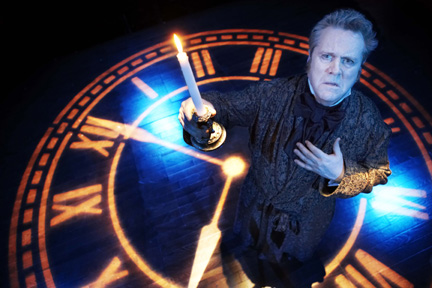
Like one of the ghostly apparitions who make up its dramatis personae, Charles Dickens’ “A Christmas Carol” returns each year not to haunt, but to delight us, as it has since the novella first appeared in 1843. For a story that’s steeped in the supernatural, it is actually a compellingly human story, about both the worst and best angels of our nature — one that is, in equal measure, a ghost story, morality play, character drama, celebration of the true spirit of Christmas, and ode to the hope of redemption. It is also a story that shows no signs of flagging after 167 years and a host of adaptations for the screen, television, radio, and stage. The best-known and best-loved (though by no means the first) of those must be 1951’s “Scrooge,” in which Alastair Sim defined the title role for the ages. An enduring classic, that film was rooted in pitch-perfect performances, direction, and art design — and just the right balance between the darkness and the light that struggle in every human soul. Other takes on Dickens’ story are as diverse as a 1970 British musical starring Albert Finney and Alec Guiness and a 1988 modern, broadly comedic retelling that featured Bill Murray.
Dickens’ tale never tires in the telling, and the current stage production by Toronto’s Soulpepper Theater Company makes another fine addition to the Christmas Carol canon. It’s the company’s fifth presentation of the play. The first three productions featured the late great Canadian actor Douglas Campbell. Since then, Soulpepper mainstay Joseph Ziegler has essayed the role and made it his own. Adapter and director Michael Shamala makes effective use of the Young Center’s theater in the round space, capturing the feel of the story’s Victorian times and its changing moods. The lighting is subdued, characters move through the encircling audience, and the spare sets are just enough to give a sense of time and place without stealing attention from the players. All those techniques, and the immediacy of the performances, create a sense of intimacy that draws us into the lives of these characters, as if the story enfolds around us without an invisible wall between audience and actors.
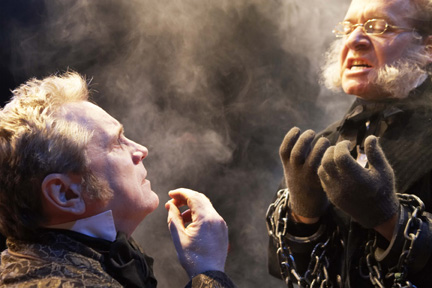
Joseph Ziegler (Scrooge) and John Jarvis (Marley) (photo by Sandy Nicholson).
In terms of dialogue, the play is closer in small details to the 1984 made for television movie with George C. Scott than the Alastair Sim version. Likewise, Ziegler’s Ebenezer Scrooge starts off somewhat less overtly misanthropically than Sim’s. He’s still miserly, miserable, and socially maladjusted, of course, but they’ve toned those characteristics down a notch or two for the stage. The result is a gentler arc for the characters than we’ve seen in some other adaptations. John Jarvis does triple duty as all three of the ghosts; the story’s youngsters (Ebenezer as a boy, his sister Fan, and the Cratchit children) are all played by younger children here than we’re accustomed to in other adaptations, while Oliver Dennis is a tad older as Bob Cratchit than we’ve seen elsewhere. But they, and the rest of the cast, acquit themselves very well. The festooning of garlands of ivy for the Fezziwigs’ office Christmas fete nicely captures the festive atmosphere of that occasion while giving characters something to do. The step ladder used effectively in that scene is a mite less compelling as a figurative vehicle for Scrooge’s travels through time and space. The production’s costume choices (including an Inverness caped coat that left this devotee of 19th century apparel feeling envious) create just the right atmosphere without distracting us from the players. In the end, it is their performances, and the intimacy of the setting and direction, that make Soulpepper’s production of “A Christmas Carol” a must for all ages!
“A Christmas Carol” runs through Thursday, December 30, 2010 at Toronto’s YoungCenter for the Performing Arts.
*********************************************************************
On June 27.10
“We Will Rock You”
Musical Theater Review
© by Adriana Pacheco
“We Will Rock You,” the smash musical by British author and comedian Ben Elton and the hit British rock band Queen, ended a run at the Panasonic Theatre in Toronto in May 2009. The show originated in London’s West End in May 2002 and made its way to Toronto in April 2007, where it thrilled theater-goers for two and a half years with an engaging, mostly Canadian, cast.
Based on the music of Queen, the musical takes place in a future in which musical instruments are banned and the music of rock-and-roll is unknown – having disappeared 300 years earlier. The only music allowed has a droning pop-like sound, similar to techno-music, and it is generated by a computer instead of actual people. The ‘Killer Queen,’ who is the official ruler of ‘Planet Mall,’ as Earth is now called, controls everything, and everyone must bend to her will or be sent to ‘the Seven Seas of Rye,’ which is really Las Vegas under a massive amount of water. The only people who dare to defy her are the ‘Bohemians,’ a rag-tag group of young people who have rebelled against the Killer Queen’s rule in search of real music and the musical instruments that are prophesied to bring back rock-and-roll. These rebels are forced to live underground and are all named after music artists of the past century, like Clay Akin, Ozzy Osborne, Aretha Franklin, and Hilary Duff. The Bohemians are looking for the ‘Chosen One,’ the individual who will find the instruments, bring rock-and-roll back, and end the Killer Queen’s reign.
The show is lively and engaging – and so funny that the audience laughed till it cried. Audience participation is encouraged by the actors coming into the audience and prompting them to get up, wave their hands, and sing and clap along to the final numbers of the show. The intimacy of the venue – with its physical closeness – made us feel that we were a part of what was going on. “We Will Rock You” has music and humor that appeals to all ages. Whether you like the music of Queen or not, it is definitely worth taking in this superb musical if it returns to Toronto.
Adriana Pacheco is a journalism student.

